Spike Protein Injuries and Treatments



ACCORDING TO CDC DATA, 8 percent (nearly 1 in 13) of U.S. adults have “post-COVID conditions,” whether or not they have had a COVID diagnosis. Nearly 1 in 5 have at some point experienced symp toms three months out from a COVID infection that weren’t present prior to infection .
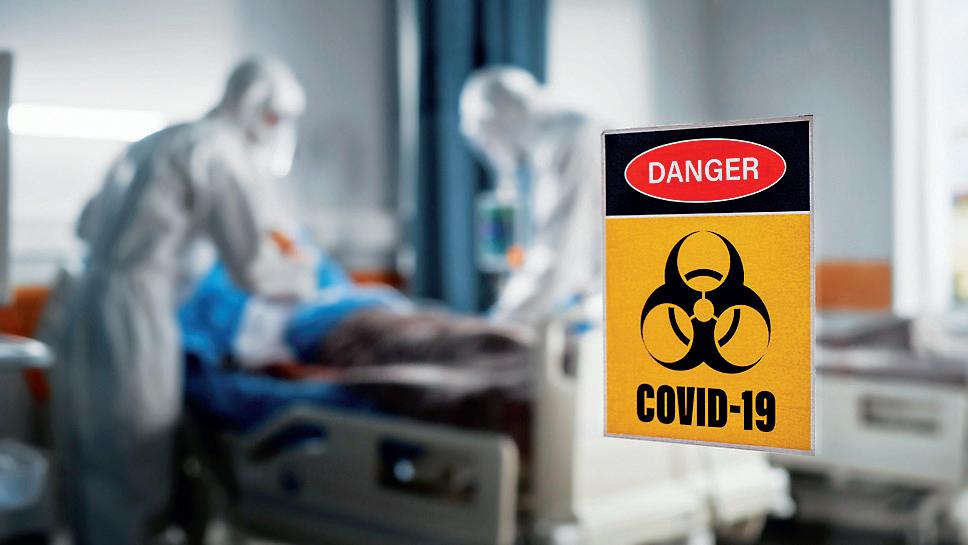
In 2021, the Department of Health and Human Services listed long COVID as a disability under Titles II (state and local government) and III (public accom modations) of the Americans with Disabilities Act. A study by Brookings estimated that about 4.5 million Americans with long COVID are out of work.

Symptoms and long-lasting syndromes arising after an acute COVID infection or after a COVID vac cine greatly overlap, according to clinician reports and studies. The science points to the SARS-CoV-2 spike protein, present in both infections and vacci nations, as the likely culprit.
Spike (S) glycoprotein (“spike protein”) is the largest of four main structural proteins of the SARS-CoV-2 virus. It’s the only protein responsible for mediating viral entry into the host cell, which is essential for the subsequent viral replication in the human body.
A number of studies indicate that spike proteins can damage human cell mitochondria, suppress the human immune system, form amyloid-like proteins, and cause abnormal blood clots and other issues.
In this special report by Epoch Insight, we look at the pathology of spike protein-induced injuries, discuss the treatments at the forefront of clinical care, and explore the data on lifestyle interventions shown to reverse the most common symptoms.
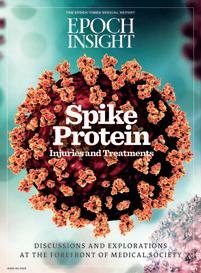
The presence of spike proteins has been strongly linked with long COVID and post-vaccine symptoms.
The Epoch Times is the fastestgrowing independent news media in America. We are nonpartisan and dedicated to truthful reporting. We are free from the influence of any government, corporation, or political party—this is what makes us different from other media organizations. Our goal is to bring our readers accurate information so they can form their own opinions about the most significant topics of our time.

We don’t follow the unhealthy trend of agenda-driven journalism prevalent in today’s media environment.
Instead, we use our principles of Truth and Tradition as our guiding light. We highlight in our reporting the best of humanity, the valuable lessons of history, and traditions that are beneficial for society.
FROM
10
Where spike protein has been found after infections or injections.
Spike proteins disrupt DNA selfrepair and gene expression.
DNA has amazing properties that promise hope and healing.
COVID blood clots are the first domino down in a cascade of symptoms.
The injuries may not be apparent until hormonal “reserves” are depleted.
32
Intermittent fasting can help kick-start cellular cleanup.

Treatment options include ivermectin, resveratrol, low-dose naltrexone, and others.
44
When the go-to options fail, doctors get resourceful.
48
Hyperbaric oxygen therapy is a rare avenue of treatment.
52 | Long COVID
Why can COVID last for months, or even years?
54 | Risk Factors
Six main factors seem to raise the risk of vaccine injury.
56 | Brain Fog
Common symptoms tend to be neurological and psychiatric.
Good music resonates with the body in a helpful way.
62 | Inner Peace
Meditation and compassion have profound healing effects.
66
Nature, sunshine, and proper sleep cycles do wonders.
68 | Food as Medicine
Nature is rich in its ability to cure.
70 | Immunity 101
An introduction to our sophisticated, multilayered defense system.
The presence of spike protein is strongly linked with a cascade of symptoms.
The spike proteins (or S proteins) have proven to be toxic and
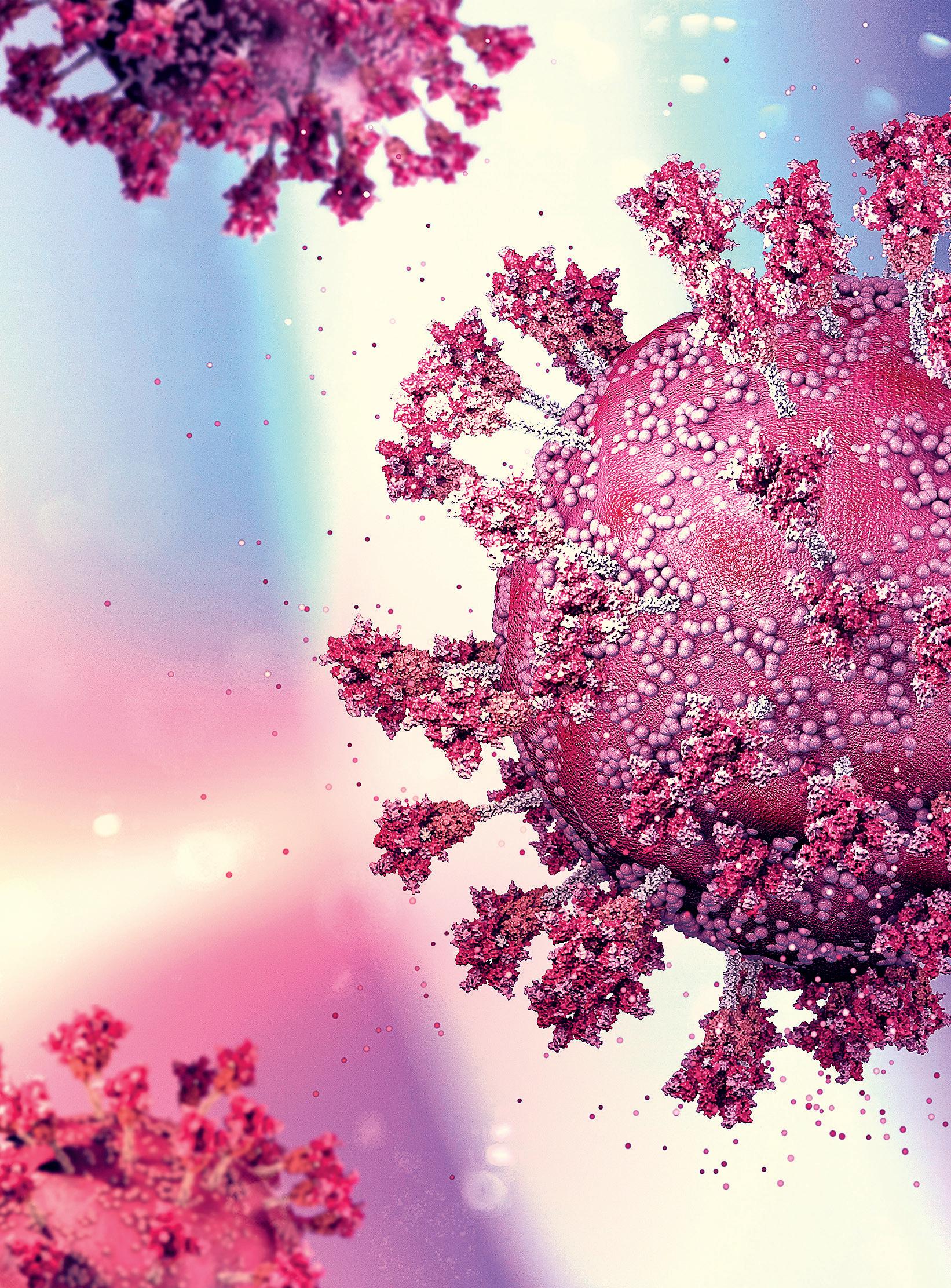
of the SARS-CoV-2 virus and inflammatory


The number of people affected continues to climb
By Marina ZhangMultiple studies have shown that the SARS-CoV-2 spike pro tein is a highly toxic and inflammatory protein, capable of causing pathologies in its hosts.
The presence of spike protein has been strongly linked with long COVID and post-vaccine symptoms. Studies have shown that spike proteins are of ten present in symptomatic patients, sometimes even months after infec tions or vaccinations.
The numbers of long COVID and post-vaccine cases have been climb ing in the United States, increasingly posing as a health care problem.
Data from the Centers for Disease Control and Prevention estimates that about 7 percent of Americans are currently experiencing long COVID symptoms, which would be more than 15 million people. Some people with long COVID have been so debilitated that they can’t go to work; the same has been reported in people experiencing post-vaccine symptoms.
More than 1.4 million reports have been made to the Vaccine Adverse Event Reporting System for possible postCOVID vaccine symptoms as of Nov. 9.
Long COVID and post-vaccine syn drome share a high degree of overlap as the two conditions have both been linked to long-term spike protein pres ence, and the symptoms are often sim ilar as well.
“The core problem in post-vaccine syndrome is chronic ‘immune dysreg ulation,’” said Dr. Paul Marik, co-found er and chief scientific officer of Front Line COVID-19 Critical Care Alliance, a physician group dedicated to treating COVID-19.
Spike proteins can cause chronic in flammation. Studies have shown that inflammation can lead to cell stress,
damage, and even death. There fore, spike protein injuries are a systemic syndrome.
Spike proteins trigger chron ic inflammation by causing immune dysregulation. They enter immune cells, switch off normal immune responses, and trigger pro-inflammatory path ways instead.
The normal immune response for infected immune cells is to release type 1 interferons; this gives signals to other immune cells to enhance defense against viral particles. But spike protein reduces this signaling in infect ed cells, and uninfected cells will also take in and become damaged by the spike protein as the infection gets out of control.
Marik said a critical aspect of longterm spike protein damage is that it inhibits autophagy, your body’s way of recycling damaged cells. Usually, when cells have been infected with viral parti cles, the cells will try to break these par ticles down and remove them as waste.
However, studies on SARS-CoV-2 vi ruses have shown that autophagy pro cesses are reduced in infected patients, with spike proteins present many months after the initial exposure.
“The spike protein is a really wicked protein,” Marik said. “It switches off autophagy, that’s why the spike can stay in the cells for such a long time.”
The immune dysfunction caused by spike proteins not only causes inflam mation but also may contribute to can cer proliferation and autoimmunity.
Studies have shown that spike pro teins can reduce and exhaust the action of T and natural killer cells. These two cell types are responsible for killing in fected cells and cancerous cells. There fore, a reduced cellular immunity from T and natural killer cells can contribute
to an untimely clearance of spike-in fected cells.
Damage from spike proteins can lead to damaged DNA, and studies have shown that spike proteins can also re duce DNA repair. Psychological and en vironmental stress, such as ultraviolet light, pollutants, oxidants, and many other factors, can routinely damage DNA, requiring constant repair.
Damaged DNA puts cells at risk of becoming cancerous, and these cells should be killed to prevent cancer for mation. However, with reduced T and natural killer cell activity, this may lead to unchecked proliferation of potential ly cancerous cells.
Other dysfunctions that have been re ported following vaccinations include autoimmune diseases.
These diseases may be linked to the spike proteins having a high level of molecular mimicry, meaning spike proteins have many regions similar to other proteins in the human body.
So when the immune system attacks the spike protein, due to structural similarities, the antibodies produced against spike protein regions may also react against the body’s own proteins and tissues. Studies have shown that antibodies made against the spike protein can also bind to and attack self tissues.
The spike protein is also linked with dysfunction in the mitochondria. Col loquially known as the powerhouse of the cell, mitochondria are responsible for harnessing energy from the sugar we ingest.
Human neural cells treated with spike protein have been shown to pro
Other Damage
The first thing that the spike protein does is block autoph agy This prevents infected cells from clearing out and dispelling the spike proteins, leading to many of the down stream problems. Therefore, a major focus of the first-line treatment is to reactivate autophagy and clear out the spike proteins hidden away in the affected cells.
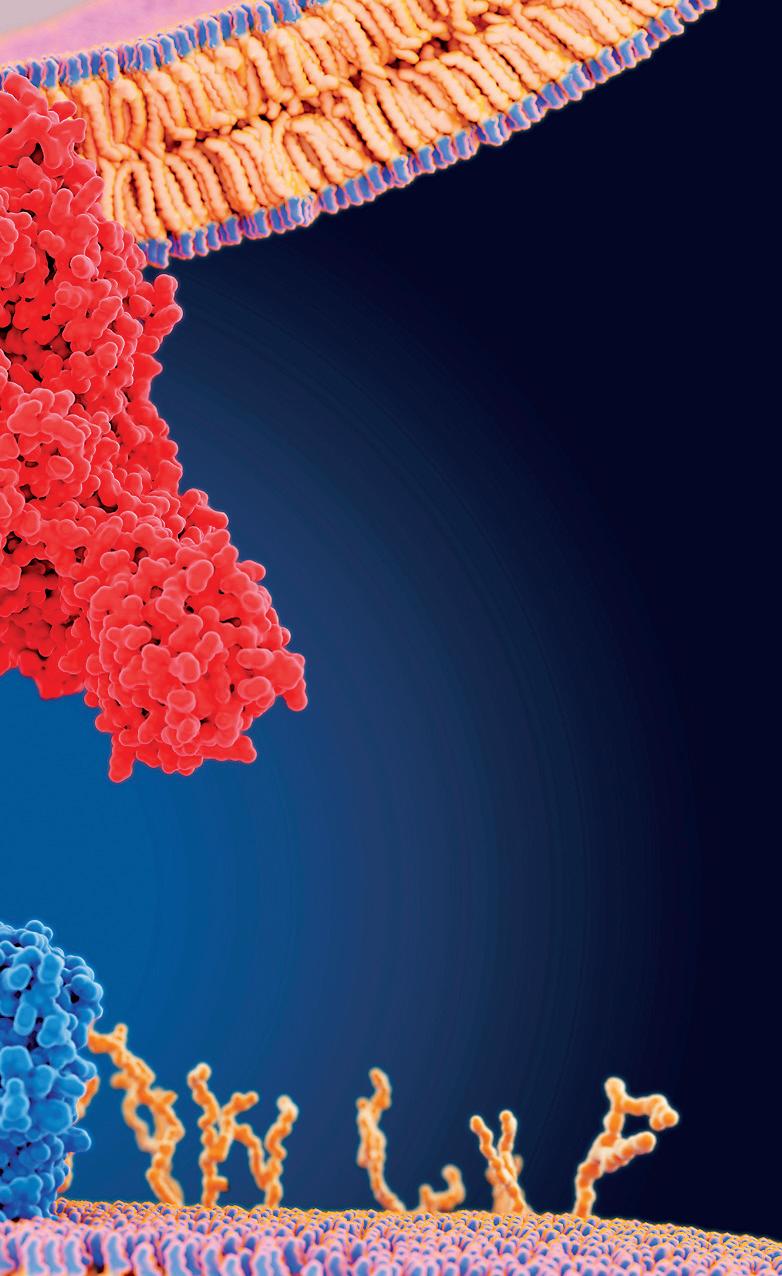
DYSFUNCTION: In cells, spike proteins cause mitochon drial dysfunction by directly affecting the mitochondria or causing stress to its
duce more reactive oxygen species, and this is an indication of mitochondrial dysfunction, suggesting a possible re duction in energy production.
People with long COVID and post-vac cine syndromes often experience chronic fatigue, brain fog, exercise in tolerance, and muscle weakness. These symptoms are also often seen in people with mitochondrial dysfunction, indi cating a possible link.
Spike proteins have shown to be par ticularly damaging to cells that line blood vessels. Spike proteins can bind to ACE2 and CD147 receptors and trigger inflammatory pathways.
environment. Mitochondrial dysregulation reduces energy production for the cell and can also result in the produc tion of damaging oxidative species, both of which can lead to cell stress, fatigue, and cell death.
Spike proteins also down regulate immune cells, with studies showing dysregula tion in T cells and innate cell responses. A fall in immu nity often correlates with opportunistic infections and viral reactivation, with many studies reporting a relapse of latent viruses following vaccination or infection.
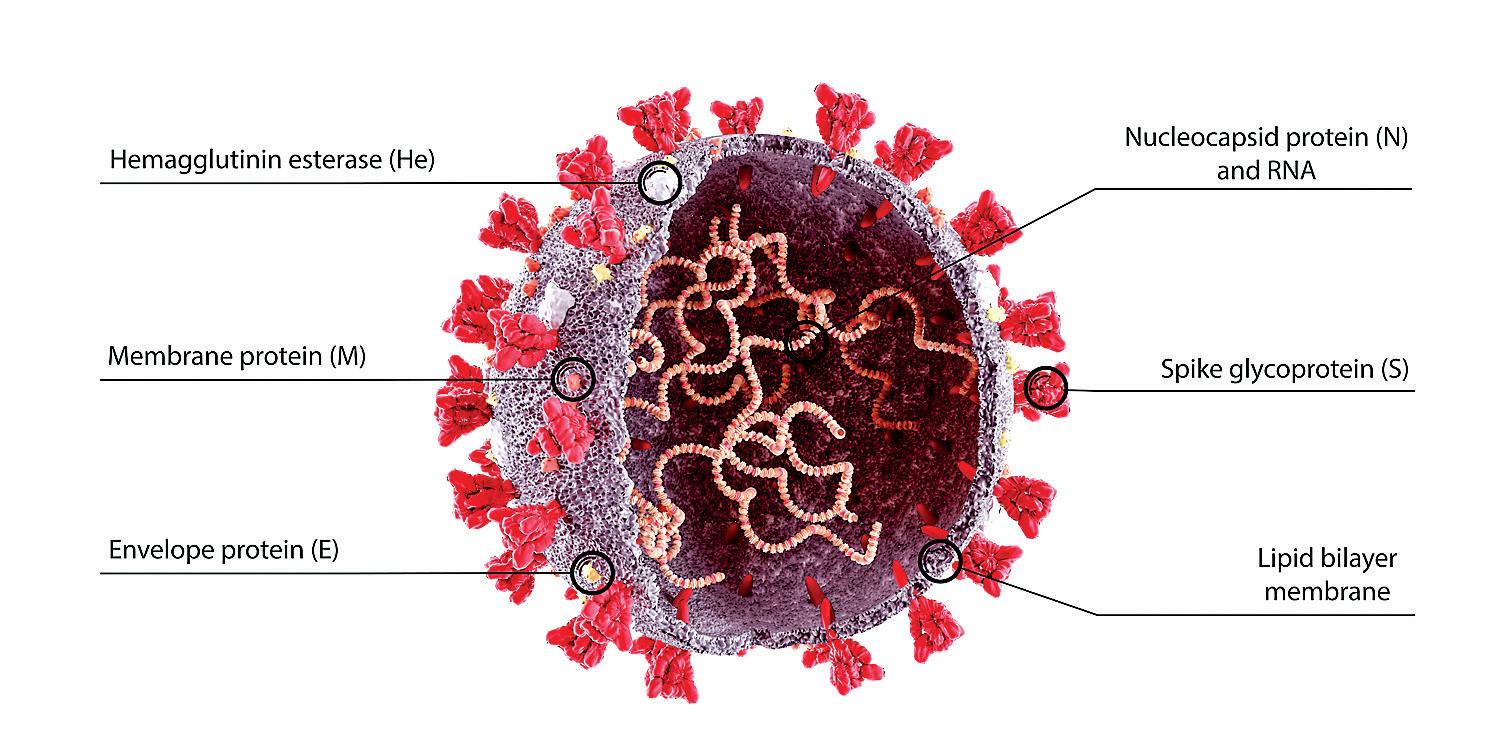
MAST CELL RESPONSE:
These receptors are particularly abundant in cells of the blood vessels, heart, immune system, ovaries, and many other areas. Spike proteins can therefore trigger inflammation and damage in blood vessels and their re lated organs, leading to systemic injury.
Marik said that spike protein injury is closer to a systemic syndrome than a disease.
“It’s not a disease. It doesn’t fit the traditional model of a disease. This is a syndrome which affects every single organ. ... The spike goes everywhere ... so this is a multi-systems disease, and it doesn’t follow the traditional paradigm of a disease, which is one symptom, one diagnosis,” he said.
Spike proteins can trigger the activation of mast cells. These immune cells play ma jor roles in allergic responses by releasing histamine. Histamine release contrib utes to inflammation, with patients presenting with symptoms of fever, head aches, swelling, and many other debilitating conditions.
BLOOD CLOT FORMATION:
Studies found that in the bloodstream, spike proteins can bind to blood-clotting pro teins such as fibrinogen and form abnormal blood clots. Apart from inflammation, these blood clots can lead to blood vessel blockage and
tissue damage, precipitating to strokes and heart attacks.
CANCER: Studies found that cells exposed to the spike proteins through viral genes or protein exposure would in crease DNA damage markers, indicative of DNA damage. This can lead to dysfunction al, potentially cancerous cells if these cells aren’t killed by the immune system.
Spike proteins also share many similarities with hu man proteins and tissues, so antibodies that attack spike proteins may also bind to human tissues and proteins, leading to self-attack











































Found 9–180 days after recovery




Found in blood 1 month after vaccination
























Note: The times listed for spike protein presence in different organs are based on specific and separate studies, and may not be comprehensive or comparable between times listed.
Adrenal tropism of SARS-CoV-2 and adrenal findings in a post-mortem case series of patients with severe fatal COVID-19, Nature Communications; Pfizer SARS-CoV-2 mRNA Vaccine (BNT162, PF-07302048) pharmacokinetic study; Presumed SARS-CoV-2 Viral Particles in the Human Retina of Patients With COVID-19, JAMA Ophthalmology; Retinal findings in patients with COVID-19: Results from the SERPICO-19 study, Lancet Discovery Science; COVID 19 chilblain like lesion: immunohistochemical demonstration of SARS CoV 2 spike protein in blood vessel endothelium and sweat gland epithelium in a polymerase chain reaction negative patient, Oxford University Press; SARS-CoV-2 spike protein is present in both endothelial and eccrine cells of a chilblain-like skin lesion, Journal of the European Academy of Dermatology & Venereology; Post-COVID-19 menstrual abnormalities and infertility: Repercussions of the pandemic, Journal of Education and Health Promotion; COVID-19 and the surge in Decidual Cast Shedding, The Gazette of Medical Sciences;
SARS-CoV-2 Infection of Human Ovarian Cells: A Potential Negative Impact on Female Fertility, Cells; Coronavirus: Why Men are More Vulnerable to Covid-19 Than Women?, Nature Public Health Emergency Collection; SARS-CoV-2 infects, replicates, elevates angiotensin II and activates immune cells in human testes, pre-print; Pathological and molecular examinations of postmortem testis biopsies reveal SARS-CoV-2 infection in the testis and spermatogenesis damage in COVID-19 patients, Cellular Molecular Immunology; Semen impairment and occurrence of SARS-CoV-2 virus in semen after recovery from COVID-19, Oxford university Press; CDC Dispatch SARS-CoV-2 RNA Shedding in Semen and Oligozoospermia of Patient with Severe Coronavirus Disease 11 Weeks after Infection; Covid-19 vaccination BNT162b2 temporarily impairs semen concentration and total motile count among semen donors, Andrology; Effects of COVID-19 vaccine on semen parameters, Nature Reviews







Persistence of SARS CoV-2 S1 Protein in CD16+ Monocytes in Post-Acute Sequelae of COVID-19 (PASC) up to 15 Months Post-Infection, Frontiers in Immunology; Cell death and pathological findings of the spleen in COVID-19 patients, Elsevier Public Health Emergency Collection; The SARS-CoV-2 Spike protein disrupts human cardiac pericytes function through CD147 receptor-mediated signalling: a potential non-infective mechanism of COVID-19 microvascular disease, Clinical Science; The central role of the nasal microenvironment in the transmission, modulation, and clinical progression of SARS-CoV-2 infection, Mucosal Immunology; Mucosal Immunology, Nat Med.; Oral SARS-CoV-2 Inoculation Causes Nasal Viral Infection Leading to Olfactory Bulb Infection: An Experimental Study, Frontiers in Celluar and Infection Microbiology; Evidence of SARS-CoV-2 in nasal brushings and olfactory mucosa biopsies of COVID-19 patients, PLOS ONE; SARS-CoV-2 infection of the oral cavity and saliva, Nature Medicine; Circulating SARS-CoV-2 Vaccine Antigen Detected in the Plasma of mRNA-1273 Vaccine Recipients, Oxford University Press; SARS-CoV-2 infects adipose tissue in a fat depotand viral lineage-dependent manner, Nature Communications; The spike protein of SARS-CoV-2 induces endothelial inflammation through integrin α 5 β 1 and NF -κ B signaling, Journal of Biological Chemistry; The S1 protein of SARS-CoV-2 crosses the blood–brain barrier in mice, Nature Neuroscience SARS-CoV-2 S1 Protein Induces Endolysosome Dysfunction and Neuritic Dystrophy, Frontiers in Cellular
Neuroscience; SARS-CoV-2 spike protein causes cardiovascular disease independent of viral infection, Clinical Science; Detection of Sars-Cov-2 antigens in thyroid gland showing histopathological features of subacute thyroiditis, European Thyroid Journal; Covid vaccine induced subacute thyroiditis, Organizacao Mundial da Saude; SARS-CoV-2 in the pancreas and the impaired islet function in COVID-19 patients, Emerging Microbes & Infections; CDC Morbidity and Mortality Weekly Report; Nephrotic Syndrome After Vaccination Against COVID-19: Three New Cases From Germany, Dtsch Arztebl; Evidence for SARS-CoV-2 Spike Protein in the Urine of COVID-19 Patients, Kidney360; COVID-19 targets human adrenal glands, Elsevier Public Health Emergency Collection;
The protein, though difficult to test for, has been found in several organs months after exposure
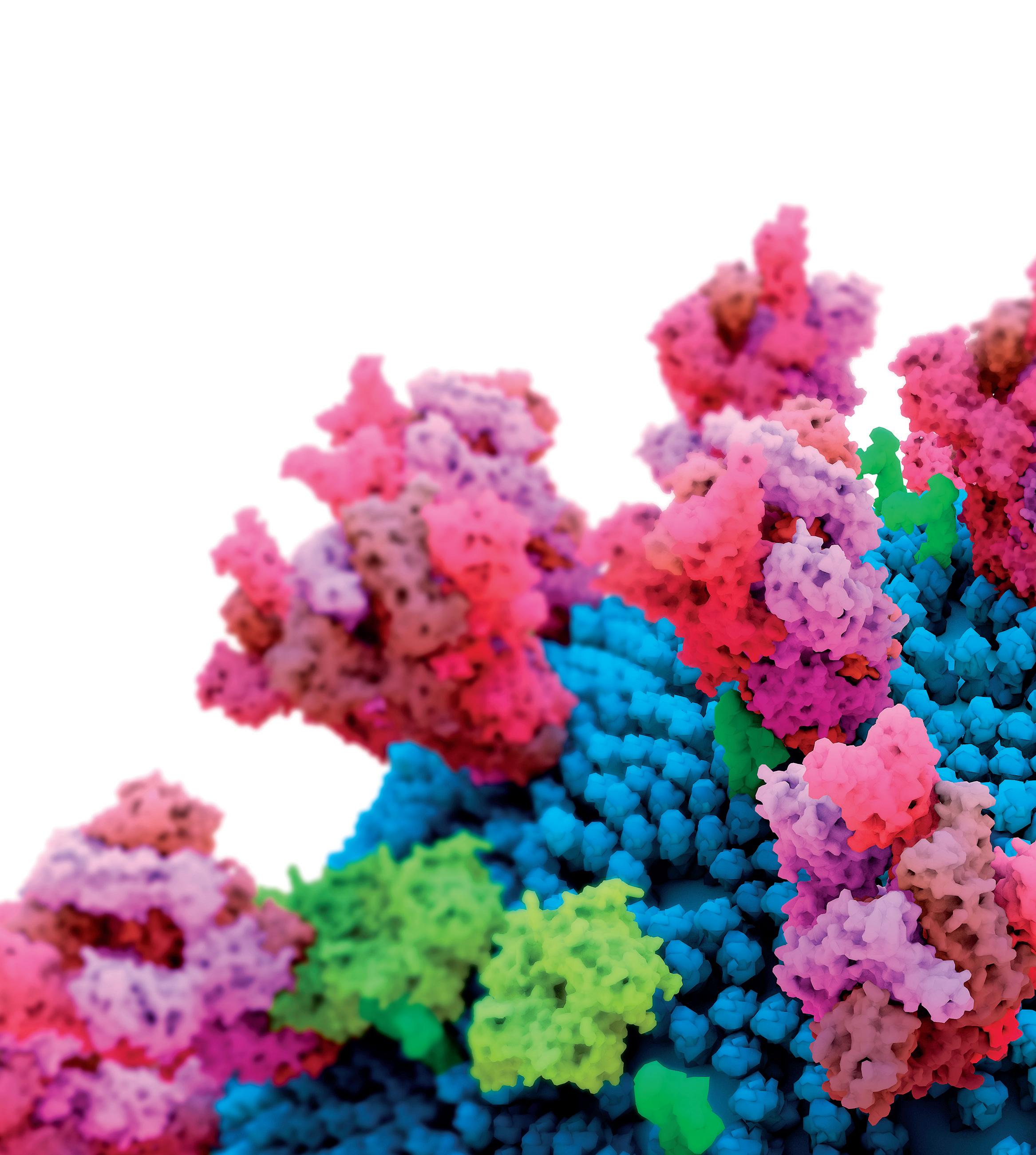
An illustration of SARS-CoV-2 virus with spike proteins that mediate the entry of the virus into a host cell.
 PHOTO BY DESIGN_ CELLS/SHUTTERSTOCK
PHOTO BY DESIGN_ CELLS/SHUTTERSTOCK
The lungs are a major site of injury following COVID-19 infection and are believed to be a highly susceptible organ.

Many doctors now blame the myriad of debilitating condi tions reported after COVID-19 infections and vaccinations on the spike pro teins present both in the virus and after vaccination. Emerging research has found spike proteins present in various organs, and they’re often im plicated in inflammation and damage of surrounding tissues.
Although there’s research on the mechanisms of the spike proteins and hypotheses on how the proteins may interact with various aspects of the body, spike protein presence is diffi cult to test for.
This article aims to review the cur rent limited research on spike protein accumulation through both infection and vaccine exposure, the places it can contact, and the pathologies it may lead to.
teins present in immune cells during infection or after vaccination.
However, in a study led by Dr. Bruce Patterson, CEO and founder of Incel lDx, a company that diagnoses long COVID using blood tests, of patients who suffered from long COVID for more than 15 months, 73 percent of them still had spike proteins present in their immune cells. Meanwhile, 91 percent of patients with severe and acute COVID-19 had spike proteins in their immune cells.
Another study evaluating organ tis sues obtained through autopsy found spike proteins present in the immune cells of individuals who died from COVID-19. Some of these immune cells died and had signs that they were trying to remove or recycle cellular materials; these all suggest a general toxicity from the spike proteins.
Arne Burkhardt, found spike proteins in the lung cells of a living person nine months after vaccination, with immune cells nearby, suggestive of possible immune action.
Studies on autopsy samples from people who had been infected found severe inflammation in the lungs; spike protein presence in cells; great immune presence, often accompanied by small er areas for gas exchange; scarring; and thickening of the lung tissues.
Spike proteins often have been de tected in immune cells taken from people who have been infected with COVID-19. A number of immune cells will periodically sample the environ ment around them, and it therefore wouldn’t be unusual to find spike pro
The lungs are a major site of injury fol lowing COVID-19 infection and are be lieved to be a highly susceptible organ.
A study on autopsy samples from people who died several days or months following COVID-19 vaccination found a strong spike protein presence in the lung cells of these individuals. The team, led by German pathologist Dr.
Studies have shown that the SARSCoV-2 virus likely infects through the nasal and oral cavities.
Positive COVID-19 tests often swab the nasal or oral cavities for viral RNA or viral particles. SARS-CoV-2 viruses have been detected in samples of nasal cells by swabbing the area.
An autopsy study on 18 patients who died after COVID-19 infection found spike proteins in their salivary glands. The authors found spike proteins from the virus in both the cells of the glands and the saliva. They also found spike protein presence with inflammation and immune cell presence, swelling in the salivary glands, and scarring, all indicative of possible spike-protein-in duced damage.
Connective tissue includes blood, bone, and fat. Spike proteins have been found across all three areas. A 2021 study found that spike proteins could re main in the blood for up to 30 days after vaccination. These spike proteins, therefore, pose risks for endothelial cells that line the blood vessels and also present a risk of blood clots because of the spike proteins’ capability to bind to blood clotting proteins.
Staining in people who died from COVID-19 also detected a SARS-CoV-2 viral protein presence in bone marrow.
A study on autopsy samples taken
from the chest region of 47 people who died following COVID-19 infection found spike proteins distributed with in fat cells; fat cells also regulate the body’s metabolism, and dysfunction of fat cells can lead to metabolic diseases, including inflammation and diabetes.
and result in the neurons wasting away.
Burkhardt’s autopsy study on vac cinated individuals found that spike proteins were found in the biopsies of many brain blood vessels. Spike pro teins were also detected in the neurons, although at a lower rate.
for the secretion of hormones. SARSCoV-2 nucleocapsid proteins were also detected but were more sparse in their distribution. The presence of spike pro teins also came with inflammation and cell damage, looking similar to thyroiditis, according to the study. In flammation of the thyroid may affect thyroid function leading to dysfunc tion of the organ.
Endothelial cells are abundant in the body, most particularly in the inner linings of blood vessels. They’re also very vulnerable to SARS-CoV-2 viral infection and spike protein interaction, since endothelial cells have many re ceptors that the spike proteins can bind to, triggering immune attacks against the cells that line our blood vessels.
Studies on human blood vessel en dothelial cells show that exposure to spike proteins caused inflammatory cells to stick to endothelial cells, indic ative of an immune attack, which may also lead to cell damage or even death from inflammation.
Burkhardt’s team on vaccinated in dividuals found a strong spike protein presence in the endothelial cells that line the inner layers of blood vessels in the brain, heart, lungs, and spleen.
This would also be accompanied by an immune attack in the surround ing environment. The team found damaged blood vessels, especially in small capillaries surrounded by in flammatory immune cells, suggestive of spike-protein-induced injury. This puts all of the internal organs at risk, as all internal organs are supplied with blood vessels.
The heart is prone to spike-protein-in duced injuries. Myocarditis, which is inflammation of the heart muscles, is a major adverse event following COVID-19 vaccination.
Burkhardt’s team found spike pro teins in the heart muscles of deceased vaccinated individuals, with signs of inflammation and immune cell activity, possibly indicative of myocarditis.
However, spike proteins were also found in the coronary arteries and in the aorta, the largest blood vessel in the body. These findings were all accom panied by immune cell presence and severe signs of inflammation and tissue damage, implying possible heart injury.
Another laboratory study shows that the spike proteins by themselves could cause heart damage. The human tis sue cells were infected with the SARSCoV-2 virus, and the study found that the spike proteins from the virus could bind to cardiac pericytes. These are cells that support blood vessel cells and control the constriction and dilation of blood vessels. When spike proteins attached to pericytes, pericytes became more motile and less supportive of the blood vessel cells. They also secreted pro-inflammatory molecules and chemicals that triggered blood vessel cells to die. These findings all suggest that cardiac damage can occur with spike protein presence alone.
Thyroiditis has also been report ed in people three to four days after COVID-19 vaccinations, with some researchers declaring the thyroiditis to be vaccine induced.
Although the SARS-CoV-2 virus isn’t able to cross into the brain through the blood-brain barrier, studies in mice show that the spike protein by itself is able to cross it.
Studies on human neural cell cul tures also found that the spike proteins could enter the cells and cause dysfunc tion to protein clearance of the neurons
An autopsy study on a man who died following COVID-19 infection found spike proteins present in his thyroid biopsies. The thyroid is responsible
A Chinese study found spike proteins in autopsy pancreas samples from people who died from COVID-19.
Spike proteins were found in two common pancreas cells: One produces and secretes enzymes that break down food, while the other one produces and releases insulin to lower our blood sugar levels. The second type includes pancreatic beta cells, which are often implicated in metabolic diseases such as diabetes; the loss of beta cells leads to Type 1 diabetes, while a failure of the body to respond to insulin is a charac teristic of Type 2 diabetes.
In infected individuals, in whom spike proteins were present, their pancreatic tissues had signs of cellu lar damage. The membranes that con tain pancreatic cells were damaged and the content inside of the cells was swollen and disintegrated. These cells also had fewer enzymes and insulin packaged for release, suggestive of a possible decline in digestion and blood sugar regulation.
The authors found that the pancre atic beta cells especially had markers present that would normally be found in diabetes or other metabolic diseas es, which may indicate that the SARSCoV-2 virus or its spike proteins can contribute to metabolic dysfunctions.
Metabolic diseases have been asso ciated with COVID-19 infections and vaccinations; the change in the mark ers of the pancreatic beta cells may be why many COVID-19 patients have ab normal sugar levels, even if they have no underlying metabolic disease.
A health worker administers a dose of the Sinopharm COVID-19 vaccine to a nurse at Jari Village Clinic in Zvimba Rural District, Zimbabwe, on Feb. 23, 2021.

samples from hospitalized COVID-19 patients. Since proteins are larger than other commonly excreted chemicals— such as urea and sodium ion—there are generally low amounts of proteins in the urine, with higher levels (proteinuria) be ing seen as a sign of kidney dysfunction. Proteinuria and nephrotic syndrome, both identified with excessive protein excretion in the urine and associated with dysfunctional kidney performance, have been documented during COVID-19 infection and after vaccination.
Spike proteins were detected in the liver in five recovered COVID-19 pa tients. The patients had reported negative SARS-CoV-2 results for 9 to 180 days, suggesting a recovery. There were also spike proteins present in the gallbladder.
Another autopsy study on 11 indi viduals who died after COVID-19 in fection found two who tested positive for SARS-CoV-2; however, all had signs of fatty liver, and some also present ed with scarring and inflammation, possibly suggesting liver damage from spike proteins.
The kidneys are responsible for filter ing out waste and water from the blood for excretion as urine.
An autopsy study on 21 COVID-19 patients detected one deceased per son who was positive for SARS-CoV-2 proteins in their kidneys. Although the other patients didn’t test positive for the virus, all shared similar pathologies with dysfunction in circulation, with congestion in the vessels being respon sible for filtration and signs of injury and widening of kidney compartments.
Another study detected spike proteins in urine in about 25 percent of urinary
In a study of five recovered COVID-19 patients ranging from 9 to 180 days af ter testing negative for the virus, the authors found spike proteins and nu cleocapsid proteins in the ileum (the end of the small intestines), appendix, colon, and hemorrhoid tissue.
Another autopsy evaluation on 11 peo ple who died after contracting COVID-19 found that two individuals who tested positive for SARS-CoV-2 had spike pro teins in their gut tracts.
Endothelial cells are abundant in the body, most particularly in the inner linings of blood vessels. They are also very vulnerable to SARS-CoV-2 viral infection and spike protein interaction.
The adrenal glands are often targeted in bacterial and viral infections.
Two studies on autopsies from COVID-19 patients found spike pro teins localized in the adrenocortical areas of the patient. The presence of spike proteins was also accompa nied by inflammation of the adrenal glands, tissue death, blood clotting, and many other dysfunctions. Since adrenocortical cells are responsible for secreting hormones, damage to these regions is speculated to elevate the risk of adrenal insufficiency in the future.
A paper on COVID-19 vaccines also found that the vaccines favored the adrenal glands for spike protein production, with spike protein RNA and spike proteins found in adrenal tissues.
At least two case studies have detected SARS-CoV-2 viruses in skin and sweat gland tissues after COVID-19 infection. These people often have skin discolor ation at the site of infection; laboratory examination of the skin tissue showed inflammation and reddening of the tissues infected.
Burkhardt’s team found spike proteins in deltoid muscles in deceased vaccinat ed individuals from an autopsy study; there were also immune cells at the site, suggestive of possible infection. They also found spike proteins in the lower leg muscle cells.
and had signs of inflammation, damage, and degeneration. These findings cor relate to testes damage and potential impairment of spermatogenesis with spike protein presence.
Studies have detected the SARSCoV-2 virus and its viral RNA in sperm following infections. These are often associated with reduced sperm count and motility, suggesting that the infec tion impairs spermatogenesis. Studies on vaccinated individuals also had sim ilar findings, all of which suggest that the spike proteins by themselves may be able to impair sperm production.
• Fatigue
• Memory problems
• Dyspnea (difficulty breathing)
• Sleep problems
• Joint pain
• Concentration/confusion/brain fog
• Problems with sense of taste
• Anxiety
• Joint pain
Burkhardt’s team found spike pro teins in biopsies of the spleens from deceased vaccinated individuals; these spike proteins were present in the blood vessels of the spleen.
Another study evaluating spleen tissue obtained through autopsies from COVID-19 patients found spike proteins in spleen cells and immune cells present in the spleen. The au thors found that infected individu als had greater signs of damage and tissue death in their spleen samples, suggestive of spike-protein-induced spleen injury.
Spike proteins were found during the autopsies of three individuals who died from COVID-19 in the inner lay er of the retina, inside retinal cells, and the blood vessels that supply the retina. COVID-19 infections have been found to be associated with increased widening of blood vessels in the ret ina, leading to possible impairment in eyesight.
Reproduction abnormalities rarely have been reported following COVID-19 vac cinations, although changes in men struation have been readily recorded in women who are vaccinated or even in women who came into contact with vaccinated individuals.
An Italian in vitro study exposed cul tured human granulosa and cumulus cells to the SARS-CoV-2 virus at 24-, 48-, and 72-hour intervals. The authors found viral infection in all of the cultures. The virus infected the ovarian cells. Howev er, studies on COVID-19 infections have shown that women are generally less affected by COVID-19 infections com pared to men.
• Cough
• Hair loss
• Depression
• Problems with sense of smell
• Myalgia (muscle aches and pains)
• Tachycardia
• Chest pain
• Dizziness
• Headache
• Abdominal pain
• Appetite
• Diarrhea
• Sore throat
• Fever
SOURCE: GLOBAL PREVALENCE OF POST-CORONAVIRUS DISEASE 2019 (COVID-19) CONDITION OR LONG COVID: A META-ANALYSIS AND SYSTEMATIC REVIEW, FROM THE JOURNAL OF INFECTIOUS DISEASES.
Spike protein injury treatments mainly fall under six categories:
• Deactivating and expelling spike protein
Testes seem to be especially targeted by SARS-CoV-2. A preprint study found that the testes, the place of sperm produc tion, are a reservoir for viral replication. This may pose a risk to sperm produc tion for the individual.
A Chinese study found spike proteins in the testes of five people who died after contracting COVID-19. The tissues affect ed are responsible for spermatogenesis
• Downregulating and blocking inflammation
• Treating microclots/ anticoagulation
• Treating mast cell activation syndrome
• Treating viral persistence/ reactivation
• Mitochondrial recovery
SOURCE: FRONTLINE COVID-19 CRITICAL CARE ALLIANCE
DNA’s self-repairing mechanisms act as the ‘guardians of our genes.’ Spike proteins disrupt them.
By Dr. Yuhong DongIn a study published in 2021 in the Journal of Leukocyte Bi ology, researchers analyzed ge nome-wide DNA methylation profiles of peripheral blood from nine terminally ill COVID-19 patients.
Our DNA is made up of a sequence of many genes. Methyl groups (that is, epigenetic factors) are clusters of hydrocarbons that attach to strands of DNA in a biological process called DNA methylation. The process reg ulates gene expression, as methyl groups act as signals along the DNA, turning genetic activities on and off. Therefore, DNA methylation can change the expression level of a DNA segment without changing its sequence.
Although virtually all cells in an organism contain the same genetic codes (DNA sequences), they don’t ex press their genes simultaneously or in the same way, so they have totally different functions. That is, the same DNA creates different types of cells, such as liver cells, kidney cells, and nerve cells, through the direction of epigenetic factors.
Epigenetic factors that bind to DNA can directly “turn on” or “turn off” genes. When the genes are “turned on,” they can be expressed and read by the body. Otherwise, they’re “turned off” and can’t be read by the body.

Metaphorically, methyl groups are attached to the DNA like “sticky notes.” DNA can be thought of as a script, which can be amended by put ting on (or taking off) some sticky notes over its text.
The Journal of Leukocyte Biology study results suggest that the SARS-
CoV-2 virus can dramatically reshape peripheral blood and lung tissue host immune cell landscapes and may modify cellular DNA methylation states. SARS-CoV-2 can possibly alter other epigenetic mechanisms, such as histone modifications and non coding RNA.
The researchers discovered a dis tinct DNA methylation signature of severe COVID-19 that showed dramat ic cell-type composition changes, hy permethylation of IFN-related genes, and hypomethylation of inflamma tory genes.
Interferons (IFN) are so named be cause they “interfere” with viruses and prevent them from multiply ing. They’re proteins that inform our immune system that germs or abnormal cells (such as cancer cells) are present in our body and trigger killer immune cells to destroy them.
Blanco-Melo et al. examined the transcriptional response to SARSCoV-2 within in vitro infected cells, infected ferrets, and post-mortem lung samples from lethal COVID-19 patients and reported that IFN-I and -III responses are attenuated.
In addition to the level of expres sion of IFN-I, the timing of the IFN-I response is also a critical factor in determining the outcomes of infec tion. An early and potent cellular IFN response is vital for the antiviral re sponse, whereas a delayed IFN-I re sponse contributes to pathological inflammation and severe outcomes.
Accordingly, a timely early switch “on” of IFN-related genes is a critical factor for the human body to over come the virus invasion and min imize the severe outcomes of the disease.
A research paper published in October 2021 in the journal Viruses states that the SARS-CoV-2 virus’s spike proteins can impair the body’s DNA damage-re pair mechanism. The researchers also were surprised to find an abundance of spike proteins in the cell nuclei.
It’s well-known that only certain
off.
DNA non-homo logous end joining (NHEJ) e ciency
types of proteins can possibly be trans ported into a human cell nucleus, such as histones, DNA and RNA polymeras es, and gene regulatory proteins. The nuclear envelope encloses the DNA by double membranes, and there are complex gatekeepers present in the nu clear membranes to prevent the entry of unwanted substances into the cell
DNA non-homo logous end joining (NHEJ) e ciency
DNA homologous recombination (HR) e ciency
methyl groups act as signals along the DNA,
nucleus, where most DNA repair occurs.
When DNA is replicating itself, po tential errors can be made. Howev er, fortunately, we have innate DNA self-repairing mechanisms, which act as “guardians of our genes.”
To their surprise once again, the study’s researchers discovered that spike proteins significantly suppressed the DNA self-repairing mechanisms, including homologous recombination (HR) and non-homol ogous end joining (NHEJ).
The researchers also found that the spike proteins stayed in the cell nu clei and significantly inhibited DNA damage repair by impeding key DNA repair proteins from gathering at the damage site and by interfering with double-stranded DNA break (DSB, a principle cytotoxic lesion) repair.
The findings from the aforemen tioned studies indicate that the spike protein is an unusual protein that can impact the epigenetic function of our human cells.
DNA homologous recombination (HR) e ciency
AGING: The aging process is regulated by epigenetic factors. Due to scientific advancements, biomarkers of aging based on DNA methylation data can be used to accurately estimate the age of tissues.
A genome-wide DNA methylation study published in April in the journal Nature Communications collected whole blood samples from 232 healthy individuals, 194 nonsevere COVID-19 patients, and 213 severe COVID-19 patients. Researchers discovered that the epigenetic age of COVID-19 patients was significantly accelerated
Extensive research has suggested that DNA methylation plays an important role in the cause and development of Alzheimer’s disease

A team of researchers from the University of Oxford and the University of Cambridge per formed an analysis of two-year retrospective cohort studies by examining the medical records of 89 million patients, including both COVID-19 patients and patients with other respiratory diseases at a ratio of 1:1. It was discovered that throughout the two-year fol low-up period, COVID-19 patients were persistently at an increased risk of psychiatric disorder, cognitive deficit, dementia, and epilepsy or seizures
AUTOIMMUNITY: The link between epigenetics and autoimmunity has already been well-documented in scientific literature. Epigenetic changes, such as DNA methylation and noncoding RNAs, have been discovered to play a role in the pathogenesis of autoimmune diseases, mainly by regulating gene expression.
An illustration of human genome sequence map.
PHOTO BY H ART/SHUTTERSTOCKTHE GENES OF THE HUMAN BODY ARE very important and hold the code of life, so any damage to human DNA re quires special attention.
Spike proteins associated with the SARS-CoV-2 virus and COVID-19 vaccines can cause various kinds of damage to the body’s immune cells, including autoimmune diseases, pa ralysis, sudden death, and other seri ous adverse events. In fact, they can cause even deeper damage; it has been found that the virus as well as mRNA vaccines may affect cellular genes, in tegrate into the genomes, and change the genetic code of human life.
• DNA Fragments Can Materialize in Water Without Raw Material
Professor Luc Montagnier, the French
DNA has amazing properties that suggest hope for healing and restoration is within our grasp
virologist who won the Nobel Prize for discovering the virus that causes AIDS, performed an experiment on DNA that was published in the Journal of Physics: Conference Series (JPCS).
Montagnier placed a sealed test tube containing Mycoplasma pirum (a microorganism) DNA in a mu-metal cage (for sensitive electronic equip ment shielding), next to another sealed test tube containing distilled water. The second test tube didn’t con tain any basic raw material that could be used to form DNA.
He ran a low-intensity electric cur rent around the test tubes through a copper solenoid and left them at room temperature.
After 18 hours, something astonish ing occurred: DNA was detected in the second test tube, which originally contained only water and no
A laboratory technician works on the genome sequencing of the SARS-CoV-2 virus and its variants at the Centre National de Reference of respiratory infections viruses of the Pasteur Institute in Paris on Jan. 21, 2021.

DNA material, and the DNA sequence was 98 percent similar to that in the first test tube.
To check the reliability of the test, Montagnier repeated it 12 times, with identical results. He then repeated the test with DNA from another bacterium, Borrelia burgdorferi (the pathogen that causes Lyme disease), and the results were the same.
Later, Russian scientist Peter Gariaev, an expert in wave genetics, repeated the experiment and published the results in the DNA Decipher Journal in 2014.
An important criterion for determin ing the reliability of scientific laws is reproducibility: the ability to produce the same results with different exper imenters, different laboratories, and different raw materials.
Montagnier and Gariaev both con cluded that sequence fragments of DNA can be created under the effect of an electromagnetic field, which is a type of energy. That indicated that DNA has properties of energy.
Gariaev went on to conduct other relat ed DNA experiments.
He once shone a weak laser beam at a single frequency on a DNA sample in a quartz cuvette, which wouldn’t block the laser. He discovered that the DNA acted like a sponge that absorbed the laser and “ate” it.
Then, as the professor prepared to end the experiment, he moved the ves sel containing the DNA sample aside. Then, something shocking happened: Although the DNA had been removed, the spiral of light was still spinning in place as if the DNA were still inside the cuvette.
The experiment suggests that DNA not only absorbs photons, but may also have the properties of an energy field that has a residual effect in our visible dimension. This is what scientists call the phantom effect of DNA.
The electromagnetic energy of DNA can also be “remembered” by water, as a low-frequency electromagnetic field can still be detected in the water filtrate after the DNA-containing bac
teria has been removed.
These experiments illustrate from different perspectives that DNA isn’t only a molecular structure but also has quantasome and electromagnetic energy field properties.
Gariaev’s book “Quantum Conscious ness of the Linguistic-Wave Genome: Theory and Practice” states in its intro duction that this “lays the foundations of a new field of science – the study and application of the quantum and elec tromagnetic nature of the genome, as a holistic continuum, facilitating instan taneous metabolic control throughout an organism.”
These new discoveries pave the way for what humanity has long dreamed about: “distant and non-operative healing, or gan regeneration, significant extension of human lifespan” and many others.
We often refer to the human body as having a bioenergy field. These scientific experiments suggest that human DNA has electromagnetic energy properties, and that DNA is an energy body. Then, it’s natural that the human body has an electromagnetic energy field.
There is much research conducted by scientists in different fields that are consistent with one another and prove that the human body has an energy field.
Biophysicists have also discovered that the human body can sponta neously emit electrons and photons, producing a glow that is invisible to the naked eye.
In 1939, Semyon Kirlian, a techni cian in the former Soviet Union, in vented a method called “Kirlian pho
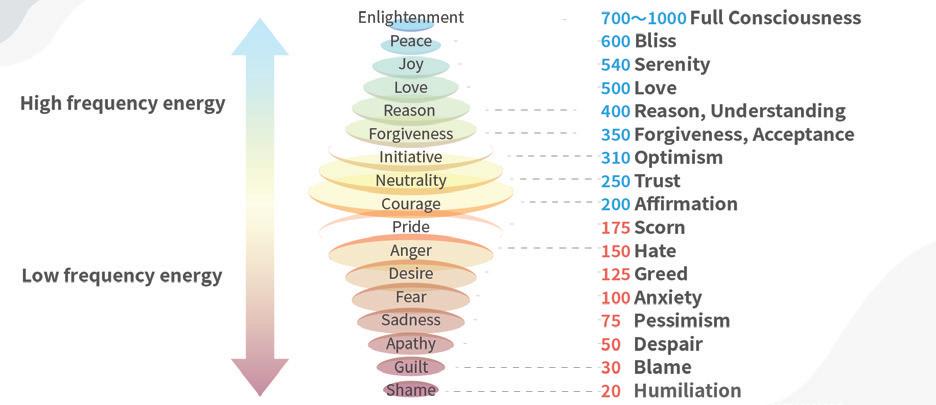
Scientist Peter Gariaev, expert in wave genetics, conducted an experiment and discovered that DNA could absorb photons and may have properties of an energy field.
tography.” When using this technique, a person is placed in an electromagnet ic field, and the electrons and photons emitted by the human body can be pho tographed through the excitation of the electromagnetic field.
In 1995, Russian physicist Konstantin Korotkov’s team invented gas discharge visualization (GDV), a technique that’s based on Kirlian’s work.
In GDV images, a healthy or calm person has a strong energy field with a rounded periphery. However, when someone is emotionally agitated, the en ergy field appears to have been “spiked.” And when there is a health problem, a person’s energy field shows holes, gaps, and other abnormalities. And different energy abnormalities are shown to cor respond to different organs, thus reflect ing the source of illness.
There’s also an intriguing image show ing rock ‘n’ roll music to be harmful to the human body. When a person with a minor emotional problem listened to rock music, the damage to his energy field became more pronounced.
Human emotions can change the body’s energy field, and the human mind can also change the state of DNA.
In 1996, Dr. Glen Rein, a biochemist at the UK’s University of London, presented a paper at the International Forum on New Science in Denver. In the paper, he pointed out that human intentions could affect the winding and unwinding of the two strands that make up the DNA helix.
The double helix structure of DNA resembles an old-fashioned telephone wire. When a DNA gene is expressed, the DNA will unwind; and when a DNA finishes copying itself, it winds into a helix. The DNA’s state of winding or unwinding can be measured by a type of physical instrument.
In the experiment, Rein removed the DNA from cells in human placentas and placed it in water. He then asked several individuals to try to wind or unwind the DNA with their thoughts. It was discovered that the rate of change in the DNA’s state by conscious intention was between 2 percent and 10 percent, which is a significant change compared to 1.1 percent in the control group with out conscious intention. This experi ment suggests that the human mind can change the DNA’s state of winding or unwinding.
DNA has properties of energy. So if thoughts can change the DNA’s state of winding or unwinding, they can theo retically change the body’s energy field as well.
As previously mentioned, spike proteins can cause deep damage to the body, af fecting the body’s DNA and potentially altering the body’s bioenergetic field.
To completely undo the DNA damage caused by the spike proteins, a bioen ergetic approach is needed.
Dr. David Hawkins, a leading U.S. psychiatrist, has discovered through decades of research that there are corre sponding energetic vibrational frequen cies for various emotional and mental states in humans.
• Shame, blame, despair, pessimism, anxiety, greed, hate, and scorn are thoughts that bring negative energy, are harmful to life, and aren’t conducive to improving the side effects of vaccines.
• Energy turns positive when courage is generated.
• Positive energy is generated by emotions of affirmation, trust, optimism, forgiveness, understanding, love, and peace.

• The highest energy is full consciousness or enlightenment.

Biophysicist Dr. Beverly Rubik conduct ed a pilot study on the effects of qigong on the human energy field. What we called mindfulness in the West has long been known to be part of qigong in the East. Both are methods of fitness.
Part of this method is to regulate the mind, get rid of distractions, and make the mind more positive and calm so that it can promote healing by regulating the body’s biofield.
Rubik took GDV images of the middle fingers of Parkinson’s patients’ hands before and after practicing qigong (in traditional Chinese medicine, the mid dle finger corresponds to the human brain). It was discovered that before qigong, the patients’ GDV images were damaged and irregular; after practicing qigong, they became significantly more complete and regular.
Theoretically speaking, if we can adjust the conscious intention in the process of practicing qigong to enhance positive thinking and improve the hu man biofield, it will naturally enhance our overall ability, including the ability of DNA self-repair, to resist the damage caused by spike proteins.
An illustration of a glowing human hand using Kirlian photography.
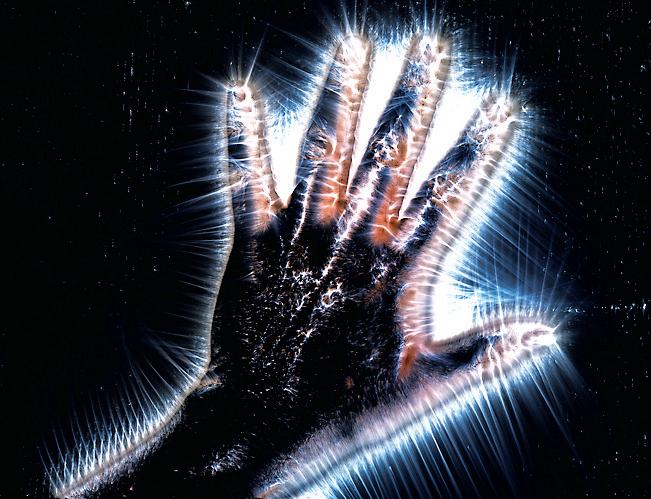
The genes of the human body are very important and hold the code of life, so the damage to human DNA requires special attention.Laser DNA Quartz container DNA ‘ATE’ ALL RAYS OF LASER SOURCE: QUANTUM BIOLOGIST PETER GARIAEV

An illustration of a blood clot consisting of red blood cells, platelets, and fibrin protein strands.
 SPIKE PROTEIN | HEALTH SCIENCE
SPIKE PROTEIN | HEALTH SCIENCE
These lead to a cascade of 200 symptoms
BY DR. YUHONG DONG & DR. JORDAN VAUGHNSince mid-2021, unusual, lengthy blood clots found in the vessels of COVID-19 pa tients and vaccine recipients have been reported across the world. Where do these strange, fibrous clots come from? How do they form?
Doctors have realized since the early days of the pandemic that COVID-19 isn’t just a lung disease but also an en dothelial and vascular disease.
Physicians have summarized a list of unusual clinical observations of COVID-19 including, but not limited to, severely hypoxic (low oxygen) patients despite relatively normal lung compli ance upon examination, thrombotic complications, and consistent autopsy findings of blood clots (thrombi) in the microcirculation of the lung.
After an acute COVID-19 infection, more than 200 different lingering symptoms have been reported for long COVID, which can persist for about six to 24 months. This is perhaps the largest number of symptoms reported with a medical condition so far.
The most frequent symptoms include breathlessness, fatigue, brain fog, cog nitive dysfunction, muscle aches and
pains (myalgia), sleeping difficulties, and anxiety or depression.
There’s evidence that spike pro tein-caused blood clots are leading to these symptoms.
As early as November 2020, a report with findings of increased microclots in COVID-19 patients versus healthy or diabetic patients could reasonably ex plain the breathlessness, fatigue, and post-exertional malaise syndrome.
The First Domino Toppled
Blood is a liquid that circulates under pressure through the blood vessels in our whole body, such as the water flow ing through the house that you then use to shower, do the dishes, and so on.
Following a vascular injury, any blood “leaking out” must rapidly be converted into a gel (a “clot”) to fill in the hole and minimize further blood loss.
Normally, the plasma portion of blood contains a collection of soluble proteins that act together in a series of enzyme activation events that result in the for mation of a fibrin clot. This process is protective, as it prevents excessive blood loss following injury.
Unfortunately, the blood-clotting mechanism can also lead to unwant ed blood clots inside blood vessels
(pathologic thrombosis), such as heart attack or stroke, both of which are leading causes of disability and death in the world.
The way in which COVID-19 causes abnormal blood clots has spurred many discussions since early 2020.
It appears that the virus’s unique spike proteins trigger the cascade via many “nontraditional” pathways.
The spike proteins’ direct invasion of the epithelium cells is the first domino toppled. Subsequent cascade effects fi nally cause blood clotting.
SARS-CoV-2 enters our cells via a protein receptor called the angioten sin-converting enzyme 2 (ACE2).
Many other cells, including lung epithelial cells, enterocytes lining the small intestines, and cardiac pericytes, all express ACE2.
Endothelial cells (ECs), express an abundance of ACE2. ECs reside on the inner sur face of every blood vessel across our entire body, mak ing them a direct target of the virus infection. ACE2 is almost everywhere inside our major organs and tissues.
Consequently, more pro-inflammato ry genes are expressed. More and more immune cells are attracted and sent to the injured or infected tissues (vessels in the lung, heart, gut, and so forth).
Due to the spike protein directly inter acting with ACE2 expression, COVID-19 patients show an elevated level of serum angiotensin II, indicating a dysregulation of the RAA system (re nin-angiotensin-aldosterone system, or RAAS).
Abundant studies support the idea that angiotensin II is capable of initi ating and upregulating inflammatory responses, worsening the clotting state.
In a regulated and self-limited im mune response, these mechanisms help to calm down the local injury, with subsequent healing and return
ing to a resting EC state.
However, for predisposed COVID-19 patients or vaccinated people, the fac tors strengthening clot formation are much heavier than healing mechanisms, all of which lead to an escalating thrombot ic cascade. Here’s a short sum mary of the first scene of the clot sto ry: spike-induced en dothelial disruption, massive amounts of von Willebrand factor (vWF) released, a sub sequent platelet storm, hypoxia-in duced upregulation and activation of vWF, fibrous network from neutrophil extracellular traps, and an increased angiotensin II level, all adding up to initiate thrombogenesis. This is how the clotting mechanism comes to be.
A COVID vaccine instructs the cells to produce large quantities of spike pro teins. Normal biochemical and physio logical processes are “hijacked” in order to make an abnormal amount of these spike proteins.
These abnormal amounts of spike proteins have more surprising direct effects on clots.
In a normal healthy person, the body will, in the presence of a blood clot, break it down by a process of fi brinolysis. This is a natural healing and balancing mechanism to prevent
Activation of the clotting cascade leads to large clots (causing strokes and pulmonary emboli) and also microclots (causing microinfarcts in many organs, but most notably in the brain).
All long-COVID symptoms may indicate the potential existence of microclots in the body, including but not limited to brain fog, memory loss, sleep disorders, anxiety or depression, chest pain, breathlessness, tachycar dia, fatigue, post-exertional malaise, and so forth.
In the legs, swelling is the most com mon sign of a blood clot. If you have significant swelling in one leg, call your doctor right away.
Some patients have symptoms called “COVID toes”—red, swollen toes that might be due to small clots in the blood vessels of the feet.
Clinical studies show that patients with COVID-19 have increased fibrino gen, fibrin degradation products, D-di mer, and von Willebrand factor, and these elevations appear to correlate with the severity of the disease and risk of clotting.

Here are a number of basic screening tests that could be considered if some one has long COVID-like symptoms:
• Complete blood count with differ ential and platelet count.
• D-Dimer—as a marker of clotting activation. A markedly elevated D-dimer indicates abnormal clots and that the fibrosis is activated.
• CRP: a simple, cheap, and sensitive marker of ongoing inflammation.
• Fibrinogen.
• Factor VIII.
• von Willebrand factor.
Fibrous clots found in the veins of corpses handled by funeral director and embalmer Richard Hirschman.
SARS-CoV-2 enters our cells via a protein receptor called the angiotensinconverting enzyme 2 (ACE2).
an abundance of blood clots.
In an outstanding study by Lize Grob belaar published in Bioscience Reports in August 2021, the biomarker S1 alone (the intruding part of the spike protein) can induce fibrin resistance to fibrino lysis, leading to unopposed microclot formation.
The results suggest that the presence of spike proteins in circulation may contribute to the hyper-clotting status and may cause substantial impairment of the clot-dissolving process.
Such lytic impairment may result in the persistent large microclots that people have reported, which have been found in plasma samples of COVID-19 patients.
These microclots block capillaries and limit the passage of red blood cells, re ducing oxygen exchange.
Furthermore, to everyone’s surprise again, spike proteins are identified to present seven amyloidogenic se quences and are able to form amy loid-like substances.
In other words, these spike proteins are similar to those beta-amyloid or tau or alpha-synuclein-like substances which may cause neuronal loss in Alz heimer’s or Parkinson’s disease patients.
Their structure makes it easy to form tighter string-like bonded structures with longitudinal twisting, as well as cross binding, forming a fibrous-like structure visible under the microscope.
Researchers have found that plasma samples from long-COVID patients still contain large amyloid clots that are re sistant to breakdown.
It has also been reported that the spike protein can competitively inhibit the bindings of antithrombin and hep arin cofactor II to heparin, causing an abnormal increase in thrombin (clot ting) activity.
There’s clinical evidence that the SARS-CoV-2 spike proteins have been detected in clots retrieved from COVID-19 patients with acute ischemic stroke and myocardial infarction.
To summarize, these unexpected negative effects of spike proteins on the dissolving process of blood clots, as well as their amyloid nature, all may be the key contributory factors to the ab normal, lengthy fibrous clots observed in COVID-related conditions.
Dr. Jordan Vaughn, an internal medicine specialist, says it’s key to start antithrombotic treatment in COVID-affected patients as early as possible. After seeing progress in acute patients after anticoagulation therapy, he found it useful in improving long COVID patients’ symptoms as well.

In general, there are two classes of antithrombotic drugs: antico agulants and antiplatelet drugs. Anticoagulants act on the clotting cascade and keep it from comple tion, while antiplatelet medicines inhibit the platelets from activating and attaching to each other and the endothelium.
Anticoagulants slow down clotting, thereby reducing fibrin formation and preventing clots from forming and growing. Antiplatelet agents prevent platelets from clumping and also prevent clots from forming and growing.
Apixaban is in a class of anticoagulants. It’s a factor Xa inhibitor. It works by blocking the action of a certain natural substance that helps blood clots to form.
Exogenous heparin can
significantly reduce coagulation caused by spike proteins and provide fundamental support for anticoagulant therapy, especially for critically ill COVID-19 patients.
Platelets are hyperactivated by the S1 subunit of the spike proteins of SARS-COV2. Platelets interact with circulating inflammatory molecules, the newly damaged endothelium, and immune cells.
Platelet complexes are mediated by membrane-membrane interactions via receptor binding.
Clopidogrel is an antiplatelet medicine. It prevents platelets (a type of blood cell) from sticking together and forming a dangerous blood clot. Taking clopidogrel helps prevent blood clots if you have an increased risk of having them.
Clopidogrel, also known as Plavix, is a blood thinner that’s used to prevent heart attacks and strokes in people who are at higher risk for those events.
Aspirin is also an antiplatelet medicine. It prevents platelets from clumping together to form a clot and acts on the thromboxane A receptor within the platelet.
Please note: All treatments should be prescribed under the instruction and strict monitoring of your physicians.

An illustration of multiple sperm cells and an egg cell in the process of natural fertilization.
 PHOTO BY YURCHANKA SIARHEI/SHUTTERSTOCK
PHOTO BY YURCHANKA SIARHEI/SHUTTERSTOCK
DR. FLAVIO CADEGIANI , a Brazilian endocrinolo gist, suspects that the worst is yet to come for spike-protein-induced diseases in the endocrine system.
The endocrine system, colloquially known as the hormone system, is crit ical for our health. It regulates growth and development, mood, metabolism, reproduction, immunity, and functions of other organs through the secretion of hormones.
Hormones are one of the three biggest messengers in the body. Compared to the two other messengers—neurotrans mitters and cytokines—hormones are slower in responding and have systemic functions across the body rather than localized actions.
While cells can usually respond to neurotransmitters in milliseconds and cytokines in minutes to hours, cells that respond to hormones can take hours or even weeks.
Since hormones can have slow and sys temic actions, a dysfunctional or dam aged endocrine system will generally be slow in its symptom onset and recovery.
Studies have shown that spike pro teins from COVID-19 infection and the COVID-19 vaccines can damage endocrine glands, including pituitary, thyroid, and adrenal glands, as well as reproductive organs and many more.
Cadegiani raised a concern that the slower onset of endocrine patholo gies may pose difficulties in diagnosis and treatment.
Endocrine pathologies can take lon ger to become apparent because endo crine glands have “reserves,” accord ing to Cadegiani.
“What we’re going to see in the future [for endocrine diseases] is a little bit different from the other fields, because glands have reserves and the decrease of the reserve will not be clinically seen right now, but it may be in the future,” Cadegiani said at a Front Line COVID-19 Critical Care Alliance (FLCCC) conference in Kissimmee, Florida.
Therefore, affected individuals may show no symptoms until their reserves have been depleted.
Cadegiani said most of his concerns for the future are speculative and based on his own clinical observations. But since the pandemic and the administra tion of COVID-19 vaccines began, there have been increasing reports that im plicate endocrine pathologies.
Hormones regulate the entire body, so once the reserves are depleted and underlying endocrine pathologies are
unmasked, there may be cases of sys temic dysregulations.
Endocrine glands control the function of many organs across the body, and each endocrine organ is also connected through a feedback loop, also known as a hormonal axis.
At the top of this chain is the hypothal amus, which is a diamond structure in the brain and acts as a master switch board. It sends messages to the pituitary gland, a small, oval structure tucked be hind the nose.
The pituitary gland is colloquially known as the master gland; it regulates other endocrine organs together with the hypothalamus, forming hormonal axes.
The pituitary gland is part of the hypo thalamic-pituitary-gonadal axis, which regulates the reproductive organs, in cluding the ovaries and the testes. In females, it’s responsible for regulating the release of ovarian hormones as part of the menstrual cycle; in males the axis regulates spermatogenesis.
The hypothalamic-pituitary-adrenal axis is a neuroendocrine axis that me diates the adrenal glands, an organ that produces hormones that trigger the fight-or-flight response. The process is a stress response that occurs in response to harmful threats and can reduce metabo lism, suppress the immune system, and activate the sympathetic nervous system.
Another major axis is the hypotha
Hypothalamus Pituitary Gland
Thyroid Gland
Thymus Adrenal Glands Pancreas
An illustration of the endocrine systems in men and women.
Testes Overies
lamic-pituitary-thyroid axis. This regulates the thyroid gland and the hormones it se cretes. Thyroid hormones are essential for biological func tions of growth, regulation of the cardiovascular system, bone replacement, liver func tion, and metabolism.
The spike protein is the most toxic part of the SARS-CoV-2 virus. Studies on people with long COVID and post-vaccine symptoms often detect spike protein presence months or even a year after exposure.
Spike proteins particularly favor tissues and organs that express ACE2 and CD147 recep tors. Many endocrine glands display ACE2 receptors, in cluding the pancreas, thyroid, testes, ovaries, adrenal gland, and pituitary gland, making the endocrine system particu larly vulnerable to SARS-CoV-2.
the spike proteins are able to suppress the production of LH and FSH in pituitary cells, with unknown long-term con sequences in humans.
ACTH deficiencies have been observed following mRNA vac cination in Japan, with the per son affected found to have a shrunken pituitary gland.
Cadegiani said pathologies in the pituitary are difficult to di agnose; they’re often masked by other conditions, therefore there’s little literature on pitu itary pathology presentation after COVID-19 vaccinations.
There’s published literature with data that may be used as evidence to suggest spike protein injury at the adrenal glands.
The key driver behind spike-pro tein-induced disease is inflammation.
Upon entering cells, spike proteins can activate pro-inflammatory path ways by inducing DNA damage; inhib iting DNA repair; causing stress to the cell’s mitochondria, which is critical for cell energy production; and much more. All of this lead to cellular stress, injury, and possible cell death.
When many cells are affected, it can cause problems in tissues and organs, affecting individual endocrine glands and the system.
Spike proteins also inhibit autoph agy, the cellular “recycling system,” thereby preventing the cells from clearing the toxic protein out, leading to prolonged damage.
Spike proteins may also contribute to autoimmunity. Since it shares many similarities with common human tis sues and proteins—known as “molec ular mimicry”—it has the potential to cause immune cells to mount an attack against the body’s own cells and organs, leading to endocrine damage.
Several studies have reported on endocrine pathologies following COVID-19, although data on the exact damage is still emerging.
As the master gland of the endocrine system, the pituitary gland secretes many hormones, including ones that regulate other endocrine glands:
• Adrenocorticotrophic hormone (ACTH) targets the adrenal glands and is responsible for producing cortisol, which stimulates the stress response.
• Thyroid-stimulating hormone reg ulates the thyroid.
• Growth hormone is responsible for growth and metabolism.
• Melanocyte-stimulating hor mone boosts the production of melanin when exposed to UV rays and increases appetite.
• Antidiuretic hormone is responsi ble for retaining water and produc ing less urine.
• Luteinizing hormone (LH) folli cle-stimulating hormone (FSH), and prolactin are important for reproduction.
• Oxytocin plays a role in childbirth, metabolism, and happiness.
Studies in cell culture have shown that
The adrenal glands, located above the kidneys, produce hormones responsible for the stress response. This includes adrenaline, cortisol, and al dosterone. The release of these three hormones is critical for maintaining energy and other needs during stress ful situations.
Studies on COVID-19 have shown that the adrenal glands are major sites of SARS-CoV-2 mRNA accumulation and spike protein production.
The glands are also likely to be involved in post-vaccine myocarditis events that are often seen in young males. Cadegiani said this type of myocarditis may be a sign of adrenal dysfunction.
Cadegiani authored a peer-reviewed study on post-vaccine myocarditis and concluded that catecholamines are a main trigger for these events. Catechol amines are a group of neurohormones and include dopamine, noradrenaline, and adrenaline.
While dopamine mostly acts within the nervous system, both adrenaline and noradrenaline play important roles in stress responses.
Adrenaline activates the fight-orflight stress response and the nor adrenaline supports the response by increasing heart rate, breaking down fats, and increasing blood sugar levels.
Intense and prolonged exercise trig gers the fight-or-flight response, which is why catecholamines are usually
elevated in athletes. Males, in particu lar, tend to have higher levels of cate cholamine. Testosterone is also suspect ed to play a role in the higher incidence of myocarditis following vaccination.
Stress responses increase blood pres sure, strengthen heart contraction, and when chronic, can increase the risk of cardiac events.
Cadegiani linked catecholamines with myocarditis by analyzing the au topsy reports of two teenage boys who died three to four days after mRNA vac cination from myocarditis events. Their heart damage was different from nor mal myocarditis pathology, with clear similarities with stress-induced cardio myopathy; Cadegiani observed clear characteristics of catecholamine-in duced myocarditis.
He hypothesized that the vaccines triggered a hyper-catecholaminergic state by elevating levels of adrenaline, causing hyperactivation of adrenaline.
Studies on mRNA-vaccinated ath letes also found that after exercise, those who were vaccinated had higher heart rates and noradrenaline levels than those who weren’t vaccinated.
Dysfunctions in the adrenal glands are likely to lead to adrenal insuffi ciency.

Cadegiani hypothesized adrenal in sufficiency—a condition in which the
adrenal glands become unable to pro duce enough hormones—to be a possi ble consequence of spike protein injury.
There’s already a report of adrenal in sufficiency following infection; in the case of long COVID in which there are spike protein remnants, it’s likely that the damage will be prolonged, possibly leading to chronic damage.
In the case of vaccines, a report eval uating spike protein production after COVID-19 mRNA vaccination found that the adrenal gland was one of the highest spike protein-producing tis sues, and the spike protein production in the gland increased with time.
Current research has also shown that complications from thrombocytope nia as a post-vaccine symptom have led to adrenal hemorrhage and adrenal insufficiency.
The thyroid is a butterfly-shaped gland located over the throat. It has a lot of functions, primarily regulating growth and metabolism.
It makes two hormones: thyroxine and triiodothyronine. Deficiencies in triiodothyronine results in hypo thyroidism, characterized by a large thyroid; over-secretion of it can cause hyperthyroidism.
The thyroid also plays a role in regu
lating the immune system. COVID-19 infection is often a sign of underlying thyroid problems, and damage from infection can exacerbate thyroid prob lems, creating a negative cycle.
An autopsy study on 15 people de ceased from COVID-19 found that 13 of them had viral RNA and proteins in their thyroid tissues. ACE2 receptors, previ ously thought to be not presented on the thyroid, were also detected, indicating a possible route for SARS-CoV-2 infection.
Although the research shows that thy roids can be implicated in infection, thy roiditis, which is inflammation of the thyroid, has currently only been report ed in relation to the COVID-19 vaccine.
A study from Turkey states that the COVID-19 vaccine can induce thyroid itis. The study evaluated 15 patients who developed thyroiditis following vaccination.
Four of the patients also developed Graves’ disease, which is an autoim mune disease and a complication of hyperthyroidism. Hashimoto’s disease, another thyroid autoimmune condi tion, has also been reported following vaccinations.
It’s possible that spike proteins pro duced from vaccinations may attack the thyroid cells by binding to ACE2 receptors. However, looking at the high reports of autoimmune diseas es, Cadegiani said the pathogenesis of thyroid dysfunction is likely au toimmune. The spike proteins have also demonstrated their autoimmune capacity due to high incidences of “molecular mimicry.”
The pancreas produces glucagon and insulin, two important hormones that regulate our blood sugar levels. Dys regulation of blood sugar levels is an indication of pancreatic dysfunction and may lead to complications, such as diabetes.
Spike proteins from both the vaccine and the virus have shown a potential to disturb glucose metabolism.
There have been reports of a sudden onset of type 1 diabetes, which is a form of autoimmune disease in which the body attacks its own pancreatic beta cells.
A study evaluating EudraVigilance safety surveillance reports also found reports of dysregulation of blood glu cose with transient worsening of hyper glycemia reported after vaccinations.
The thyroid has a lot of functions, primarily regulating growth and metabolism.
As the master gland of the endocrine system, the pituitary gland secretes many hormones, including ones that regulate other endocrine glands.
Chronic hyperglycemia, meaning high blood sugar, is usually a sign of dysfunction in the pancreatic beta cells.
Therefore, Cadegiani proposed that there could be a loss or malfunction of pancreatic beta cells, as studies have shown that the spike proteins are able to directly affect and dam age these beta cells, likely resulting in their death.
The harms of COVID-19 on male repro ductive organs are well established.
A study from Thailand shows that in 153 sexually active men, about 64.7 per cent experienced erectile dysfunction
HUMAN PANCREAS
Since the vaccine rolled out in 2021, the Centers for Disease Control and Prevention data reported 193 cases of erectile dysfunction following COVID-19 vaccination.
An Israeli study on sperm donations also noticed a reduction of 15 percent in sperm concentration and 22 per cent in motile sperm count following COVID-19 mRNA vaccination.
The authors confirmed in a later response that the people tested had no underlying health conditions, and therefore, the reduction couldn’t be because of any underlying health con ditions that were existent prior to the vaccination.
at a greater risk of presenting with post-vaccine symptoms in the clinic.
During the pandemic, many wom en reported menstrual abnormalities following vaccination. A study on Mid dle Eastern women found almost 70 percent of them reporting menstrual irregularities after vaccination.
A study funded by the National In stitutes of Health found a “temporary increase in menstrual cycle length” linked to the COVID-19 vaccination.
A study published on the website My Cycle Story reported more than 290 women who have experienced decid ual cast shedding after the COVID-19 vaccines rolled out, even though less than 40 such cases have been docu mented over the past 109 years. This also indicated that many of the re productive symptoms women were suffering from may be vaccine relat ed, rather than related to COVID-19 infections.
during COVID-19 infection, with 50 percent persisting in these symptoms three months after recovery.
Erectile dysfunction has been estab lished in research to be due to dysfunc tions of the endothelial cells, and the spike proteins impair endothelial cells.
Studies linking COVID-19 and erec tile dysfunction have largely blamed it on the virus’s interaction with ACE2 receptors displayed on the surface of endothelial cells. Endothelial cells are abundant in ACE2 receptors, making them one of the most targeted in COVID-19 infections.
A study evaluating adenovirus DNA vaccines shows that cells exposed to the vaccines also produced spike pro teins that could interact and bind with ACE2 receptors, suggestive of equal en dothelial damage.
Although sperm count gradually made a recovery after 145 days, sperm concentration and motility didn’t re turn to pre-vaccination levels, with unknown long-term effects.
Concerns of reproductive problems have also been reported in women, most particularly after vaccinations rather than after infection.
Studies show that men are general ly at a higher risk of severe outcomes and deaths from COVID-19 infections; however, women seem to be at a higher risk of vaccine injury.
VAERS data shows that more than 60 percent of adverse event reports came from women, indicating that women are more vulnerable to post-vaccine symptoms.
Dr. Paul Marik, a critical care ex pert, also observed that women were
Cadegiani predicted greater adverse events in pregnancies for the coming future.
He cited a study that concluded “no association” between COVID-19 vac cines and fertility. However, the data show that unvaccinated women had a higher rate of pregnancy than the vaccinated, both for clinical and bio chemical pregnancy.
The authors of the paper reviewed 10 studies and found that unvaccinated women have a clinical and biochem ical pregnancy rate of 47 and 60 per cent, respectively, while the vaccinated had a rate of 45 and 51 percent.
Cadegiani predicted more cases of endocrine pathologies as a result of spike injuries in the future.
“Endocrine diseases progress slow ly and then only clinically appear in the severe states,” Cadegiani said. “So it’s not possible to tell this [anytime] beforehand.”
Studies on COVID-19 have shown that the adrenal glands are major sites of SARS-CoV-2 mRNA accumulation and spike protein production.
Literally, autophagy means “self-eating.”
It’s the process in which your cells get rid of waste or toxins.
The concept of autophagy was first introduced in 1974 by Belgian cytologist and biochemist Christian de Duve. He was awarded the Nobel Prize in Physiology or Med icine in the same year for his discovery of lysosomes.
It’s a natural physiological mechanism wherein dys functional cells are broken down and their waste prod ucts are used to make healthy cells, similar to a city’s waste recycling process.
During the process of autophagy, an autophagosome is first produced in the cell, then acts as a “garbage bag,” enveloping the various waste products in the cell.
The “garbage bag” will fuse with a lysosome (which contains loads of enzymes to break down the garbage) to form a “garbage processing station” called an autolysosome, which will then break down and recycle the waste materials.
In summary, once autophagy is initiated, cytoplas mic elements, or the “cargo” that’s to be recycled, are engulfed into double-membrane vesicles, termed auto phagosomes, which fuse with lysosomes to form autol ysosomes, where the cargo is then degraded.
Autophagy is an important physiological mechanism that not only removes harmful components from cells in a timely manner but also transforms useless proteins into recyclable amino acids.
This brings a variety of benefits to the body, including anti-aging benefits, reduced inflammatory status, boost ed immunity, and reduced cancer risk.
It’s likely that autophagy removes spike proteins as well as misfolded proteins induced by the spike proteins themselves. Autophagy may therefore play a critical role in reversing the “spikopathy” induced by the COVID-19 virus and vaccines. Indeed, activation of autophagy is one of the most pivotal mechanisms for removing in tracellular spike proteins.
How does SARS-CoV-2 impair autophagy?
A component of the SARS-CoV-2 virus (ORF3a) inhib its the cells’ waste-recycling process. The virus also impairs autophagy by reducing glycolysis and protein translation by limiting the activation of AMP-protein activating kinase and mammalian target of rapamycin complex 1 (mTORC1).
In cells infected with the SARS-CoV-2 virus, the forma tion of autolysosomes (“garbage processing stations”) has been substantially blocked, resulting in many more “garbage bags” of cellular waste accumulating inside the cells while at the same time reducing the cells’ process ing ability, preventing the timely recycling of waste and harmful substances in the cells. This further worsens the persistence of spike proteins in our bodies and cells.
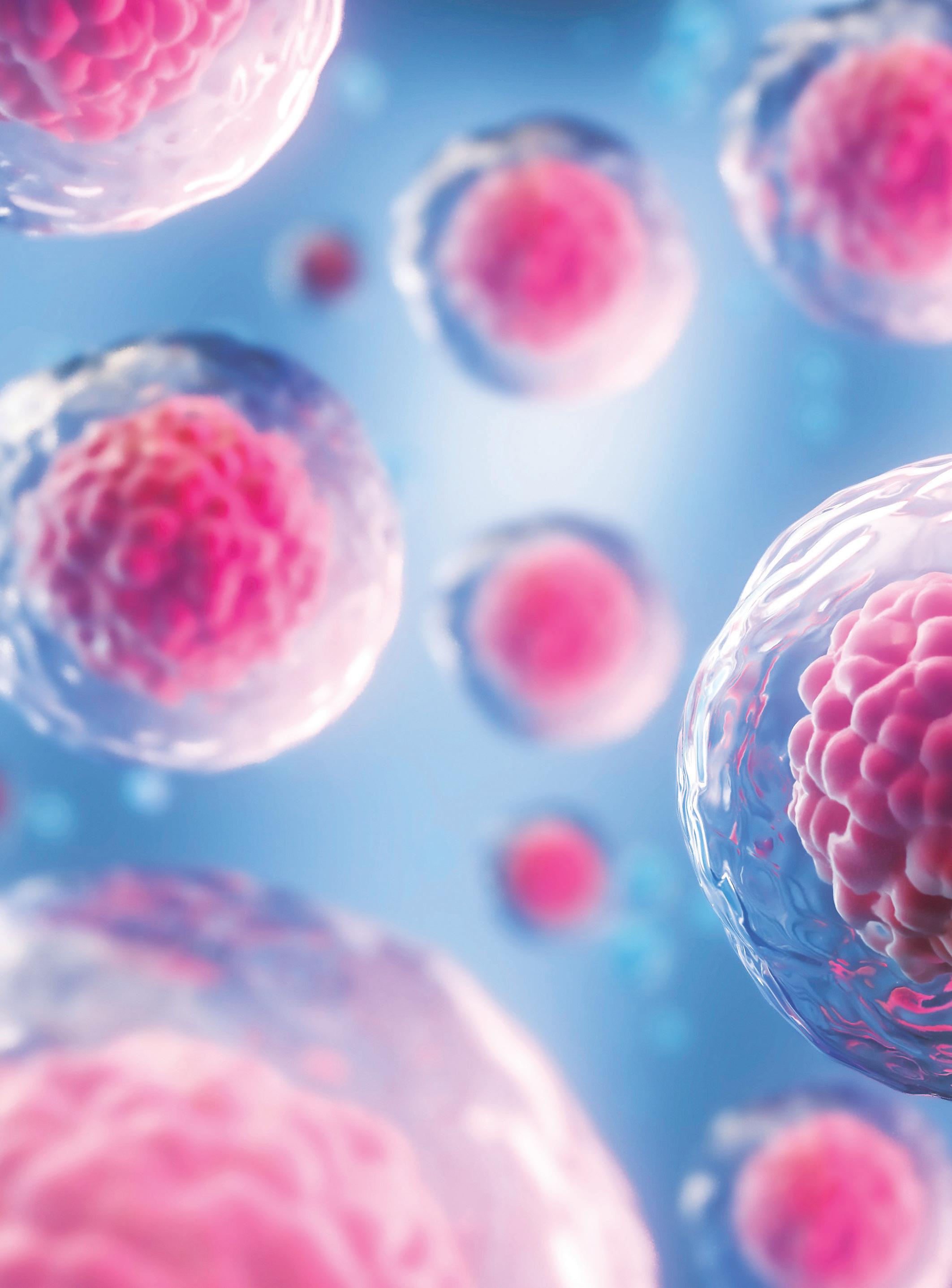
Autophagy breaks cellular components down to molecules, such as monosaccharides, fatty acids, and amino acids, that can be used to produce ATP.
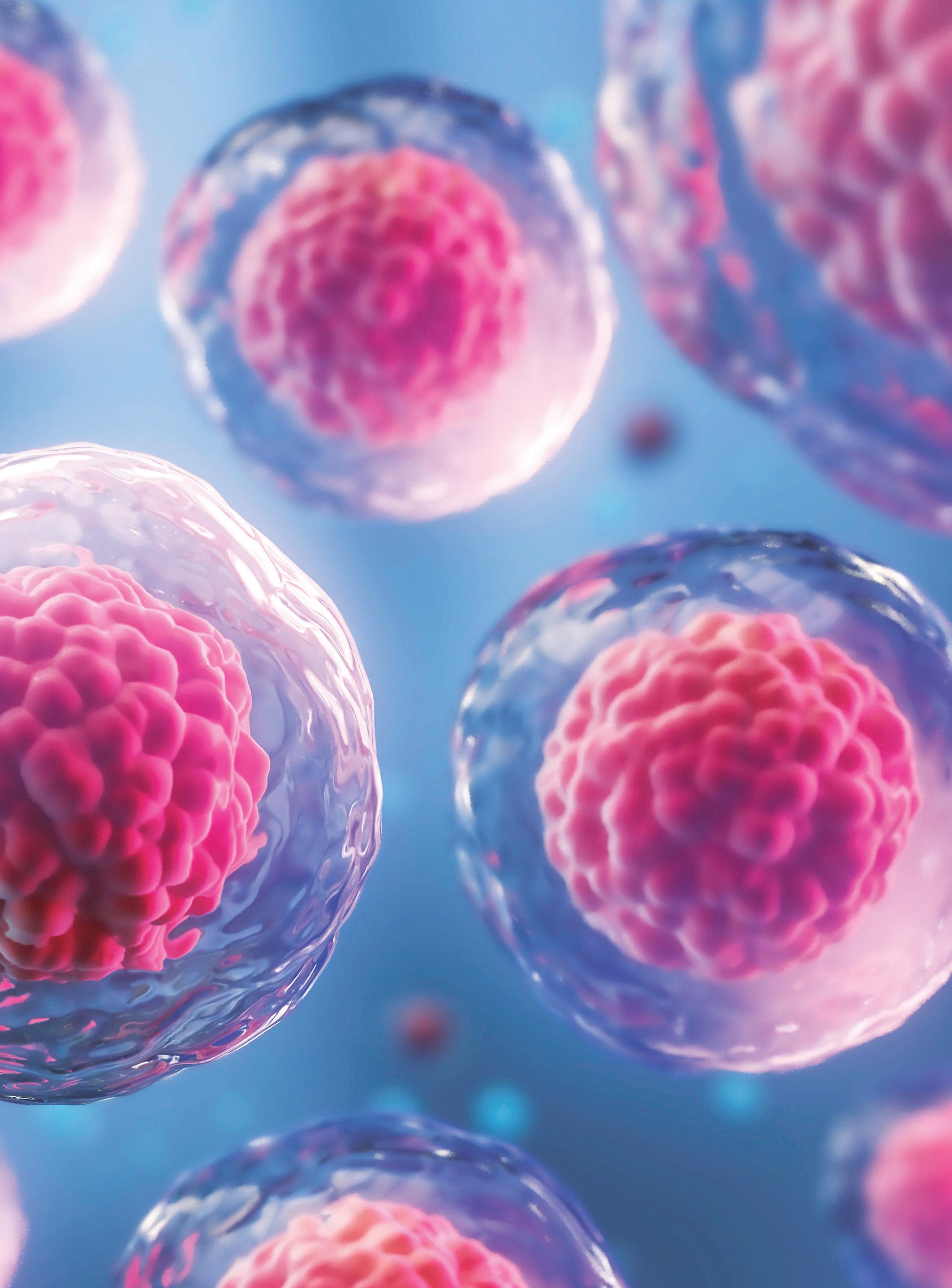 PHOTO BY ANUSORN NAKDEE/SHUTTERSTOCK
PHOTO BY ANUSORN NAKDEE/SHUTTERSTOCK
MAYBE YOU’VE NEVER heard the word “autoph agy” before. Or maybe you’ve been wondering for years what it means.
Autophagy, also called autophago cytosis, refers to a process in cellular biology that has sparked interest in re cent years because of its implications for medical science and human health.
“Auto” means self in Greek. “Phagy” means to eat or to devour. So, “autopha gy” is the act of eating one’s self. And this is exactly what cells do to keep healthy— especially when they’re starving.
Each cell has organelles (cellular or gans) called lysosomes that function like a stomach. They digest and break down cellular waste and invading viruses and bacteria. Different forms of autophagy make use of the lysosome’s digestive enzymes to break down cellular com ponents at different scales.
At a crucial level, autophagy allows for the orderly recycling of cellular compo nents, turning them into the building blocks for future cells.
Cells have a kind of life cycle or job cycle. At a given time, any cell in the body is focused on a specific task, Dr. Henry Ealy, a naturopathic physician based in Phoenix, said during a talk he gave at a recent health care conference in Sedona, Arizona.
These cell activities include:
• nutrient absorption
• energy production
• making enzymes
• assembling and distributing proteins
• autophagy
• replication
Autophagy is the stage many cells don’t get into every day, according to Ealy. That’s because the cells never have a break from tasks triggered when we eat food.
“The most important thing you can do every single day to make sure you are getting into autophagocytosis is to be hungry,” he said.
Hunger, Ealy insisted, is a key strategy that helps the body heal.
You can think of cells as little facto ries, in a way. They take all the nutri ents that we eat and turn them into our bodies and the processes that drive our bodies. When we don’t eat, these little cellular factories have a chance to tidy up, replace broken machinery, and use up waste material. This is autophagy.
During autophagy, or autophagocytosis, the lysosomes increase a cell’s life span by breaking down and recycling cellular materials. This process also helps the cell balance its energy demands when it’s stressed.
A Belgian biochemist named Chris tian de Duve is credited as the person who invented the term autophagocyto sis. De Duve was also the first scientist
to show evidence that lysosomes are involved in this process. For his pio neering research (including that on lysosomes), he was honored with the Nobel Prize in Physiology or Medicine in 1974.
In fact, understanding autophagy was so important to medicine that in 2016, the Nobel Prize was awarded to another pioneer in this field: Japanese molecular biologist Dr. Yoshinori Ohsumi.
Scientists have found evidence that there are at least three kinds of auto phagic activity that take place within our cells, and that each plays a slightly different role in helping cells maintain themselves. Those are macroautophagy, microautophagy, and chaperone-medi ated autophagy.
MACROAUTOPHAGY: This is a process in which parts of the cytoplasm inside the cell are sequestered—basically encapsu lated—and then delivered to lysosomes to be broken down.
During the first phase of this process, a phagophore, or isolation membrane, is formed. Once the cellular material is sequestered, it fuses with the lyso somes. Then lysosomal enzymes de grade its contents, according to a 2008 explanatory article published in the journal Cell.
MICROAUTOPHAGY: In microauto phagy, which a research review pub lished in Cellular and Molecular Li fe Sciences described as “a lesser-known
SARS-CoV-2 Virus Inhibits Mechanism of Autophagy
SARS-CoV-2
SARS-CoV-2 Virus Inhibits Autophagic Activity
self-eating” process, components of the cell are engulfed directly by small autophagic tubes, also called invaginations, found in the lysosomal membrane.
This kind of autophagy is most often seen when cells are nitrogen deficient. According to the review authors, “mi croautogaphy is coordinated with and complements” other types of self-eat ing pathways.
This third kind of autophagy may be responsible for the degradation of 30 percent of cytosolic proteins when cells experience nutrient deprivation. That’s according to a 2007 review article by the late Dr. James Dice, who was a pro fessor of physiology and a specialist in aging and autophagy at Tufts Univer sity’s School of Medicine.
The cytosol, which is a component of cytoplasm, is the substance that fills the interior of the cell. Cytosolic proteins are involved in protein mod ification, mRNA degradation, and metabolism, among other functions. This kind of autophagy involves mo lecular chaperons, substances in the cytosol that undo proteins within the cytoplasm and usher them across the
membrane of the lysosomes, where the autophagy is completed.
Autophagy and Cellular Energy
Autophagy is particularly important during starvation scenarios in which cells are in nutrient-poor environments and need cellular ingredients as build ing blocks and to support ATP produc tion, according to a molecular biology research paper published in 2010.
ATP, if you remember back to basic biology, stands for adenosine triphos phate. If our cells are little factories, ATP is the fuel they run on. This or ganic compound, which is found in all living organisms (including the most primitive unicellular beings), provides energy to living cells.
ATP consists of three components: adenine, ribose, and triphosphate. You can also think of ATP as molecular money—the currency that’s needed to transfer energy from cell to cell. ATP is made by tiny organelles inside our cells called mitochondria that are con sidered “the powerhouses” of the cells.
Autophagy breaks cellular compo nents down into molecules, such as monosaccharides, fatty acids, and amino acids that can be used to produce ATP.
Given that it supports the production of more ATP, scientists have long believed that autophagy helps cells survive. While this appears to be true, autopha gy also plays a key role in cell death by eliminating damaged organelles and protein aggregates, according to a team of scientists in Massachusetts, writing in the journal Perspectives in Biology and Medicine in 2012.
Cancer is the result of the unchecked growth of abnormal cells. Appropriate autophagy is important to stopping tumor growth, inhibiting cancer cell survival, and clearing cancer cells.
“The modulation of autophagy plays dual roles in tumor suppression and promotion in many cancers,” two Korean biochemists wrote in a 2018 review article published in the peer-re viewed International Journal of Molec ular Science.
Although autophagy can contribute to the resistance to anti-cancer agents, “autophagy is a promising potential therapeutic target in cancer treatment,” the authors wrote.
Because autophagy breaks down bro ken cellular parts and helps our cells rebuild with better ingredients, so to speak, it’s a critical process when it comes to cellular damage, such as that associated with spike proteins caused by the COVID-19 virus and the vac
Appropriate autophagy is important to stopping tumor growth, inhibiting cancer cell survival, and clearing cancer cells.
virus blocks the formation of autolysosome
cines mandated in regard to it.
According to Ealy, because it jump starts autophagy, “hunger is healing.” He has observed that depriving the body of nutrients for a three-day wa ter-only no-calorie fast can help resolve the symptoms of a variety of health con ditions, Ealy said in his Oct. 15 talk in Arizona.
Fasting can help reverse damage
caused by COVID-19 vaccines and other toxic exposures, he claimed.
Ealy gave the example of a patient who felt very sick after receiving the first Moderna vaccine dose. Five weeks later, she felt better. But after the second dose, which she was advised to get, her health “started going haywire.”
Her legs, arm, and wrists started to hurt. The joint pain was so bad that she
found walking upstairs difficult.
“I was having heart palpitations,” the patient recounted in a video interview Ealy played during his presentation. “I was really afraid I was going to die.”
She had bloodwork done by her gen eral practitioner about a week after receiving the second vaccine dose. Her doctor was concerned by the numbers.
This patient had been previously diagnosed with hypothyroidism (a pathologically slow thyroid). Even so, her thyroid-stimulating hormone sky rocketed to abnormally high levels.
Her general practitioner advised that she report the side effects she experi enced to the Centers for Disease Control and Prevention’s (CDC) Vaccine Adverse Effects Reporting System.
“My suspicion was that the mRNA se quences were still viable and still pro
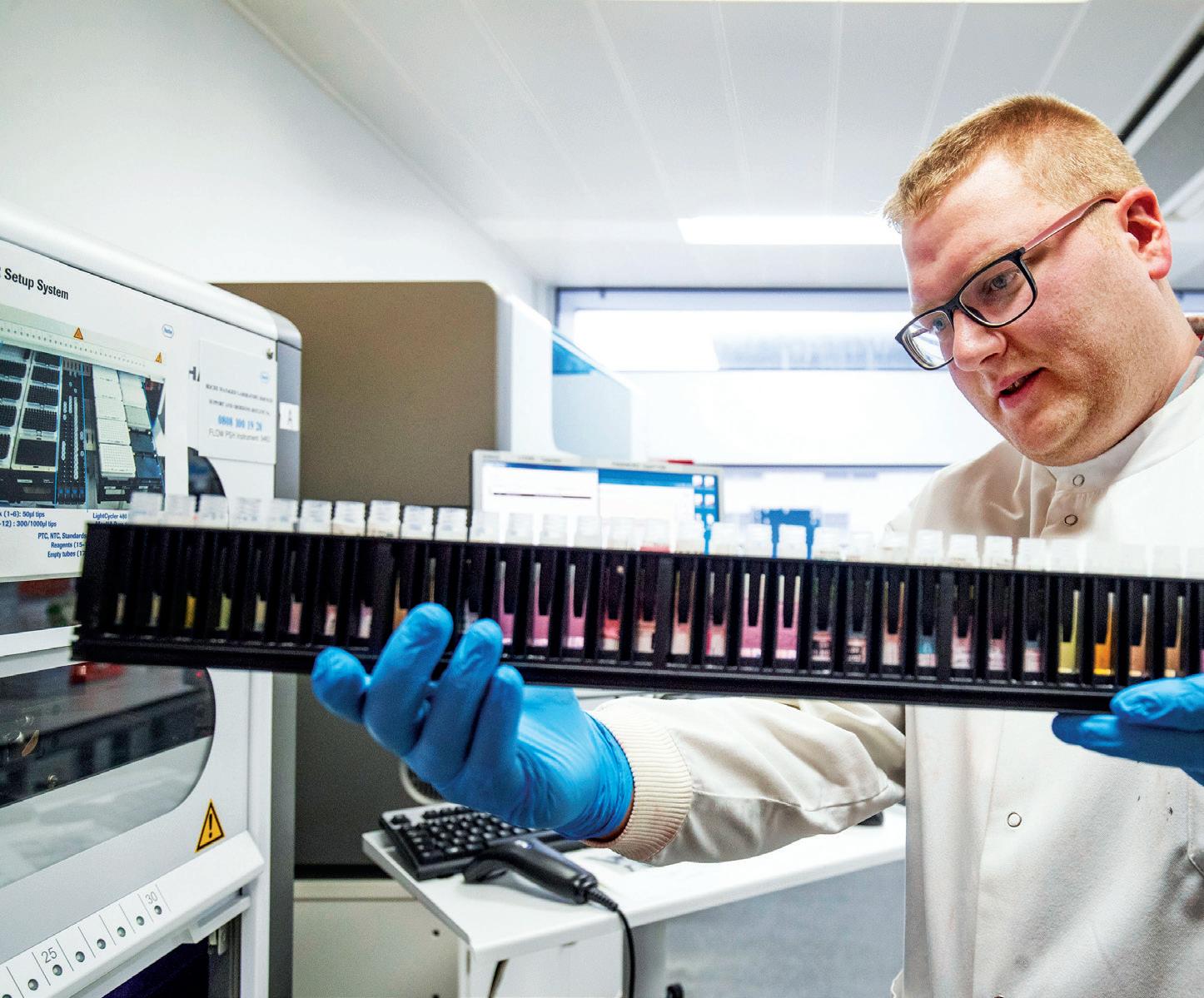
Although the CDC said that mRNA vaccines wouldn’t change human DNA, a recent study has found that vaccine mRNA was quickly taken into human liver cell line, where the mRNA subsequently wrote itself onto the line’s DNA.
ducing spike protein,” Ealy said.
Although the CDC stated that mRNA vaccines wouldn’t change human DNA, a recent study from researchers at Lund University in Sweden found the opposite: This in vitro study shows that vaccine mRNA was quickly taken into the human liver cell line, where the mRNA subsequently wrote itself onto the line’s DNA.
Ealy believed his patient’s symptoms, including the joint pain, muscle weak ness, and heart palpitations, were be cause her body was still producing the SARS-CoV-2 spike proteins, coded by the vaccine mRNA.
“Fasting is the off-switch,” he said.
After studying cellular biochemistry, Ealy believes that a three-day water fast, which compels the cells to engage in autophagy, can help the body clear
(Left) A technician shows swab samples from which the COVID-19 virus is extracted for research at a laboratory at Glasgow Royal Infirmary in Scotland, on Feb. 19, 2020. (Top) COVID-19 vaccines at the Skane University Hospital vaccination center in Malmo, Sweden, on Feb. 17, 2021.

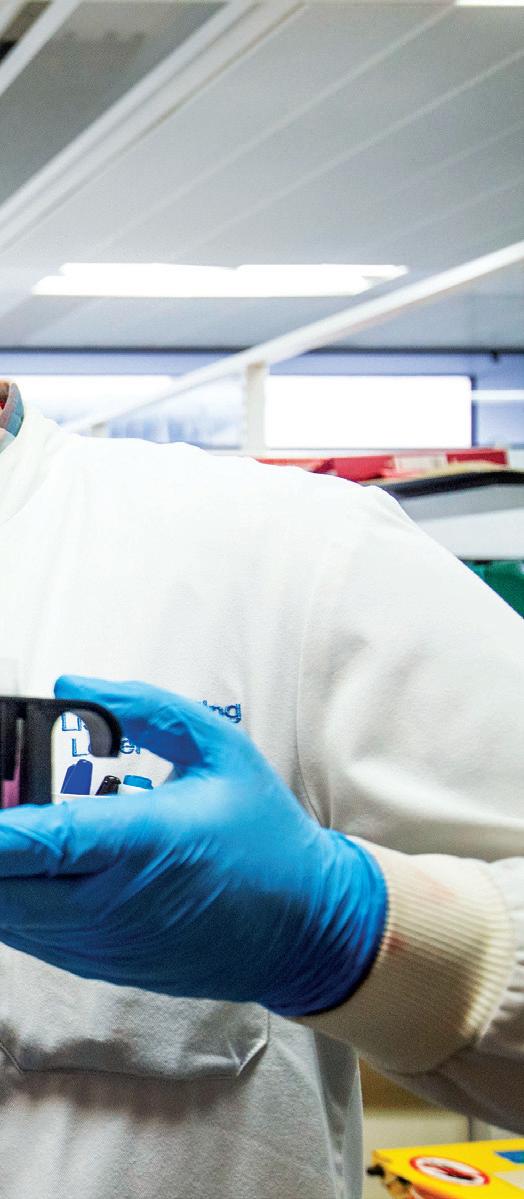
these spike proteins, whether they’re from a SARS-CoV-2 infection itself or from an mRNA vaccine.
fore she started to feel better. But the results were startling. After those cycles in which she had her blood redrawn, her doctor was astonished by how healthy her hormone levels were. They were so normal, in fact, that her doctor won dered if the protocol had reversed her autoimmune condition.
“Every time I did the three-day wa ter fast, I always felt so good,” Ealy’s patient said.
After the three-day fast, he prescribed 11 days of targeted nutrients and en zymes to further help his patient break down any circulating spike proteins.
It took the patient three cycles of fast ing followed by nutritional healing be
Fasting isn’t something that conven tional practitioners and patients asso ciate with well-being. And a three-day water fast isn’t something that should be taken lightly and without medical supervision.
But when it comes to well-being on the cellular level, Ealy insists that fast ing—and inducing autophagy—is an important way to help the body heal.
“The most important thing you can do every single day to make sure you are getting into autophagocytosis is to be hungry.”
Dr. Henry Ealy, naturopathic physician
Usually wouldn’t occur
MELATONIN IS A PLEIOTROPIC molecule that not only reduces oxidative and cellular stress but also regulates the immune system and activates the autophagy pathway by reinforcing unfolded protein response (UPR) and unlocking autophagy blockage. This allows autophagosomes to bind to lysosomes, completing the process of autophagy and decreasing viral replication.
Melatonin is a smart molecule. It dif ferentially modulates autophagy and the related pathways in normal versus tumor trophoblast cells, being cytopro tective in normal cells while increasing apoptosis in tumoral trophoblast cells.
Colloquially known as the “sleep hor mone,” melatonin is produced by the pineal gland to promote restful sleep. It has both anti-inflammatory and an ti-oxidizing properties.
In cells, melatonin promotes mito chondrial health by reducing active ox ygen species. Because the mitochondria uses a lot of oxygen, when it’s stressed through environmental toxins such as radiation or spike protein exposure, it
may produce reactive oxygen species. Melatonin, an antioxidant, can therefore prevent oxidative damage. Studies show that it also prevents leakage of electrons from mitochon dria and, therefore, maximizes ener gy production.
Due to its anti-oxidizing property, melatonin repairs DNA that’s been damaged by free radicals. Melatonin and its metabolites also activate genes that promote DNA repair and suppress gene activity that may lead to damaged DNA.
Melatonin in Serum
Melatonin also has anti-cancerous properties. Animal studies on mela tonin have shown that animals that were administered melatonin had a lower rate of tumor generation.
Melatonin has also been recom mended by the Front Line COVID-19 Critical Care Alliance in treating tin nitus, a post-vaccine symptom, as well as a symptom of long COVID. The symptom is a ringing in the ears and can disturb sleep if severe. Melatonin can help reduce the ringing and help people to get a good night’s sleep.
Dark Time 0 20 40 60 80 100 120 140
Melatonin synthesis and secretion is inhibited by light; therefore, it‘s also known as the hormone of darkness. Melatonin levels in humans
vary as the sun rises and sets. Secretion of melatonin increases after nightfall, reaches a peak between 2 a.m. and 4 a.m., and decreases
gradually during the second half of the night.
Nearly 80 percent of melatonin is synthesized at night, with serum
THERE ARE THREE r easons why sleep is important for autophagy.
First, most of our brainbased autophagy happens during the night when we’re in deep sleep. Auto phagy has a rhythm just like our human body, and it’s optimized when we align our internal rhythm with the sun’s cycle.
Second, autophagy also happens during sleep because when we sleep, we fast. However, if we eat a big meal right before sleeping, we’re not going to have autophagy.
Third, melatonin secre tion increases soon after the onset of darkness. It peaks in the middle of the night, between 2 a.m. and 4 a.m. and gradually falls during the second half of the night. As aforemen tioned, melatonin can also boost autophagy.
Quality and timely sleep are also good for maintain ing our natural immunity with the help of two other hormones that sleep helps to boost—growth hormones and endorphins. There are far more secrets behind sleep, which is a topic wor thy of being addressed in another paper.
In other words, let us align with the sun’s cycle. Sleep as the sun sets, awak en as the sun rises, and we’ll be good!
concentrations reaching 80 to 120 pg/mL (picograms per milliliter), while only 10 to20 pg/mL is produced during daylight hours.
Ivermectin was discovered in the late 1970s and widely used as an antiparasitic.
IVERMECTIN HAS BEEN HIGHLY recommended by many doctors treating COVID-19, long COVID, and post-vaccine syndrome on the basis that it’s inexpensive, highly accessible, has a high safety profile, and has a high response rate
The drug is highly dynamic and has been documented to have a variety of properties such as antiviral, antipara sitic, and anti-inflammatory functions, and it also boosts autophagy.
Ivermectin can help with the removal of spike proteins. Studies have shown that ivermectin has a higher affinity for spike proteins and will bind to their regions, effectively neutralizing and immobilizing them for destruction.
Ivermectin also directly opposes the pro-inflammatory pathways that are triggered by spike proteins, includ ing the NF-KB pathway that activates inflammatory cytokines and toll-like receptor 4.
Doctors from Front Line COVID-19 Critical Care Alliance (FLCCC), an organization of physicians dedicated to treating COVID-19, say that ivermec tin and intermittent fasting can act “synergistically” to remove the body’s spike proteins and recommends taking ivermectin with or just after a meal.
Ivermectin is also able to bind to ACE2 and CD147, and, therefore, blocks spike protein from entering and triggering inflammation in cells that display these receptors. Studies have also shown that ivermectin can maintain the energy produced by mitochondria even under conditions of low oxygen.
Dr. Pierre Kory, critical care specialist
and co-founder of FLCCC, said about 70 to 90 percent of his post-vaccine syn drome patients responded to the drug, generally within 10 days.
Patients that are nonresponsive—typ ically after four to six weeks of treat ment—are recommended to go on a more aggressive treatment.
When overdosed, ivermectin can cause confusion, disorientation, and possibly even death. However, the drug has a high safety profile when used in reasonable doses. There’s little litera ture on its use in pregnant women, so the FLCCC cautions against the use of it during pregnancy.
“Ivermectin has continually proved to be astonishingly safe for human use,” Dr. Satoshi Ohmura, the discoverer of iver mectin, wrote in his co-authored study.
“Indeed, it is such a safe drug, with minimal side effects, that it can be administered by non-medical staff and even illiterate individuals in remote rural communities, provided that they have had some very basic, appropriate training.”
Ivermectin, originally derived from Japanese soil, is a Food and Drug Ad ministration-approved antiparasitic drug that has a broad-spectrum antivi ral activity and inhibition against the SARS-CoV-2 virus.
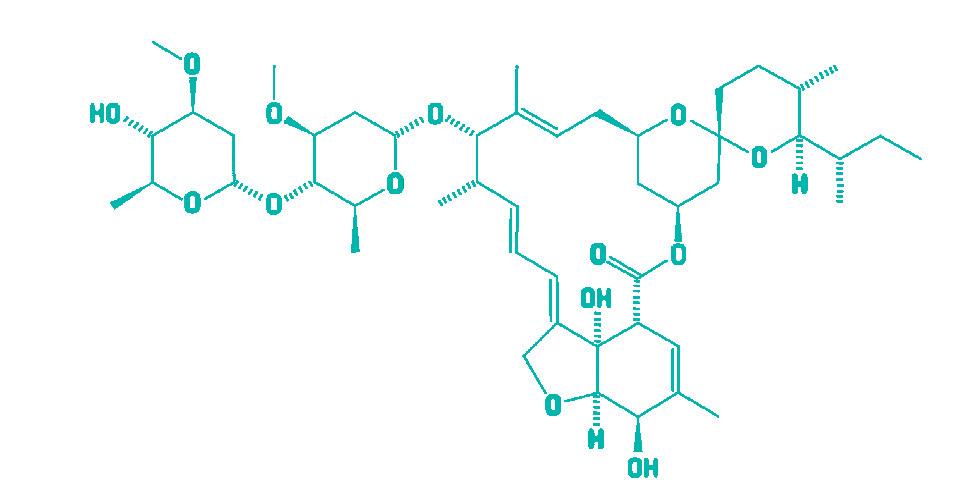
In an in vitro cellular model, when ivermectin was added at two hours post-SARS-CoV-2 infection, there was a roughly 5,000-fold reduction of viral genetic material at 48 hours.
Ivermectin also induces autophagy through an intracellular signaling path way called “AKT/mTOR.”
Resveratrol was first isolated from white hel lebore roots in 1940. This natural polyphenol has been detected in more than 70 plant species, such as grapes, apples, raspberries, blueberries, pista chios, plums, peanuts, and a multitude of medicinal and edible plant species used in traditional Chinese and Japa nese medicine.
Studies have attributed many health-promoting effects to resvera trol, including anti-inflammatory, an tioxidant, neuroprotective, cardiopro tective, antiproliferative, antitumor, anti-aging, and antiviral properties, as well as the ability to relieve neu ropathic pain.
Resveratrol has been used as a di etary supplement by people with a variety of conditions, including cardio vascular diseases, Alzheimer’s disease, diabetes, and menopausal symptoms.
Unsurprisingly, it has attracted in creasing interest from researchers and scientists wanting to explore its potential benefits for COVID-related conditions and vaccine injuries caused by spike proteins.

The spike protein is the primary mech anism for the virus to infect our cells. The binding of the spike protein to the ACE2 receptor is the first step.
Scientists often use computer model ing to mimic the interaction of a mole cule with a protein, known as molecu lar simulation or molecular docking. In molecular simulation studies, resvera trol has revealed highly stable bound conformation to spike proteins and the ACE2 complex.
Another molecular docking study also offers evidence that resveratrol can bind spike proteins, ACE2, and the ACE2: Spike complex with good affinity.
Based on these study results, resvera
trol has a high potential to disrupt the spike’s initial binding process with the cells. This is the earliest and perhaps the most efficient interventional step, as resveratrol helps prevent the toxic protein from entering our cells.
Once the spike proteins have bound to the ACE2 receptors and pathologi cal outcomes are generated, the sec ond key strategy to treat long COVID or vaccine-related injuries is to detox the spike proteins from our body.
To achieve this, boost your body’s self-cleaning process—autophagy, which is the body’s natural and effi cient cellular recycling and regenera tion process.
Resveratrol-induced autophagy has been suggested as a key process in me diating many of the beneficial effects of resveratrol.
After we eat, mTOR, a protein, senses cellular energy and nutrients. When we have a lot of nutritional material in our cells, mTOR tells the body to pro duce more energy, and autophagy is decreased. In the case of spike-invaded cells, the mTOR is over-activated and working overtime, and our cells’ clean ing process is turned off. When a lot of
Mulberries
Lingonberries
Cranberries
waste accumulates inside the cells, our cells become sick.
Our nerves are more sensitive to the self-cleaning process, as most of them are born with us and will stay with us for much longer than other parts of our bodies. So self-cleaning is of crucial im portance to our brains. This is perhaps
5 mg per 100 g
3 mg per 100 g
1.92 mg per 100 g
Red currants 1.57 mg per 100 g
Bilberries
Blueberries
Peanuts
0.67 mg per 100 g
0.383 mg per 100 g
1.12 mg per 100 g
Pistachios 0.11 mg per 100 g
Fresh grapes
0.24 to 1.25 mg per cup (160 g)
Red grape juice 0.5 mg per liter
a key reason why 50 percent of longCOVID symptoms—including brain fog, cognitive decline, anxiety, and depression—are neuropsychiatric.
Resveratrol can recover autophagy by inhibiting mTOR and letting the cells take a rest and do the cleaning.
Spike proteins can drive NLRP3 inflam masome activation in human organs, which is a major driver of neurode generation, cardiac injury, and even multiple organ failure.
Inside human cells, there’s a dam age-sensing protein. It’s normally dormant, but when the cells become damaged or infected with a virus, it’s activated and begins to form an in flammasome.
When the inflammasome is assem bled, it activates a type of molecular scissor, which trims other dormant
proteins into activated forms.
One dormant protein activated by trimming punches holes in the cell’s membrane. Other proteins trimmed by the protein are released by the cell to recruit inflammatory cells and drive inflammation.
Fluid flows through the holes into the cell, causing the cell to burst. When a cell bursts, many microbes can’t rep licate and more inflammatory media tors spill out into the affected tissue.
Inflammatory mediators released by the cells attract immune cells from blood vessels. These cells include phagocytes, which are garbage collec tors, cleaning up debris, microbes, and dead cells so tissue repair can begin.
The inflammatory pathway usual ly restores our health. But when this pathway keeps firing, it can cause a myriad of diseases, such as neurode generation, cardiac injury, and organ failure.
Resveratrol inhibits NLRP3 inflam
masome activation by preserving mi tochondrial integrity and augment ing autophagy. Severe viral infection is often associated with cytokine storms and immune dysregulation, and resveratrol acts as an anti-in flammatory agent by decreasing in flammatory cytokines (e.g., C-reactive protein and tumor necrosis factor) and increasing anti-inflammatory molecules in humans.

On the surface membrane of our cells, a group of receptors senses the signals of pathogens (viruses, germs, para sites) or toxic components of these pathogens. These receptors have an in teresting name—“Toll-like receptors” (TLR)—containing the German word “toll,” which means “great” in English.
Different types of TLRs identify dif ferent types of natural ligands from pathogens.
TLRs 3, 7, 8, and 9 detect microbial nucleic acids, including double- and single-strand RNA from RNA viruses and DNA from viruses or germs.
TLRs 1, 2, 4, 5, and 6 bind to com ponents of microbial cell walls and membranes unique to pathogens. TLR4 recognizes lipopolysaccharides (LPS), a pathogenic component of the germ cell wall.
As a component of a virus, spike pro tein can activate TLR4 on the surface of cells. Spike proteins strongly bind with TLR4 and cause hyperinflammation in human immune cells.
TLR4 is naturally designed to detect LPS from gram-negative germs. Spike proteins are also a natural ligand of TLR4—again suggesting the wicked nature of this protein.
When misactivated by spike proteins, TLR4’s normal signaling pathway is dysregulated, and it directs the cells to go the wrong way. Dysregulation of TLR4 signaling has been shown to play a role in the initiation and/or progres sion of various diseases, such as isch emia-reperfusion injury (similar to the pathogenesis occurring in COVID-19 syndrome), atherosclerosis, hyperten sion, cancer, and neuropsychiatric and neurodegenerative disorders.
Resveratrol can deactivate the TLR4-re lated pathway to rectify the hyperin flammatory status of cells.
Resveratrol is naturally found in grapes and many berries.
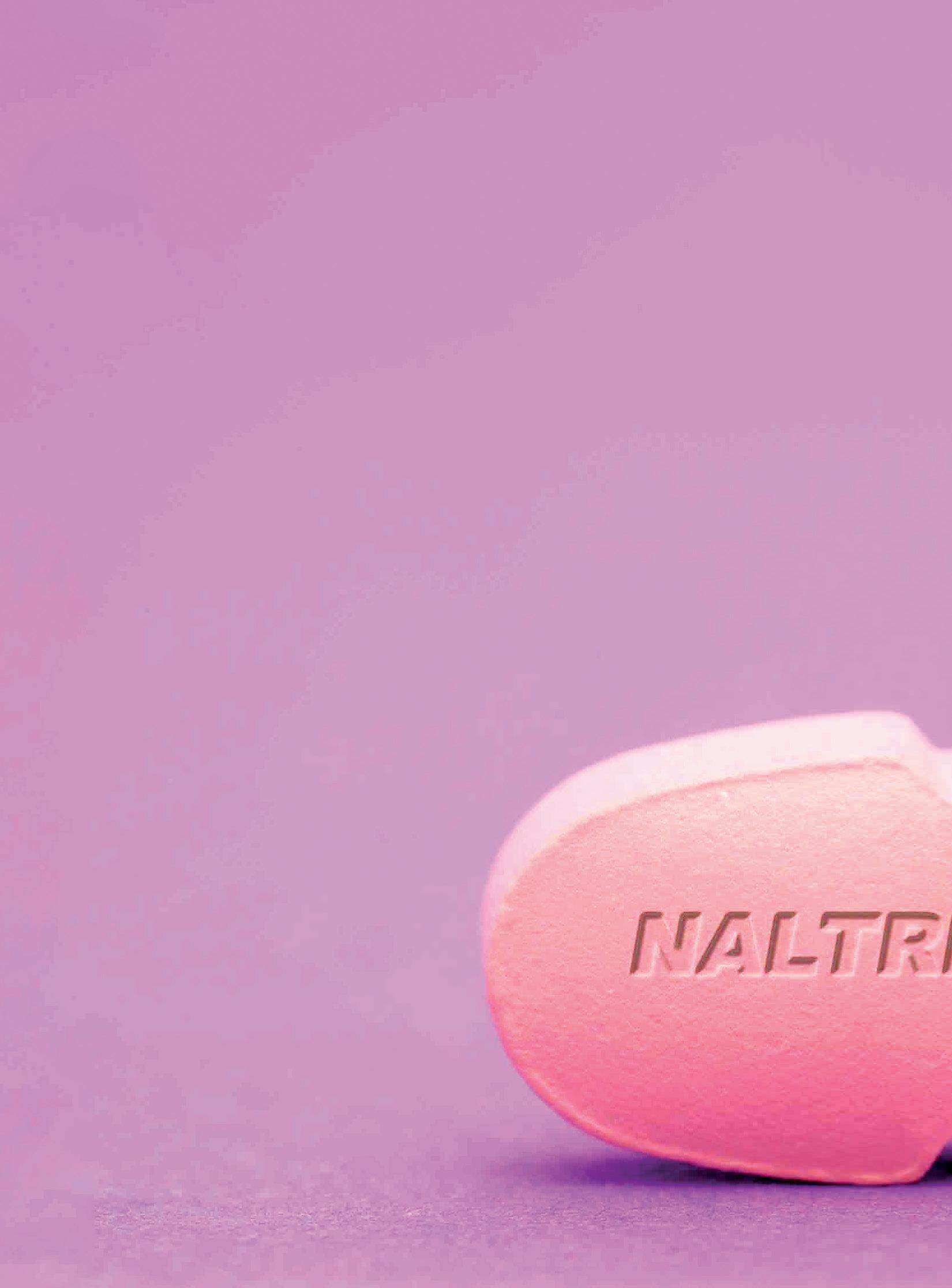
Marik said. “Low-dose naltrexone is a very potent anti-inflammatory drug. It’s been used in many chronic inflam matory diseases.”
both isomers have different thera peutic effects.
drug used to treat heroin addiction, but low doses are used for other illnesses
By Dr. Yuhong DongClaudia ann christian, a greatly successful Ameri can actress, suffered from alcohol addiction for more than a decade. She felt that something else was controlling her, as if she wasn’t in the “driver’s seat.”
She spent a fortune trying to find a cure in vain. Then, she discovered nal trexone and was able to overcome her alcoholism after using a single dose.
In 1984, the Food and Drug Admin istration approved 50 milligrams of naltrexone as a treatment for heroin addiction.
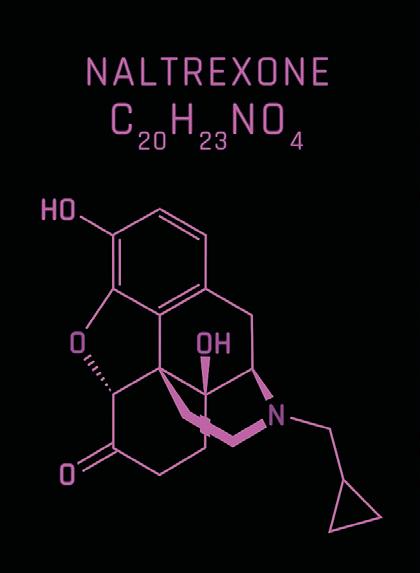
Later, people discovered that lowdose naltrexone (LDN) can also be used to treat other illnesses.
Due to the COVID-19 pandemic, long COVID and COVID-19 vaccine-related syndromes have become a major health concern in society.
In addition to ivermectin, research has discovered that low-dose naltrex one might be a good treatment for long COVID and vaccine injuries.
“We’ve been using it for many, many months,” Front Line COVID-19 Criti cal Care Alliance co-founder Dr. Paul

Naltrexone is initially used to treat withdrawal symptoms of opioid and alcohol addiction at doses rang ing from 50 to 200 milligrams per day, as this level of dose complete ly blocks both endogenous opioids (endorphins, the natural “happy hor mones”) and exogenous opioids (such as heroin).
Studies have shown that LDN acts on opioid receptors, increasing the level of endogenous opioids and stimulating the production of endorphins.
A 2008 study found that endorphins kept increasing even one month after stopping a dose of less than 5 milli grams of LDN.
Ninety percent of endorphins are ac tually secreted between 2 a.m. and 4 a.m., so we should sleep early and avoid staying up all night.
Opioid receptors exist in the human body in various subtypes, including one known as the opioid growth factor (OGF) receptor, and the OGF–OGF receptor axis pathway is involved in the regulation of tumor growth and proliferation.
When OGF binds to the OGF receptor (OGFr), cell proliferation will be altered.
Tumor growth is inhibited when the OGF–OGFr axis pathway is up regulated. Low doses of naltrexone upregulate the OGF–OGFr axis and
Low doses range from 0.5 to 4.5 mil ligrams per day, equaling 1/10 to 1/100 of the normal dose.
Every drug has two structures called iso mers that mirror each other (levo rotatory and dextrorotatory), just like the left hand and right hand of a per son. Usually, only one isomer provides a ther apeutic effect.
Naltrexone is unique in that
Naltrexone is a unique drug molecule in that both isomers have different therapeutic effects.
“Low-dose naltrexone is a very potent antiinflammatory drug.”Dr. Paul Marik, co-founder, Front Line COVID-19 Critical Care Alliance
therefore inhibit tumor growth and treat tumors.
It can also treat autoimmune diseas es. These include multiple sclerosis, Crohn’s disease, diabetes, and can cer, as well as mental disorders, all of which are associated with dysfunction of the OGF–OGFr axis.
Therefore, naltrexone has the po tential to be used to treat a variety of diseases.
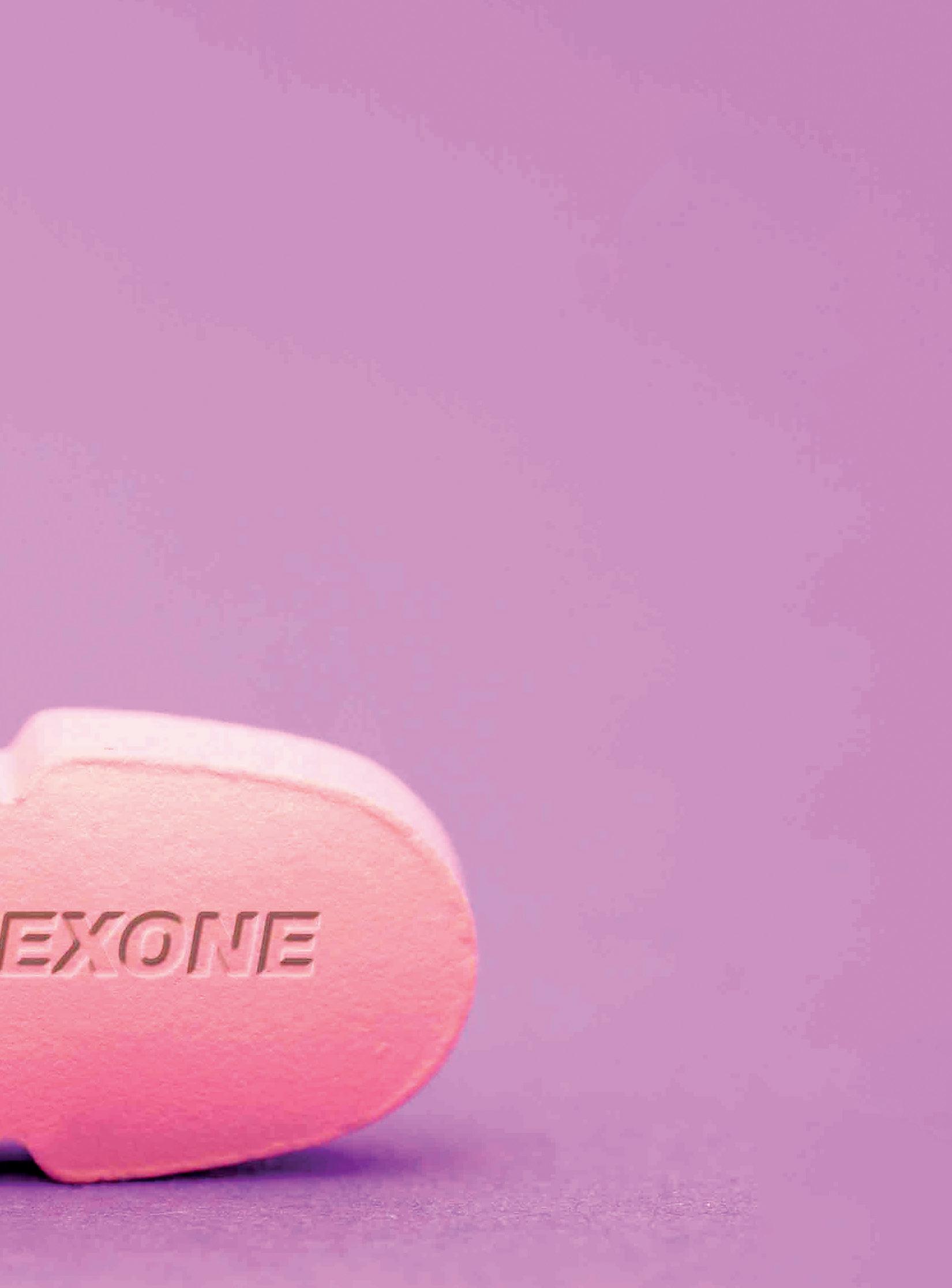
LDN Decreases Proinflammatory Cytokines, Increases AntiInflammatory Factors
A balanced immune system depends on the body’s ability to balance pro-inflammatory and anti-inflam matory factors.
Through multiple means, LDN can decrease pro-inflammatory cytokines and thus reduce inflammation.
A class of proteins called toll-like re ceptors is part of the immune system.
It provides the first line of defense against microbial invasion and has the ability to recognize and activate pathogens and endogenous sig naling molecules.
LDN can re duce toll-like receptor-4 sig naling and subsequently induce neu roinflamma tion, as well as potential ly rebalance the dysregu lated Th1 and
Th2 cytokine immune responses in COVID-19 conditions.
Th1 cytokines tend to respond to vi ral bacteria. Interferon γ is the main Th1 cytokine. Th2 cytokines, including interleukins 4, 5, and 13, are associat ed with the triggering of allergic and eosinophilic responses.
Therefore, LDN can be helpful in re ducing long COVID symptoms.
Spike proteins can decrease natural killer cells and inhibit their activity and reactivate latent viruses, further inhibiting the immune system, thus creating a vicious cycle. Other issues include damage caused by microvascu lar injury, mitochondrial dysfunction, autoimmune diseases, and so forth.
Theoretically, LDN can alleviate systemic inflammatory and neu roinflammatory diseases by inhib iting various inflammatory factors and reducing the body’s reaction to inflammations.
LDN inhibits the activation of mi croglia in the nervous system and reduces the toxic effects of reactive oxygen species and other potential ly neuroexcitatory and neurotoxic chemical production. Thus, it can pro tect the brain and nerve cells.
Based on previous dosing experi ence, patients could theoretically start with a small dose, slowly increasing it—starting with doses of 0.5 to 1.5 milligrams per day up to a maximum dose of 4.5 milligrams.
Methylene blue started its life as an industrial dye for textiles, but studies found that it has anti-viral properties.
 PHOTO BY NIRMAL YESUDAS/ EYEEM/GETTY IMAGES
PHOTO BY NIRMAL YESUDAS/ EYEEM/GETTY IMAGES
More than two years into the COVID-19 pandemic and more than a year since the COVID-19 vaccina tions rolled out, millions of people are still nursing themselves in the after math as they recover from spike protein injuries, whether it be from COVID-19 or vaccinations.
Many doctors put together recom mendations for treating long COVID and vaccine injuries based on clinical observations and published research.
Ivermectin, low-dose naltrexone, and resveratrol are at the top of the list as the go-to treatments. These treatments have been found to be the most accessible and generally bring out a positive response. They’re classified as the first-line treat ments by Front Line COVID-19 Critical Care Alliance (FLCCC).
However, a smaller group of people may not respond to the typical firstline treatments or may respond with remaining unresolved conditions.
That’s when doctors bring out treat ments that are considered to be “second line.” These treatments are typically more aggressive and targeted, mean ing that they could work very well but for a smaller group of people. They can also be more expensive and harder to self-administer.
Dr. Yusuf Saleeby, integrative medical doctor and director of Carolina Holis tic Medicine, shared some of the treat - ments he would consider second line that he uses in his clinic.
Saleeby, along with other doctors treat ing spike protein injury, including Dr. Paul Marik and Dr. Pierre Kory, both previously interviewed by The Epoch
Times, understand spike protein inju ry as a syndrome rather than a disease since it’s precipitated by dysfunctions in many overlapping pathways.
Marik is a former professor of medi cine and chief of pulmonary and critical care medicine at Eastern Virginia Medical School. Kory is a former chief of the crit ical care service and medical director of the Trauma and Life Support Center at the University of Wisconsin.
Therefore, treatments for spike-pro tein-induced disease aim to address the overlapping mechanisms to resolve the system together.
The first line of treatments particular ly focuses on promoting autophagy to clear out the spike proteins. The second line of treatments is more directed at reducing its toxicity by resolving the different pathways.
Methylene blue (MB) has been recom mended by many doctors as a priority second-line treatment because of its antiviral, anti-inflammatory, and anti oxidizing properties.

“It’s kind of an interesting compound,” Saleeby said.
MB started as an industrial dye for textiles; it was later used to stain cells under the microscope, and scientists noticed that parasites would die when stained with MB.

“So they found heavy anti-parasitic properties,” Saleeby said.
MB has been used to treat malaria and urinary tract infections and is most well known for its use in methemoglobin emia, a condition in which the red blood cells can’t carry oxygen because of the loss of an electron on its iron group.
Scientists also discovered its antiviral properties; it’s quite effective, particu larly when used in conjunction with light therapy. MB has antiviral properties
Oxytocin affects the brain but also has receptors in the heart, kidney, uterus, breasts, and testes.
against SARS-CoV-2, Ebola, herpes sim plex virus, Zika viruses, and many more.
Although recommended as a sec ond-line treatment for spike pro tein-induced diseases, MB actually carries first-line spike-protein-injury treatment functions.
First-line treatment focuses on clear ing out spike proteins, and MB is also able to help spike-infected cells remove spike proteins by degradation and re cycling of cellular and mitochondrial materials. These two processes are also known as autophagy and mitophagy, respectively.
MB can also bind to spike proteins, prevent their entry, and neutralize spike toxicity. Most importantly, it has specific roles in restoring mitochondri al function, improving the health and energy of the cells.
MB is an antioxidant and prevents damage by neutralizing reactive ox ygen species. Mitochondria are also the greatest producer of these oxy gen species, particularly when they’re stressed. MB therefore can neutralize the damaging oxidants they produced, preventing further damage and stress.
MB can also donate its own electrons to mitochondria’s metabolic pathway to promote energy production.
MB is therefore highly useful for restoring mitochondrial dysfunction and cellular health. Since it improves cellular function, it’s also neuropro tective, with studies suggesting that it may reduce cognitive decline.
It’s recommended to alleviate neuro logical symptoms related to brain fog, fatigue, memory, and cognition, which are common spike injury symptoms.
MB also functions as an antioxidant and contributes to anti-aging.
A laboratory study on human skin cells shows that the cells exposed to MB increased in proliferation and also had delayed senescence. Another in vi tro study found that MB reduced DNA damage in human cells when they were exposed to ultraviolet light and there fore reduced cell death.
The product is highly accessible; however, people wanting to take MB should take care that they’re using pharmaceutical-grade MB rather than industrial or research grade.
“You can get the dye at the industrial level that they use as a dye which could be contaminated with heavy metals and a lot of other junk,” Saleeby said.
Convention.
“Then there’s research-grade, to be used in vitro and things for research.”
The safest grade are those that meet the standard of the U.S. Pharmacopeial Convention.
“There are a couple of places you can get [purchase] that or you can have it compounded at a compounding phar macy, [the pharmacist can] just write a prescription for say, a 30 ml bottle of 1 percent methylene blue solution and that will be for human consumption or veterinary consumption,” Saleeby said.
Methylene blue isn’t recommended for pregnant and breastfeeding wom en and people with G6PD deficiency. For people taking selective serotonin reuptake inhibitors (SSRI), methylene blue can interact with SSRIs, potential ly leading to serotonin syndrome—a critical condition.
People with kidney or liver prob
lems should check with their pri mary care physicians. Herx reac tion—short-term detoxification response—may occur in people with Lyme disease or fungal diseases.
Colloquially known as the love hor mone, oxytocin is often associated with happiness, love, and emotional bonding.
However, oxytocin doesn’t only af fect the brain but also has receptors in the heart, kidney, uterus, breasts, and testes and therefore plays much bigger roles than contributing to happiness.
The FLCCC protocol currently rec ommends oxytocin nasal sprays for spike-injured people with brain fog, tinnitus, and a loss of smell.
Saleeby found that oxytocin was very effective for people with neuropsychi atric problems such as depression and anxiety. It also helped to improve emo tional relationships.
“With the lockdown, you had a lot of social distancing, and people for got how to socially interact with each other and that’s problematic,” Saleeby said. “This is actually helpful in re bounding as a bonding, reestablishing

The safest grade of MB are those that meet the standard of the U.S. Pharmacopeial (USP)
Dr. Yusuf Saleeby, integrative medical doctor and the director of Carolina Holistic Medicine.
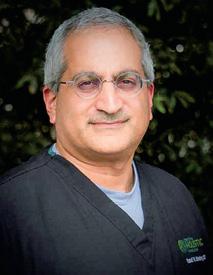
promote mitochondrial function, and also increase immune function.
It can reduce inflammation by lower ing cortisol, the stress hormone. Corti sol causes inflammation and inhibits digestion, reproduction, and growth. In prolonged states of stress, the immune system may also be inhibited, leading the person to become more susceptible to infections.
Oxytocin could reverse this action. Studies in animals show that the hor mone also has anti-aging properties. Stud ies in rats show that increasing oxytocin by increasing social interaction increased the length of telomeres. Since telomeres shorten as we age, this extension is sug gestive of anti-aging properties.
Despite these benefits, “a lot of [oxy tocin’s mechanism of action] is poorly understood. We just know that it works, especially with behavioral things like bonding,” Saleeby said.
Saleeby also recommends nutraceuti cals such as vitamins and adaptogens as both first- and second-line treatments for spike protein injuries.
Adaptogens are herbs that can work as medicine; this includes curcumin, certain types of mushrooms, and var ious plants.
An adaptogen Saleeby often recom mends for COVID-related conditions is Andrographis paniculata; both re search and his own clinical observations have found the herb to be effective for preventing COVID-19, treating COVID-19, and also for spike injuries.
Many nutraceuticals such as magne sium, vitamin D, vitamin C, and ome ga-3 oils are also recommended as second-line treatments by doctors to improve individuals’ immune function and reduce inflammation.
Magnesium, vitamin D, vitamin C, and omega-3 are linked with anticoagulant effects and may prevent the formation of blood clots. These nutraceuticals also strengthen immunity and reduce in flammation.
Studies have shown that magnesium, vitamin D, and vitamin C play import ant roles in inhibiting mast cell acti vation, thereby reducing debilitating conditions of inflammation.
Omega-3 fatty acids have cardiac pro tective properties; studies show that it reduces the risk of heart arrhythmia and all-cause mortality in people with un derlying coronary disease. It’s therefore recommended for patients with cardiac problems, including myocarditis.
Both vitamin D and omega-3 are also recommended for hair loss following vaccination.

Saleeby advised that for magnesium, patients must seek out organic magne sium such as magnesium citrate, mag nesium glycinate, magnesium taurate, magnesium threonate, and magnesium malate. The body has a very difficult time breaking down inorganic mag nesium such as magnesium oxide and, therefore, little magnesium is actually being absorbed.
humans and social connections.”
He also prescribes it for people with reproductive problems, such as erectile dysfunction in males and anorgasmia in females. He also uses oxytocin as a last resort treatment to improve bone health when common treatments such as calci um, vitamin D, and vitamin K2 all fail.
“It’s probably one of the most ignored hormones out there,” Saleeby said.
Oxytocin is rarely prescribed, since it needs to be refrigerated to prevent degradation, regardless of whether it’s in powder or solution, making it less practical for daily use. Oxytocin nasal sprays found in supermarkets and on line stalls are thus likely not effective, Saleeby cautioned.

Yet the multifaceted roles oxytocin plays can often make up for its logistic annoyances.
Oxytocin can inhibit mast cell action,
The main bioactive component of A. paniculata is andrographolide, which is known for its broad anti-viral and anti-in flammatory effects. Studies have shown that it can work against the common cold and fevers, as well as more threatening viruses, including influenza virus, SARSCoV-2, dengue virus, and HIV.
A laboratory study shows that andro grapholide can bind to spike proteins, as well as the other proteins of the COVID-19 virus, to prevent viral entry and spike toxicity. Another laboratory study on hu man lung cells shows that A. paniculata and andrographolide could prevent and fight off COVID-19 infections.
“Government in Thailand, early on in the pandemic ... actually condoned [A. paniculata], recommended it to the peo ple of their nations to use it with zinc, with vitamin C, with vitamin D to help with COVID,” Saleeby said.
For all vitamin nutraceuticals, Salee by recommended getting pharmaceuti cal-grade supplements rather than easi ly accessible ones from the supermarket or pharmacies.
“I would stick with pharmaceuti cal-grade vitamins in general,” he said. “Ninety percent of the fish oil that you get over the counter is what’s leftover from making the pharmaceutical grade.
“You can’t go wrong if you use one of these high-end pharmaceutical grade companies.”
Nutraceuticals softgel capsules.
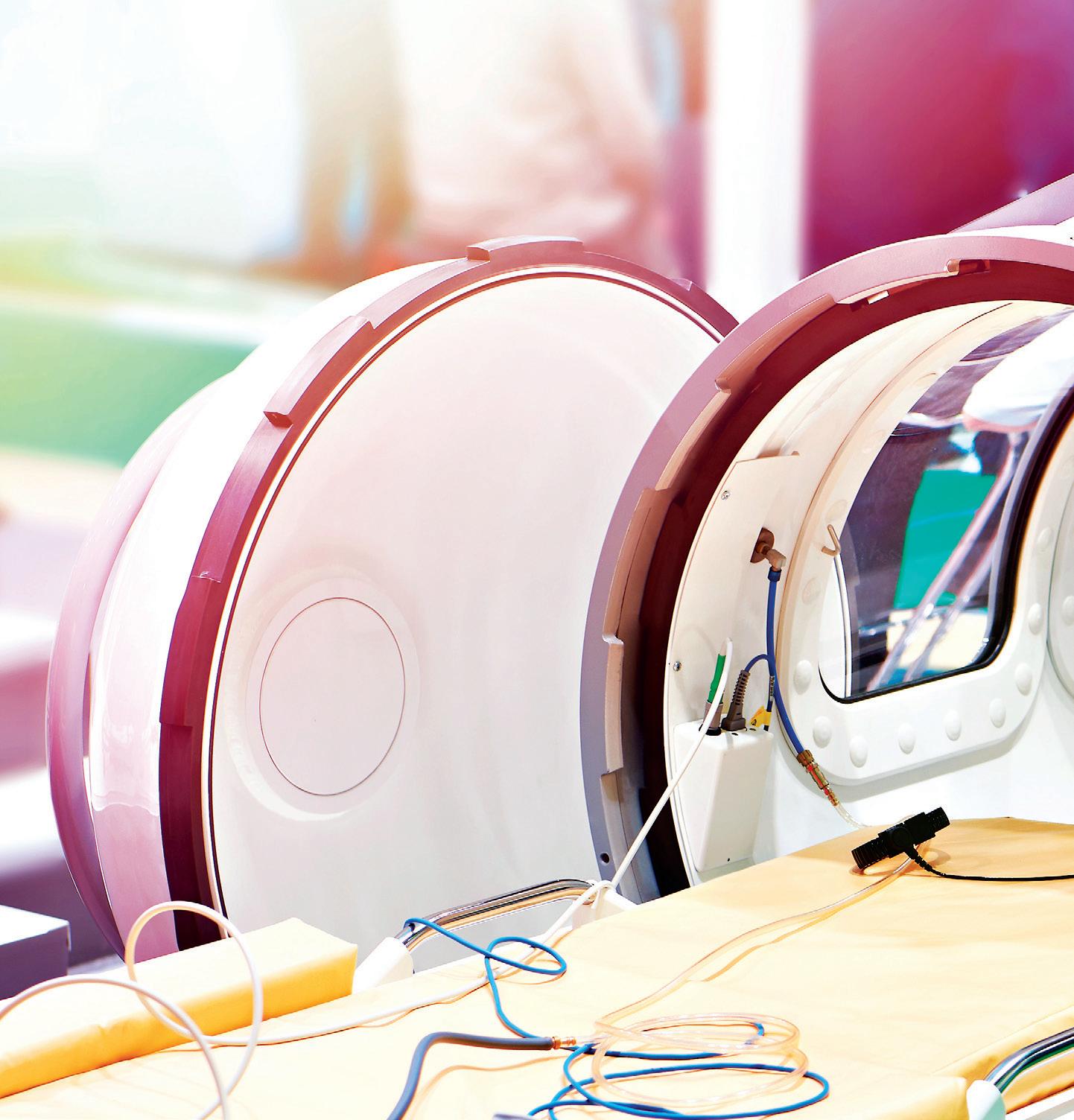 BY MARINA ZHANG
BY MARINA ZHANG
Hyperbaric oxygen therapy (HBOT) is a treatment that increas es blood oxygen levels to boost wound healing and clear bacterial infections. Recent studies and doctors’ clinical experi ences suggest that it may be useful for treating long COVID and COVID-19 vaccine injury.
“When I first heard about [HBOT] I thought, ‘This is goofy,’” said Dr. Paul Marik, co-founder of Front Line
COVID-19 Critical Care Alliance (FLCCC).
Then, Marik encountered a compet itive cyclist patient who became bed ridden after COVID-19 vaccinations.
“He was completely incapacitated,” he said. “He went for hyperbaric ox ygen, [and] within about five or six sessions, [he] was back on his bicycle.”
Marik told The Epoch Times that some patients who have spike-pro tein-induced injuries have respond ed particularly well to hyperbaric oxygen.
HBOT involves patients breathing in 100 percent pure oxygen in a cham ber at an atmospheric pressure high er than normal sea level (1 standard atmosphere).
Since oxygen normally only makes up about 21 percent of air, the increased pressure of pure oxygen further in creases oxygen levels in the blood.
Depending on the pressure admin istered, blood oxygen levels can be in creased to three times the normal level.
The treatment is mostly used for wound healing, including both inter nal and external wounds.
Cells need oxygen to function. Mi tochondria use oxygen to break down sugars into energy, so increased blood oxygen levels drive tissue growth and regeneration. Increased oxygen levels also clear bacterial infections.
HBOT is currently approved as a treatment for 15 different wounds and health conditions, including carbon monoxide poisoning, tissue damage,

blood loss, burns, skin grafts, soft tissue infections, and intracranial abscesses.
Outside of the United States, Russia lists 70 diseases that can be treated by HBOT, China lists 49, and Japan lists 33.
Dr. Paul Harch, a renowned HBOT expert and founder of Harch Hyper barics, said at the FLCCC conference in Kissimmee, Florida, that a major underlying pathology of wounding is inflammation; HBOT repairs wound ing by reducing inflammation and promoting regrowth.

For Hyperbaric oxygen therapy, the higher the oxygen pressure, the greater the change in gene expression and the higher the general benefit.
Since inflammation is an underly ing pathology for many diseases, this makes HBOT conceptually applicable for various conditions, even wounding from diabetes, which is a metabolic dis ease driven by inflammation.
In a study published in 1987 on HBOT, the authors listed 132 medical conditions that can be treated using this therapy.
Harch said he has treated 90 to 100 different conditions with HBOT, with the majority of the medical conditions being neurological injuries.
HBOT reduces inflammation by influ encing epigenetics.
Epigenetics are factors that change gene activity. Depending on environ mental factors including stress, diet, drugs, and treatments, certain genes can be activated or suppressed.
“Surprisingly, it is the increased pres sure, rather than the increase in the concentration of dissolved oxygen, that
appears to mediate these effects,” the FLCCC doctors wrote in their treatment recommendations.
For HBOT, the higher the oxygen pressure, the greater the change in gene expression and the higher the general benefit.
Therefore the FLCCC recommends the use of HBOT at a high atmospher ic pressure. But treatment regimens need to be monitored by a clinician to prevent oxygen toxicity.
An in vitro study on human micro vascular cells found that cells exposed to an HBOT treatment at 2.4 standard atmospheres for 60 minutes had changes in gene expression in 8,101 genes 24 hours later.
HBOT increased the expression of an ti-inflammatory genes and reduced the activity of pro-inflammatory genes.
Since cells exposed to pure oxygen at normal atmospheric pressure had “minimal change” in their gene expres sion, this demonstrated that pressure is the key player in the overall therapy.
Another study on rats further indi cates the importance of pressure. The study shows that depending on the pressure of the environment, differ ent numbers of genes were expressed.
The authors of the study exposed rats to normal air and pure oxygen at nor mal atmospheric pressure and higher pressures. The data show that in rats, an increase in oxygen levels caused an increase in gene expression.
HBOT is currently recommended as a third-line treatment for post-COVID vaccine symptoms, coined under the umbrella term of post-COVID vaccine syndrome.
FLCCC doctors reason that both long COVID and post-COVID vaccine symp toms are driven by chronic exposure to spike proteins, which promote im mune dysregulation and inflamma tion. It, therefore, makes conceptual sense that HBOT may work as a poten tial treatment.
Studies show that HBOT could reduce inflammatory pathways and reduce the
KATERYNA KON/SHUTTERSTOCK FROM L: CHRIS HONDROS/GETTY IMAGES,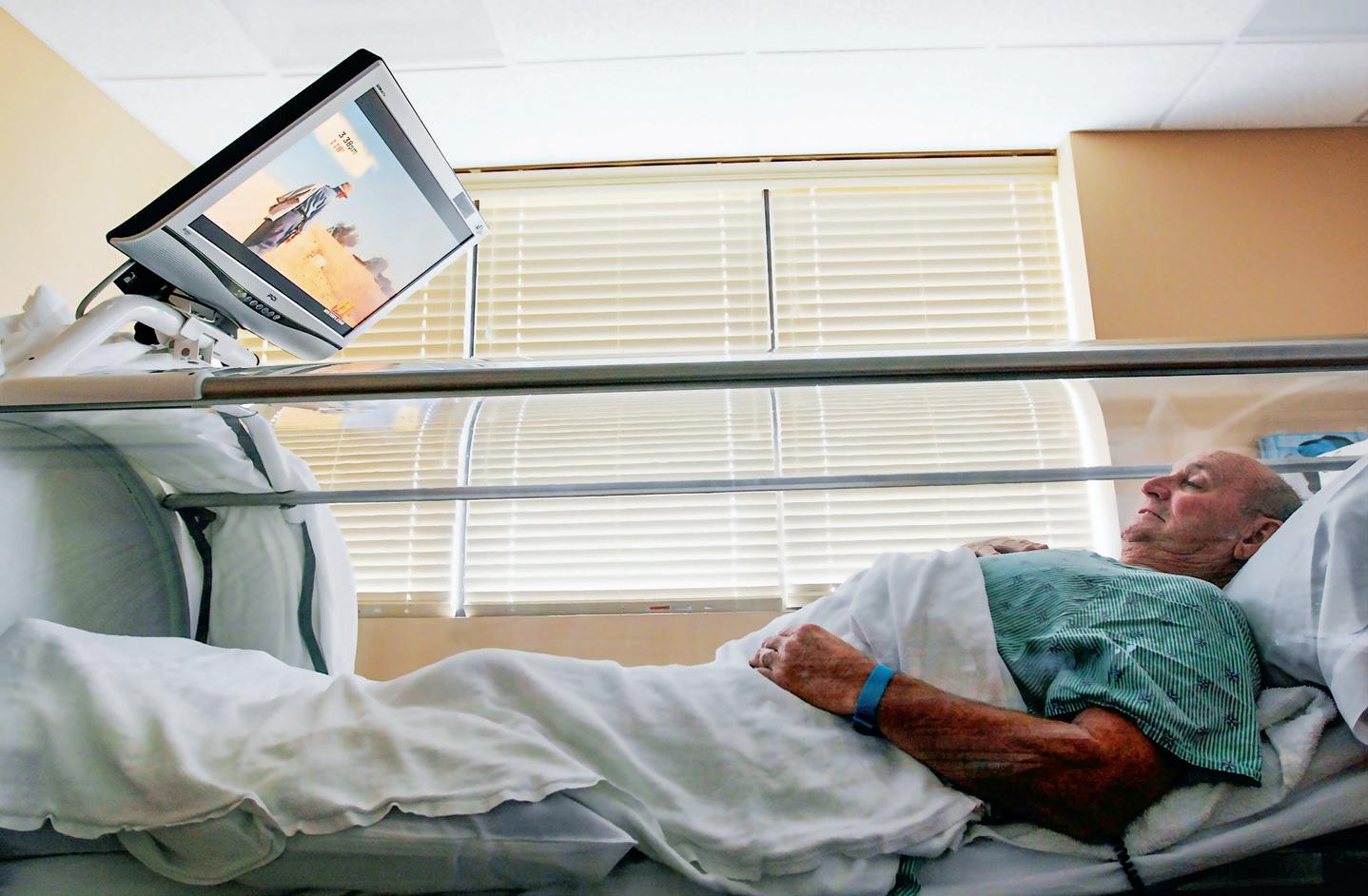
action of pro-inflammatory toll-like re ceptor pathways, both of which are often activated in acute COVID-19 infections and spike-protein-induced diseases.
HBOT has also been shown to help with fatigue, which is often a sign of mitochondrial dysfunction.
Mitochondria are responsible for breaking down the sugar we ingest through our food and converting it into energy; and it uses oxygen as a key reactant of this biochemical process.
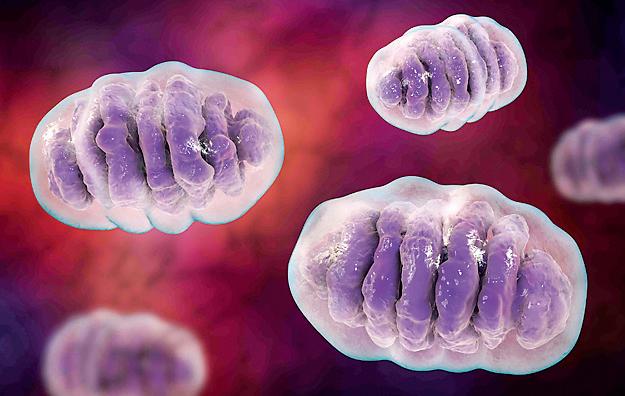
During inflammation experienced in long COVID and post-COVID vaccine syndromes, the spike proteins can stress the mitochondria in the cell, leading to reduced energy production and more production of damaging radical species. The extra oxygen provided through HBOT treatment gives ample material for use by the mitochondria to increase energy production for the body.
HBOT also induces the release of stem cells and tissue growth factors.
Many studies found the treatment to be beneficial in promoting tissue regeneration, including the regener ation of muscle cells and the genera tion of new blood vessels. This indicates that HBOT can help in the repair of spike-protein-induced tissue damage.
Neurological symptoms are some of the major symptoms in long COVID and post-COVID vaccine symptoms. There are also studies that show that HBOT enhanced neurogenesis, al though HBOT hasn’t been approved by the Food and Drug Administration for such treatment yet.
Harch has had successes in treat ing wounds in the brain, including a near-reversal of brain damage in a drowned 2-year-old girl in 2017.
The girl had suffered from a deep brain injury and had “no speech, gait, or responsiveness to commands with constant squirming and head shaking” he said.
But following 40 sessions, the girl had near-normal motor function; normal cognition, gait, and temper ament; and improvement on nearly all neurological exam abnormalities. Her speech improved to a greater lev el than pre-drowning, and she also discontinued all of her medications, according to a statement by LSU Health New Orleans.
Studies have also found that HBOT treatments increased blood flow and induced microstructural changes; this
low oxygen in patients with COVID-19. The study was stopped after the inter im analysis of 40 patients’ outcomes. The differences between the treat ment and the nontreatment group were obvious.
Patients treated with HBOT had im proved blood oxygen levels in three days, compared to the nontreatment group, whose levels improved in nine days.
In particular, studies on long COVID show that HBOT has a significant im pact in treating fatigue and brain fog by improving attention, memory, infor mation processing, and mental health.
In an Israeli study published in July on 73 long COVID patients, half (37) were treated with HBOT and the other half (36) with a placebo. The patients re ceived treatments five times per week, and the protocol included breathing pure oxygen by mask at two standard atmospheres for 90 minutes.
The authors noticed improvements in the HBOT treatment group in glob al cognitive function, attention, and executive function, with significant improvements in energy, sleep, men tal health, and reduced pain.
Brain scans of these patients also showed improved blood flow in certain areas of the brain.
led to improved brain function, includ ing cognitive functions, gait, and sleep.
Studies on HBOT therapies have shown them to be beneficial against COVID-19 and long COVID. There’s much litera ture on HBOT that find positive out comes in treating COVID-19 infections.
A 2020 U.S. study on five COVID-posi tive patients found “dramatic improve ment with HBOT,” according to the au thors of the study.
All of the COVID-19 patients pre sented low oxygen levels, rapid breathing, and inflammatory mark ers. After one to six sessions of HBOT, inflammatory markers fell and the rapid breathing ceased.
“Most importantly, HBOT potential ly prevented the need for mechanical ventilation,” the authors wrote.
In a randomized controlled study in Argentina, HBOT was used to treat
The FLCCC recommends HBOT as a third-line treatment, as it’s consid ered to be a treatment that “may be lifesaving for one patient and totally ineffective for another.”
Marik noted that the high cost of the therapy and the differences in pathophysiology may make the treat ment not suitable for everyone. He currently recommends HBOT only for severe neuropathologies in pa tients suffering from post-vaccine syndromes, particularly peripheral neural pain. Contraindications for this treatment include people with untreated pneumothorax.
HBOT is currently approved as a treatment for 15 different wounds and health conditions, including carbon monoxide poisoning, tissue damage, blood loss, burns, skin grafts, soft tissue infections, and intracranial abscesses.
One of the most dev astating aspects of COVID-19 is that it can continue to affect pa tients for months—and even years—after infection.
Ask Carrie Anna McGinn. After a year of fighting off symptoms, Maclean’s Magazine reports that she continues to battle a cough, cognitive dysfunction, and pain.
While most patients successfully fight off the symptoms of COVID-19 within a few days, some continue to experience symptoms long after infec tion. When symptoms last longer than two months, persistent symptoms are diagnosed as post-COVID condition, also called long COVID.
But one aspect of long COVID that’s still developing is its pathophysiolo gy—the why behind how long COVID symptoms occur. This may actual ly be the most interesting piece: What’s COVID-19 doing to the body that makes symptoms last for months or years?
You might not realize how serious inflam mation can be.
Inflammation is a natural bodily re sponse when some thing goes wrong in the body. Basically, your body sends white blood cells, cytokines, and other immune cells to try to fight off infection or repair tissue. When those cells take effect, they start to repair tissue and get rid of toxins.
It’s this “fight” between your body’s protective cells and the harm ful ones that causes inflammation.
Acute inflammation lasts just a little while. For example, imagine you twist your ankle. Your body sends out repair cells to the area. As the tissue is being repaired, there’s some inflammation in
the ankle. Once the tissue is repaired, the inflammation dissipates.
Chronic inflammation happens when an inflammatory response lasts for a long time. It occurs because the cytokines and white blood cells, which contribute to inflammation, don’t dis sipate. When inflammation becomes chronic, white blood cells can end up attacking both bad cells and good, healthy cells from your own body. It’s kind of like “friendly fire.”
One theory of long COVID is that it causes a kind of chronic inflammatory
The body’s immune system is set up to protect itself against infections. But sometimes, immune cells mistakenly begin targeting the body itself instead of infections. That’s called an autoim mune response.


Allergic reactions are autoimmune responses. Autoimmune responses are also behind a number of other condi tions, including lupus and rheumatoid arthritis.
Autoimmune responses are actually
The pathophysiology of why COVID symptoms can persist for months, or even years, is still developing.
pens with long COVID: The COVID-19 virus may trigger an autoimmune response and that response may be responsible for the long-lasting symptoms of long COVID.
Autoantibodies are proteins in your immune system that mistakenly tar get your body’s own tissues. Autoan tibodies can be caused by a number of viruses, including Epstein-Barr virus, herpes virus 6, hepatitis A and C, and rubella virus.
So one possibility is that SARSCoV-2, the COVID-19 virus, also cre ates autoantibodies. Those autoan tibodies, in turn, may continue to plague the body long after the virus itself is gone.
A third theory for the cause of long COVID is that the virus was never properly eliminated from the body in the first place. In other words, there’s a “reservoir” of the virus that continues to cause symptoms long after most people are back to normal.
There are a few pieces of evidence for this theory.
Some research has also found that while SARS-CoV-2 replicates in the lungs, nose, and throat, it can also replicate in cells in the small intes tine. Multiple studies have reported that SARS-CoV-2 viral RNA has been
detected in stool samples even after the virus is cleared from the naso pharynx.


Viruses can also find their way into the brain and live there relatively safe ly. Part of the reason for that is that the brain isn’t as easily accessed by the immune cells that would fight off the virus. Some research has found SARSCoV-2 in brain tissue—it may be that it’s able to live there and continue to cause symptoms.
Another piece of evidence for virus reservoirs is that the immune cells continue to adapt and become more potent over time in individuals with long COVID. This continual mutation of the immune cells is consistent with the persistence of an antigen.
Mitochondria are little organs with in tissue cells. They’re commonly referred to as the “powerhouse” of cells because their main job is to produce energy. Most cells in our body have mitochondria, but cells that require more energy—such as those in the retina, heart, muscles, and brain—have substantially more mitochondria.
Since mitochondria are so import ant to providing cells with energy, damaging them may help explain symptoms such as fatigue, muscle weakness, and some of the mental deficits such as brain fog.
1. The virus causes chronic inflammatory response.
2. The virus triggers an autoimmune response.
3. The virus was never properly eliminated from the body in the first place.
4. The virus damages mitochondria.
When inflammation becomes chronic, white blood cells can end up attacking both bad cells and good, healthy cells from your own body. It’s kind of like ‘friendly fire.’
A woman hugs her grandmother through a plastic drop cloth amid the COVID-19 pandemic in Wantagh, N.Y., on May 24, 2020.

Why do some people get long COVID but not others? Why do some people report adverse events after COVID-19 vaccinations while some don’t? This question is central to the controversy of COVID-19 vaccine ad verse events, and doctors treating these symptoms have identified several fac tors that contribute to an increased risk of spike protein injury.
“The more the patients are exposed to spike [proteins], the more severe the dis ease,” said Dr. Paul Marik, critical care specialist and co-founder of Front Line COVID-19 Critical Care Alliance (FLCCC). Spike proteins from vaccination have been observed to be present even at nine months following vaccination, so
subsequent doses and boosters could lead to more spike protein production and, therefore, higher risks of disease.
Dr. Pierre Kory, co-founder of FLCCC, who now has a clinic for treating long COVID and vaccine injury, said he no ticed his patients with either of these conditions would appear to worsen with subsequent spike protein exposures.
He recommended that his patients avoid opportunities that may lead to spike protein exposure, lest their symp toms get out of control.
Not all vaccine vials are made equal.
How Bad is My Batch is a website that compiles data on adverse events from the Vaccine Adverse Event Reporting System (VAERS) on COVID-19 vaccina tion. By separating each adverse event into its corresponding vaccine batch, the website has shown that some vials are
likely different from others, as they’re associated with a greater number of adverse events, deaths, and disabilities.
This could be due to impurities in the vaccines.
Leaked emails from staff in the Euro pean Medicines Agency show that the agency only asked for 50 percent mRNA integrity in their Pfizer vaccinations.
By Marina Zhang FROM L: AL BELLO/GETTYHowever, potential issues could also be due to the dosage; some vials may have a higher mRNA or DNA spike pro tein content than others. Currently, doctors have no way to verify what’s in the vials.
“There’s a genetic predisposition,” Marik said. “If someone in the family is vaccine injured, it is very common that the broth ers of that individual ... [will also become] vaccine injured, so there are genetic fac tors which we don’t understand.”
Not all vaccine vials are made equal
Marik has observed that certain ge netic mutations may also put them at a greater risk of COVID-19 vaccine injury.
This included individuals with a methylenetetrahydrofolate reductase (MTHFR) gene mutation and those with Ehlers-Danlos type syndromes.
Approximately 40 percent of people in the United States carry or are af fected by the MTHFR mutation. It’s an enzyme responsible for transforming folate (vitamin B9) into its active form.
Folate plays a role in breaking down homocysteine—an amino acid that’s toxic in higher concentrations—to me thionine, a useful amino acid.
Depending on the type of the MTH FR mutation and the number of copies a person carries, the MTHFR enzyme function can be moderately or severe ly reduced.
This can put a person at a higher risk of folate deficiencies, which also increases a person’s risk of severe COVID-19 such that homocysteine levels have been directly predictive for worsened COVID-19 outcomes.
Metabolic diseases, especially high blood pressure and Type 2 diabetes, have been associated with severe symptoms in COVID-19 infections and vaccinations.
Dr. Aseem Malhotra, a renowned car diologist, wrote in his paper that even “a single high blood glucose reading in non-diabetics admitted to hospital [for COVID-19] has been shown to be associated with worse outcomes.”
Many metabolic diseases, including obesity, diabetes, hypertension, and cardiovascular disease, are driven by inflammation. Spike proteins also trigger many inflammatory pathways, which may be why people with these chronic diseases are at a greater risk.
Spike proteins both from the virus and the vaccine can bind to ACE2 re ceptors displayed on cells across any tissue it comes into contact with. ACE2 is responsible for reducing inflamma tion, but this binding reduces ACE2 receptors and, therefore, increases inflammation across the tissues. A significant finding Marik and Kory observed was that individuals suffer ing from vaccine injury have a higher concentration of autoantibodies than those with long COVID.
Many studies have observed onset or a relapse of autoimmune diseases after COVID-19 vaccination. Docu mented cases include multiple scle rosis, neuromyelitis, arthritis, type 1 diabetes, and many more. Those with a relapse of autoimmune diseases of ten experienced symptoms of greater severity. These are all suggestive that people with underlying chronic dis eases that compromise their health and immune system are at a greater risk of possible vaccine injury.
Deficiencies in folate, cobalamin (vi tamin B12), and vitamin D have been associated with an elevated risk of COVID-19 infection.
A pre-print study authored by UK researchers and funded by the National Health Service found that supplementation in vitamin D and vitamin B12 relieved neurological symptoms caused by COVID-19 vac cination.
Vitamin D is anti-inflammatory and can boost immune action. Vitamin B12 is critical for neural health, as it helps to produce myeline—a fatty coat wrapped around neurons that protects them from scarring and improves neural messaging.
Folate deficiencies have also been observed in patients hospitalized
with COVID-19. The vitamin plays a role in the formation of DNA and RNA for cellular protein.

6.
Marik said women generally have a higher risk of suffering from symp toms following COVID-19 vaccination.
He based this statement on the results of a survey conducted by Re act19, a website that provides advice on vaccine injuries and early treat ment. There were 508 patients suf fering from post-vaccination injury evaluated in October 2021 as part of the questionnaire.
The survey found that 81 percent of people reporting vaccine injury were females. Between the two sexes, pa tients aged between 30 to 50 were the most prevalent.
Data from VAERS also show that women constituted about 65 percent of the adverse event reports; 41 percent of these reports came from women aged 18 to 49 at the time of the report.
Women in the 50 to 59 age bracket and the 65 to 79 age bracket also con stituted a large fraction of the adverse event reports, taking up almost 35 per cent of all reports in females.
Spike proteins trigger inflamma tion through many pathways. One pathway is through binding to ACE2 receptors on cell surfaces. This re ceptor is important for reducing in flammation, and a reduction of ACE2 through spike protein interaction thus increases inflammation.
vaccination.
Although ACE2 receptors are found across many organs, studies show that they’re particularly abundant in the ovaries and the eggs.
Rendering of SARS-CoV-2 spike proteins binding to ACE2 receptors.
Many studies have observed onset or a relapse of autoimmune diseases after COVID-19
Research has shown that for COVID-19 patients, even at the end of the two-year follow-up period, the risk of cognitive deficits remained elevated.
 PHOTO BY WESTEND61/GETTY IMAGES
SPIKE PROTEIN | BRAIN HEALTH
PHOTO BY WESTEND61/GETTY IMAGES
SPIKE PROTEIN | BRAIN HEALTH
mong the top 18 symp toms of long COVID, 50 percent of them are neu ropsychiatric, including memory problems, sleep problems, brain fog, anxiety, depres sion, smell or taste disorders, dizziness, and headaches, according to a study published in The Journal of Infectious Diseases in 2022.
An article in the journal Science suggests that vaccination may also cause rare symptoms similar to those of long COVID.
In healthy people, the brain is firmly protected by the blood-brain barrier, so harmful substances and immune cells generally can’t break into the brain under healthy conditions.
However, in an article published in The Lancet Neurology, a neuropatho logical analysis of the brains of 43 pa tients who died due to COVID-19 found that most of them had inflammation and immune activation in the brain. Eighty-six percent of the patients had astrocyte proliferation in all areas of the brain that were examined. These cells usually accumulate at the sites of neuronal damage, and an abnor mal presence of immune cells was found in the brains of 76 percent of the patients.
These immune-triggered patholog ical changes are expected. However, what’s more surprising is that SARSCoV-2 virus proteins were directly de tectable in the different brain regions of 53 percent of these patients, includ ing the neuronal center controlling respiratory and cardiac functions in the lower part of the brainstem (the connective part between the cerebrum and the spinal cord).
Furthermore, experiments with pri mates have also shown that the SARSCoV-2 virus can directly damage nerve cells, causing them to degenerate and even die.
A study published in the journal Cell Research found that the SARS-CoV-2 virus not only replicates in neuronal cells but also causes the apoptosis (cell death) of neural progenitor cells. Only less than 5 percent of neural progen itor cells survived for three days af ter the COVID-19 infection, and the percentage dropped to less than 2.5 percent after five days.
Why does SARS-CoV-2 cause such severe damage to neural cells in long COVID patients? The mechanism was summarized in a review published in the journal Nature: In addition to
directly affecting the brain and nerve cells, inducing cell death, the SARSCoV-2 virus can attack blood vessels, causing ischemia (restricting blood flow) and hypoxia (lack of oxygen) in the brain; the antibodies to the virus can also bind to the normal brain com ponents, resulting in autoimmune at tacks on the brain nerves.
Furthermore, we know that COVID-19 can cause cytokine storms, resulting in inflammation in the ner vous system, and inhibit autophagy, affecting the brain’s self-renewal process.
Scientists have discovered that the human brain has the ability to repair and regenerate itself.
The medical journal Lancet Psychiatry recently published a large-scale study of the neuropsychiatric sequelae of the COVID-19 infection.

A sequela is a pathological condition resulting from a disease, or a secondary consequence or result of that disease.
This study is an analysis of retro spective cohort studies by seven sci entists from Cambridge University and Oxford University in the UK led by professor Paul Harrison, a psychi atrist at Oxford.
The studies spanned four continents (with data collected from the United States, Australia, the UK, Spain, Bul garia, India, Malaysia, and Taiwan) and 62 medical institutions. The studies were conducted over a period of two years and three months, from January 2020 to April 2022.
From the electronic medical records of about 89 million patients, the re searchers identified more than 1.28 million cases of COVID-19 infection and matched them to a cohort of nonCOVID patients who were suffering from other respiratory infections. That
is, they matched exactly to the exper imental group in terms of age, gender, occupation, risk factors for diseases, and vaccination status during the same time period. There were more than 1.2 million patients each in the experi mental and control groups.
No previous study of COVID-19 cases has achieved such a large and wellmatched concurrent control group.
The analysis evaluated two-year time-varying hazard ratios for 14 neu rological and psychiatric sequelae of COVID-19 infection. These disorders included:
Individual sequela Composite of sequela or death Alpha Delta Omicron
Epilepsy Insomnia
Ischemic stroke
sion-making processes) and the gray matter thickness of the parahippocam pal gyrus (associated with cognition, emotion, and memory). Here, volume was lost to a greater extent, suggesting an increased risk of brain fog.
Third, the damage to areas associat ed with the olfactory cortex was also significant.
More importantly, this suggests that the SARS-CoV-2 virus’s damage to the brain isn’t related to the severity of the disease. Structural and functional ab normalities of the brain can occur even in mild cases.
Nerve, nerve root/ plexus disorders
Mood disorders Psychosis
• brain fog, dementia, Parkinson’s disease, and insomnia.
• anxiety disorders, mood disor ders, and psychosis.
• epilepsy, encephalitis, intracranial hemorrhage, and ischemic stroke.
• Guillain-Barré syndrome and neu rological root.
• plexus disorders and neuromus cular joint and muscle disorders.
Of the 1,284,437 patients with COVID-19 infection, their mean age was 42.5 years, ranging from children to the elderly. This analysis has provided us with very valuable information.
First, at six months after diagno sis, most of the 14 neurological and psychiatric disorders still had a sig nificantly higher risk of morbidity among COVID-19 patients than nonCOVID patients.
Second, even at the end of the twoyear follow-up period, the risk of cogni tive deficits (such as brain fog), demen tia, psychosis, Guillain-Barré syndrome, and epilepsy remained elevated, with far-reaching health consequences.

A study published in Nature in March found that even a mild COVID-19 in fection can alter the brain.
In this study, Oxford University neuroscientists used UK Biobank’s bio-specimens from nearly 800 par ticipants, half of whom were COVID-in fected, while the other half were un
Hazard ratio
SOURCE: LANCET PSYCHIATRYinfected. Ninety-six percent of them weren’t hospitalized, suggesting that most were mildly infected.
These subjects underwent magnetic resonance imaging of the brain before and after infection.
The researchers analyzed the struc tural changes in their brains and found three major ones.
First, COVID-infected participants had a significant reduction in brain volume, commonly known as brain atrophy, suggesting a possible increase in the incidence of dementia. Com pared to the control group, the aver age extra loss of brain volume was 0.2 percent to 2 percent in the COVID-in fected patients.
The attack of the SARS-CoV-2 virus on neural stem cells leads to the de struction of the mechanism of neural cell regeneration in the brain, which is the crux of the problem.
But even if there appears to be severe damage to the brain, there are still ways to repair it. Scientists have discovered that the human brain has the ability to repair and regenerate itself.
The brain’s regeneration ability was previously thought to be impossible, and this was a conclusion once writ ten in textbooks. Since 1960, scientists have presented convincing evidence that brain nerve cells in adult animals or adult humans can regenerate.
For instance, scientists have found that the hippocampal region produc es 600 to 700 new neurons per day. Of course, the brain has a total of 100 bil lion cells, and these 600 to 700 cells may not seem to be a lot. However, it shows that the brain is capable of re generation, which is a key mechanism for maintaining brain plasticity and resilience. An illustration of COVID-19 viruses infecting neurons.
Second, the areas of the brain with reduced volume are mainly the orbi tofrontal cortex (associated with deci
Psychotic patients are characterized by disorders of thoughts, feelings, beliefs, and perceptions. There are usually two main groups of symptoms, namely positive symptoms (additions) and negative symptoms (losses). Positive symptoms include hearing voices or seeing things (hallu cinations) and the acute onset of strange beliefs (delusions). Negative symptoms include feeling down, depression, social withdrawal, and memory problems.
Medications don’t address the under lying causes. Antipsychotic drugs forci bly suppress the symptoms by drugging the receptors, blocking them. Drugs developed according to the target lead theory are prone to receptor fatigue and drug resistance, making psychosis even
more difficult to treat down the road.
One treatment for these conditions is music therapy.
Music therapy is a modern and emerg ing discipline. In the mid-20th century, several universities in the United States established music therapy programs.
From a modern medical point of view, human organs vibrate at a certain fre quency. Music can resonate with the internal organs through sound waves and by transmitting vibrating energy substances, thus regulating the func tions of the organs and improving the health of the organs.
Many people feel their pores open ing when listening to music. This is related to the functional changes of the skin nerve cells.
Scientists have found that music nour ishes the brain. Music is an energetic substance, the movement of patterns through air. It has a physical resonance. Good music reduces stress, enhances immune function, balances brain wave activity, increases endorphin levels, and triggers a feeling of inner peace.

Not all music has this effect, however. Only music that calms us and is good for our physical and mental health can
achieve healing effects.
Good music can also help the body regulate its corticosteroid levels, con trol the severity of spastic muscle tremors, reduce cancer-related pain, and reduce stress in patients.
In a randomized controlled trial pub lished in Applied Psychophysiology and Biofeedback, 56 college students—15 males and 41 females—listened to dif ferent types of music after undergoing a stress test. Listening to classical and relaxing music of their choice signifi cantly reduced anxiety, anger, and sympathetic nervous system arousal compared to those who sat in silence or listened to heavy metal music.
This suggests that listening to less rock music and more classical music will make us happier, more relaxed, and less anxious..
A Cochrane Review published in Co chrane Library looked at 176 studies of people with schizophrenia or schizo phrenia-like disorders receiving mu sic therapy or standard care. Eighteen trials with a total of 1,215 participants were examined.
Compared to standard care, the re searchers found that music therapy had a positive improvement in overall sta tus, positive and negative symptoms, and also improved mental status, social functioning, and quality of life.
In 2016, 27 patients with schizophrenia, schizoaffective disorders, bipolar affec tive disorder, depressive episodes, and specific personality disorders were ran domized to receive group music therapy plus standard care (48 weekly sessions of two hours) or standard care only.
The study measured doses of neuro leptics, benzodiazepines, mood stabi lizers, and antidepressants.
The group without music therapy had increased doses of antidepressants and sedatives. The group that received mu sic therapy and medication showed sig nificant improvements in antipsychot ic sedative doses and modest increases in antidepressant doses.
Not all music has the same effect
A trial has found that listening to less rock music and more classical music will make us happier, more relaxed, and less anxious.
The way we live is inextricably

inextricably tied to our health


 BY DR. YUHONG DONG
BY DR. YUHONG DONG
There’s a large-scale genomic study reve aling robust activation of the im mune system following an advanced Inner Engineering meditation retreat.
The scientists found that the respons es to oxidative stress, detoxification, and cell cycle regulation pathways were down-regulated after meditation.
Strikingly, 220 genes directly associ ated with immune response, including 68 genes related to interferon signaling, were up-regulated, with no significant expression changes in the inflamma tory genes. This robust meditation-spe cific immune response network is sig nificantly dysregulated in multiple sclerosis and severe COVID-19 patients.
Meditation may also help stop or re verse the effect of spike proteins speed ing up the human epigenetic clock and aging of the brain.
In a 2017 article published in the journal Psychoneuroendocrinology, American and French scholars inves tigated the effect of meditation on the epigenetic aging clock.
The study’s subjects were 18 individ uals who had been meditating for at least 10 years and for at least 30 min utes per day and 20 non-meditators. They were divided into two groups: younger than and older than 52 years of age, respectively. The researchers measured the DNA methylation in their blood cells for estimation of their epigenetic aging acceleration.
The results show that the epigenetic aging acceleration increased in elderly non-meditators, while the acceleration in elderly meditators was more similar
Hedonic well-being Eudaimonic well-being
to that of younger people and wasn’t affected by the epigenetic aging effect.
The University of California–Los An geles and the Australian National Uni versity jointly published a study in 2016 in the journal NeuroImage. The study’s subjects were 250 meditators and 50 non-meditators, both groups with an average age of 51.4 years.

The researchers analyzed and com pared the brain ages of the two groups and found that the brain age of the meditators was younger than their actual age. For instance, 50-year-old meditators had the same brain age as a 42.5-year-old non-meditator, while 60-year-old meditators had the same brain age as the 51-year-old non-medi tators in the control group.
For the meditators older than 50, each additional year of their actual age would make their brain age one month and 22 days younger than their actual age.
Compassion meditation is a form of med itation that’s distinguished by its focus on compassionate thoughts.
There are several ways you can practice compassion meditation. One is to medi tate on someone (even yourself) who you know is suffering in some way. You can visualize them, with their suffering as a large dark cloud. Then, you can visual ize yourself breathing in their suffering and breathing back out a warm light of compassion.
Compassion meditation is closely related to another kind of meditation called loving-kindness meditation. The difference is that whereas compassion meditation is focused on relieving the suffering of others, loving-kindness med itation is focused on developing a mental habit of selfless, unconditional love. Both aim to enhance positive emotional states toward others.
One study looked at the impact of an
stress can reduce the body’s immunity.
Aside from compassion, staying honest is another way to gain more inner peace and higher immunity.
Research shows that dishonesty harms our immunity. When someone lies, his cor tisol level is higher than normal. In fact, cortisol reactivity is significantly higher in people who lie than in truth-tellers.
eight-week compassion meditation train ing on the brain. The study compared brain scans from 36 participants who were randomly assigned to either compassion meditation training, mindful attention training, or a control group. Compared to the other groups, participants in the com passion meditation group were found to have an increase in amygdala response to negative images, and that was correlated with decreases in depression scores.
Other studies provide further evidence that compassion meditation seems to im prove emotion regulation. For example, in a pilot study on loving-kindness med itation, researchers found that patients with chronic lower back pain showed significant improvement in both their pain and the psychological distress they experienced as a result of their pain.
In another study, researchers found that a few minutes of loving-kindness med itation increased feelings of social con nection with others, as well as positivity toward others.
A separate research team found that a few hours of training in compassion med itation increased positive emotions and created greater activity in areas of the brain that are associated with social affiliation.
Finally, a randomized control trial of 82 participants found that an eight-week intensive meditation training with fea tures of compassion meditation led to a
number of positive outcomes, including reduced negative emotions, reduced de pression and anxiety, and an increase in mindfulness.
In a 2013 study published in the Proceed ings of the National Academy of Sciences, the immune system indicators of people with two different views of well-being were examined. One view is eudaimonic well-being, which is inclined to pursue human justice and noble goals. The oth er is hedonic well-being, which is more inclined to pursue personal sensory en joyment. It was discovered that people of eudaimonic well-being have higher gene expression of interferons, higher antibody production ability, and significantly lower expression of inflammatory genes.
According to a paper published in the journal Brain, Behavior, and Immunity, depressed people have reduced lympho cyte responses, weakened T-cell immune responses to viruses, and reduced NK-cell activity, resulting in an overall trend of reduced antiviral immunity in the human body, making people vulnerable to viral and bacterial infections.
Depression also increases the produc tion of inflammatory substances, such as pro-inflammatory cytokines and chemo kines, leading to a chronic inflammatory state. Negative emotions combined with
The higher the cortisol reactivity, the more likely that this stress hormone’s level is elevated in the body. Corticosteroids have a suppressive effect on immune cells, thus inhibiting the body’s ability to fight virus es. Therefore, in the midst of the COVID-19 pandemic, dishonest behavior can lead to a decrease in one’s own immunity.
In recent years, some studies have also shown us the wonders of the human im mune system—its powerful self-healing ability.
In April 2021, a study published in the journal Cell and conducted by some sci entists from Australia, the UK, and the United States revealed for the first time a natural mechanism in the human body that corrects maladies such as autoimmu nity and allergies.
When we experience autoimmunity and allergies, the body’s follicular regu latory T cells produce a substance called neuritin. This substance inhibits the ex cessive conversion of B cells to plasma cells, and it also inhibits the production of antibody IgE by plasma cells, thus prevent ing allergies. The study discovered that the amount of neuritin decreases when stress level is high and increases when stress is relieved, and the autoimmune state is relieved accordingly. In other words, when the body has an autoimmune or allergic tendency, the body will mobilize its inter nal repair mechanisms to eliminate the imbalance in the body’s immune system.
The amount of neuritin is related to stress, and our state of mind affects the functions of our immune system. In our daily life, we can find many excellent ways to stimulate the body’s own healing ability.
movement, photo biomodulation, and nature help kick-start autophagy and boost immunity
By Dr. Yuhong Dong & Dr. Paul MarikStudies on the beneficial health effects of exercise have traditionally focused on met abolic boosting, as well as pro moting the functions of the respiratory and cardiovascular systems.
However, the potential autophagy-de pendent beneficial effects of exercise are also robust. The recycling of cellular components by autophagy is an import ant factor involved in the beneficial re sponses to exercise.
Exercise positively regulates the auto phagy capacity/flux of skeletal muscle via certain proteins and pathways.
Exercise-induced activation of autoph agy in skeletal muscle has been shown to be influenced by transcriptional regula tion of autophagy-related genes.
The beneficial effects of exercise include the degradation of oxidative ly damaged proteins and organelles, improved mitochondrial oxidative capacity, improved glucose regulation, protein synthesis, preservation of mus cle strength and mass, and improved endurance-exercise performance.
It was observed that treadmill exercise (eight weeks) in mice positively modu lated the levels of autophagy-associated proteins, improved autophagy, reduced the number of toxic proteins, and thus boosted neuroprotection.
Other studies have also shown that exercise training boosts autophagy-as sociated lysosomal pathways and pro motes mitochondrial biogenesis in aged hippocampal neurons, indicating the benefit of potentially preventing neu rodegenerative conditions and aging.
Patients with long COVID and post-vaccine symptoms frequently suf fer from severe post-exertional fatigue, with worsened symptoms after exer
cise. Problems with exercise in COVID-19 patients, particularly with the vaccine injured, have been terribly debilitating.
Therefore, we suggest light move ments, such as walking, tai chi, yoga, or relaxation therapy. More robust exer cises, such as intense aerobic exercises, may be too taxing.

Sunlight has great healing powers. Our forefathers roamed the earth and were exposed to sunlight on a daily basis, likely leading to profound health benefits.
During the 1918 influenza pandemic, “open-air treatment” appeared to be the most effective treatment for seriously ill patients. The importance of sunlight and copious amounts of fresh air in self-healing appears to have substan tially reduced deaths among patients.
Studies have shown that exposure to sunlight may alleviate multiple condi tions, including myocardial infarction, depression, bipolar disorders, prema
ture babies with jaundice, and stress and pain after surgery.
A large prospective study in Swedish melanoma patients has demonstrat ed that the all-cause mortality rate among those who avoid sun exposure was approximately two-fold higher than the group with the highest sun light exposure.
Most people may believe that the main benefits of sunlight come from UV radiation stimulating vitamin D synthe sis. However, beyond vitamin D, there are multifactorial and related benefits with photobiomodulation by red and near-infrared light. Red and near-infra red radiation have a profound effect on human physiology, notably acting as a mitochondrial stimulant, increasing ATP production.
Among all the waves in sunlight, near-infrared radiation—with a spec trum of 750 to 1500 nanometers—has the deepest penetration into tissues, reaching up to 23 centimeters deep.
Furthermore, near-infrared light in creases the production of melatonin in mitochondria, which increases au
Going for a walk in nature may improve your health in more ways than you expect.
tophagy, as described above.
The increased body temperature induced by near-infrared radiation also activates the production of heat shock proteins (which increase auto phagy) and essential cell stress sur vival pathways.
Japanese forest medicine authority Qing Li published a research study in 2007 in the International Journal of Immunopathology and Pharmacolo gy. In the study, his team took 12 urban men and asked them to spend three days and two nights in three different forests, during which time they each walked for a total of six hours.
At the end of the trip, the natural killer cells in the subjects’ blood in creased in activity by around 50 per cent. Natural killer cells are immune cells that specialize in destroying var ious types of cancer cells and infect ed cells. In addition, all three major anti-cancer proteins of natural killer cells increased in number, and these
effects lasted for more than seven days after the forest bath.
In a follow-up study, Qing detected phytoncides, including alpha-pinenes and beta-pinenes, in the forest air.
Phytoncide is a volatile organic compound released by plants for self-preservation, and is anti-insect and antibacterial. Qing confirmed that inhalation of these phytoncides can increase the activity of natural killer cells and the amount of anti-cancer proteins even in an urban indoor envi ronment. Phytoncides are an import ant factor in the immune-boosting effect of forest bathing.
A 2017 South Korean study in the journal Toxicology Research also point ed out that terpenes, the main compo nent of phytoncide, are toxic to cancer cells and harmless to healthy cells. In the article, the anti-tumor, anti-inflam matory, and neuron-protective poten tial of various terpenes in forests was discussed in detail.
Stress accumulated in urban life can also be relieved in the forest. Qing’s research team brought in 13 women to repeat the forest tour experiment. However, in addition, they also collected their urine samples. The results showed that after the forest bathing, the con centration of stress hormones, such as adrenaline and norepinephrine, in the subjects’ urine samples decreased. Of course, this experiment also reaffirmed the previous results that the natural killer cell activity and the amount of an ti-cancer proteins in the blood of these women also increased.
To verify that the forest bathing’s health benefits were due to the forest environment rather than the effects of exercise, Qing conducted another con trol experiment. In this study, the sub jects took a trip to the forest and a trip to a city without trees. Both trips lasted three days and two nights, and their lifestyle and activities were the same, except for the different environments. The city tour did not produce the same effect as the forest tour, and the city air did not contain phytoncides, such as alpha-pinenes and beta-pinenes.
A 2010 study published in the jour nal Environmental Health and Preven tive Medicine discovered that walking in the forest or just sitting in the for est and watching the lush nature can help lower cortisol, blood pressure, heart rate, and sympathetic nerve ac
tivity; and increase parasympathetic nerve activity, to achieve the effect of regulating the autonomic nervous system. It can also reduce fatigue and improve mood. Meanwhile, walking in the city or sitting and watching the city has no such healing effect. In this study, the researchers recruited a total of 280 subjects to do experiments in 24 Japanese forests, and all received consistent results.
Just by walking into a forest, you are already bathing in the forest. Qing pointed out that forest bathing isn’t a sport or a walk, but a way to feel the for est with your five senses and to connect with nature.


First of all, you should put away your cellphone and camera, and then stroll casually, not necessarily with a desti nation in mind, and feel and sense the forest by way of the following:
• Appreciating: Observe the flowers, trees, valleys, and streams, and see the sun’s rays penetrate through tree leaves and branches.
• Listening: Listen to the chirping of birds and insects, the sound of flow ing water, and the rustle of swaying leaves and branches.
• Smelling: Take a deep breath and enjoy the fresh air of the forest and the fragrance of phytoncides.
• Touching: Feel the tree trunks, soak your hands and feet in the stream, or lie down on the grass to rest.
A study that took subjects to spend time in forests found that the natural killer cells in the subjects’ blood increased in activity by around 50 percent.
Since ancient times, botanicals and herbs have been traditional tools used by people around the world for health care.

Nearly 85 percent of the world’s popu lation continues to rely on botanicals as the primary source of health care prod ucts, according to the 2015 U.N. Global Sustainable Development Report.
At least 40 percent of the com pounds currently approved for syn thetic drugs in the pharmaceutical market come from plants or are nat ural products based on microorgan isms. Nature’s contribution to our human species is significant.
Polyphenols are organic chemicals found in plants that have antioxidant, anti-inflammatory, and immunomod ulatory properties and can have effects similar to autophagy by initiating the process of apoptosis, or programmed cell death, a natural and essential pro cess that’s initiated when cells are too old and need to be eliminated.
The following foods are rich in di etary polyphenols:

• Epigallocatechin-3-gallate (EGCG): from tea leaves
• Oleuropein: extract of olive leaves
• Punicalagin: the most abundant polyphenol in pomegranate
• Apigenin: commonly found in vegetables, fruits, herbs, and chamomile tea

• Resveratrol: from fresh vegeta bles and fruits
• Pterostilbene: a resveratrol derivative
• Curcumin: found in curry
Catechin, a tea extract, is a natural an tioxidant that accounts for about 75 percent to 80 percent of the polyphenol content of tea and is one of the sources of tea’s bitterness.
Curcumin, derived from turmeric, is an important component of curry. Cur cumin has powerful antioxidant and anti-inflammatory properties.
An article published in Scientific Re ports – Nature studied these two com ponents and found that curcumin binds to the receptor-binding domain of spike proteins and that catechin binds to ami no acids near the receptor-binding do main, thus blocking spike proteins from binding to the ACE2 receptors and block ing spike proteins from entering cells.
These two ingredients can inhibit viral invasion of cells at the body’s first natural immune barrier, guard the cell’s gate ways, and offset the strength of the virus.
Carpenter’s herb (Prunella vulgaris) has long been considered an effective medicine for liver health.
In 2021, a study by Canadian infec tious disease researchers was published in the Public Library of Science: Gener al. It proved that the water-soluble ex tract NhPV of the natural plant carpen ter’s herb can inhibit the SARS-CoV-2 virus and block it from infecting cells.
Some other herbs, such as pine nee dles, emodin, neem, and dandelion leaf extract have been found to have similar effects.
Spirulina, a blue-green algae, is general ly available as a dietary supplement in pharmacies and some supermarkets. Spi rulina is high in protein, lipids, vitamins, and essential amino acids, as well as min erals and many bioactive substances.
Not only spirulina, but many other al gae-derived active compounds are widely used because of their antioxidant-rich, antiviral, anti-inflammatory, and im mune-enhancing properties. They’re so beneficial that NASA and the European Space Agency designate them as musthaves for astronauts.
In the March 2021 issue of The International Journal of Applied and Basic Nutritional Sciences, one article was dedicated to evaluating the prospect of spirulina and other algae-derived
Curcumin, derived from turmeric, has powerful antioxidant and anti-inflammatory properties.

Spermidine is a naturally occurring polyamine that has anti-inflammatory and antioxidant properties.

Catechin, a tea extract, is a natural antioxidant and is one of the sources of the bitterness of tea.
OF THE WORLD’S POPULATION continues to rely on botanicals as the primary source of health care products, a report states.

AT LEAST 40 PERCENT OF the compounds currently approved for synthetic drugs in the pharmaceutical market come from plants or are natural products based on microorganisms.
nutraceuticals as a supplement to help combat a COVID-19 infection.
Given that bioactive compounds de rived from spirulina contain substantial amounts of natural ACE inhibitors, anti oxidants, and antiviral compounds, the use of spirulina will serve to compre hensively bolster the immune system by a long shot.
can help improve mood and spirit.
According to statistics, the total number of known terpenoids exceeds 22,000, and they’re one of the most im portant sources for the development of new therapies.
A major component in green tea, EGCG is believed to actively inhibit platelets in humans. EGCG targets multiple path ways to achieve this role.
Genistein, a tyrosine kinase inhibitor, is an inhibitor of platelet aggregation and has effects in preventing thrombot ic occlusion in blood vessels. It’s found predominantly in soy products.
Genistein’s primary mechanism at least includes inhibiting platelet aggregation induced by collagen and antagonistic effects for thromboxane receptors.
Spermidine is prominently found in aged cheese, wheat germ, nuts, soybeans, mushrooms, broccoli, apples, and pears.


Genistein has effects in preventing thrombotic occlusion in blood vessels. It is found predominantly in soy products.

When spirulina was given to 40- to 65-year-old healthy men, their levels of interferons produced by immune cells when stimulated by IL-12, an agent asso ciated with activating the Th1 immune pathway, were much higher than levels from the control group. That means that spirulina as a supplement can effective ly boost the natural immune system of the human body in a holistic fashion.
Source spirulina carefully, since it can be prone to heavy metal contamination.

In an article published in the journal Aging in 2021, Russian scientists men tioned that terpenes extracted from Siberian fir trees could effectively activate autophagy.
After treating cells with terpenes for 24 hours, the percentage of cells con taining autophagosomes (garbage bags) or autophagolysosomes (garbage pro cessing stations) both increased signifi cantly compared to the control group, and the number of autophagosomes contained in a single cell also increased.
Terpenoids are the main compo nents of many plant essential oils. Essential oils are also widely used in aromatherapy. For instance, citrus peel and peppermint essential oil
Spermidine is a naturally occurring polyamine that, like resveratrol, has anti-inflammatory and antioxidant properties. It preserves mitochondrial function and has been shown to re duce cardiovascular disease and pro long lifespan.
Spermidine plays a central role in cellular homeostasis and self-repair ing mechanisms that promote mac roautophagy/autophagy via direct ly inducing phagosome–lysosome fusion, helping induce eIF5a, which, in turn, induces genes to start auto phagy (ATG3 and TFEB) and improve mitochondrial respiration.
The polyamine pathway is highly conserved from bacteria to mammals.
Spermidine is prominently found in aged cheese, wheat germ, nuts, soy beans, mushrooms, broccoli, apples, and pears.

A staff member works at a Spirulina laboratory in Bangkok on June 24, 2013.

An illustration of a macrophage cell, which acts like the “riot police” in the human body.
 PHOTO BY KATERYNA KON/ SHUTTERSTOCK
PHOTO BY KATERYNA KON/ SHUTTERSTOCK
Immunity is the ability of an organism to resist a particular infection or toxin.
Humans have two levels of immunity: natural and acquired. We’re born with natural (innate) immunity, which protects us from all types of pathogens, instead of specific ones. Acquired (adaptive) immunity is achieved by inoculation or from being in fected by specific pathogens, including viruses and germs. Human immunity, which is similar to a multi-layered defense network, consists of five barriers.
The first barrier of our immunity includes our skin, nose, and eyes. When viruses enter the body through breath ing, the nose hairs will first try to block them. The nasal discharge and the mucus on the surface of the throat, trachea, and bronchus can trap the viruses, which are later expelled from the body by sneezing or coughing. The eyes work in a similar way by secreting tears to kill and remove viruses and toxins from the body.
Epithelial cells are on the surface of our nose, throat, trachea, bronchi, and lungs; they make up the inner surfaces of our breathing organs.
When viruses invade epithelial cells, the latter auto matically start their antiviral mechanism, mainly by producing interferons, which are important antiviral substances that can prevent the virus from replicating. In people with strong immunity, the mechanism of in terferon secretion alone is sufficient to eliminate viruses.
Interferons are produced by many immune cells (such as leukocytes, natural killer cells, natural killer T cells, and T cells). They don’t directly kill viruses. Instead, interferons “interfere” by instructing cells to produce many antiviral proteins and by enhancing virus-killing mechanisms that include intracellular pathways and activating innate immune cells.
The interferons produced in the early stage of a viral infection can delay the viruses’ replication and so delay their spreading to the entire body, thus buying time
for the body to clear the viruses so that the chance of developing any illness is reduced.


Dr. Vincent Feuillet, of the French National Institute of Health and Medical Research, published an article in 2021 in the journal Trends in Immunology. According to the article, the outcome of a COVID-19 infection depends on an individual’s ability to produce type I interferons rapidly. If the body has this ability in the early stages of the infection, the virus can be elimi nated directly and quickly, and there’s little room for the virus to survive.
However, if the body doesn’t produce any interferon or the body is in a state of chronic inflammation, the body can’t quickly eliminate the viruses, and the result is a harmful inflammatory response.
Therefore, the body’s rapid ability to produce inter ferons ensures the success of the battle with a virus.






This study has proven the important role of inter ferons in fighting COVID-19. People who secrete more interferons in the early stages of the COVID-19 infec tion will most likely have a mild disease. Researchers from the University of Louisville published an arti cle in 2021 in the journal Nature, stating that there’s a strong inverse correlation between the interferon response induced at the early stages of an infection and the severity of the disease. That is, the higher the interferon expression, the milder the disease will be.




The third barrier is made up of innate immune cells, such as granulocytes, macrophages, dendritic cells, and natural killer cells.
There are three types of granulocytes: neutrophils, eosinophils, and basophils.


Neutrophils are the most numerous of the three and are produced very quickly. They’re the first re sponders to infections and play a police-like role in innate immunity.
Eosinophils are very effective in fighting against parasites. Parasites are multicellular organisms that immune cells have difficulty swallowing. However, rather than swallowing parasites, eosinophils attack them by releasing chemicals that penetrate their cell membranes, so eosinophils play the role of a “disin fection worker.” Eosinophils also trigger inflammatory reactions in the body by releasing chemicals. They’re common factors in allergic reactions, like “firefighters.”
Basophils have a role in fighting parasites and me diating allergic reactions. They also contain heparin, preventing blood from clotting too quickly.
Macrophages are a special type of cells that can engulf pathogens in large numbers and also deliver messages from the natural immune system to the adaptive immune system. In comparison with neutro phils, macrophages have a higher capability to attack pathogens and are able to fight them for a longer period of time. In addition to macrophages, there’s also a type of dendritic cell that can swallow pathogens.
After macrophages and dendritic cells swallow a pathogen, they analyze it and pass the relevant information to the acquired immune system for further action against the “enemies.” They’re the

SPIKE PROTEIN | DIET & LIFESTYLE
“communication bridge” or “messenger” between the innate and acquired immune systems. Although their functions are similar, they have their own strengths. Macrophages are stronger in phagocytosis, like the “riot police,” while dendritic cells are better at analyzing and transmitting information, like “signalers.”
Natural killer cells also are part of the advance troops, the vanguard and front line of the natural immune system, mainly responsible for killing virus-infected cells and mutated cancer cells in the body.
The complementary system is like bullets that can destroy various pathogens, bacteria, viruses, or abnor mal cells. It also promotes the ability of phagocytes to engulf pathogens through its “conditioning effect.” In other words, if pathogens were mashed potatoes, then the complementary system would be the gravy that adds flavor and encourages phagocytes to consume more pathogens. Furthermore, the complementary system can promote other immune responses, such as inflammatory responses and the secretion of im mune-modulating substances.
T cells are lymphocytes, and they play a key role in the adaptive immune response.

Generally speaking, there are two major types of T cells, including the helper T cells and the cytotoxic T cells. The former “help” other cells of the immune system, while the latter kill virally infected cells and tumors. T-cells have many receptors on their surfaces, and they can only bind to one shape of antigen. When a T-cell receptor fits with its viral antigen on an in fected cell, the cytotoxic cell will releases cytotoxins to kill that cell. Cytotoxic cells can also kill foreign and cancer cells.
T helper cells take a leading role in the fight against vi ruses and are like the “generals” of adaptive immunity.
INNATE IMMUNITY ADAPTIVE IMMUNITY
Monocyte
Neutrophil Mast cell
Macrophage
Dendritic cell
Eosinophil Basophil
B cell
Antibodies T cell
SOURCE:
The last immune barrier is composed of B cells, which are another type of lymphocyte. B cells create antibodies, which bind to pathogens or toxins to neutralize them. B cells can also present antigens and secrete cytokines. Compared with the first three lines of barriers, the reactions of T and B cells are relatively slow and are greatly affected by the specific viral genes and proteins. For instance, different COVID-19 variants require dif ferent T and B cells.
Therefore, it’s necessary to attack the cells directly infected by the virus according to the characteristics of the antigen.
If the B cells were mainly activated by vaccination, when a new variant emerges with a lot of mutations, the original antigens may not work, and new vaccines must be continuously developed to keep up with the viral mutations.
ON MAY 25, 2017, The Epoch Times published an article headlined “Despite Allegations, No Evidence of Trump–Russia Collusion Found.” The article detailed that—despite a media frenzy at the time—no actual evidence had been uncovered that President Donald Trump or anyone associated with his campaign had colluded with Russia to influence the 2016 presidential election.
OUR REPORTING was proven accurate with the conclusion of the investigation by special counsel Robert Mueller.
NOT ONLY DID WE NOT BUY INTO the false narrative that Trump colluded with Russia, but we have also been a leader in reporting on the irregular and apparently politicized nature of the FBI’s investigation of the Trump campaign. During the past five years, we have published dozens of articles on the topic, many of them exclusive.
FOLLOWING THE 2020 ELECTION, The Epoch Times was at the forefront of investigating and reporting on the questions surrounding the integrity of the election. Through our fact-based and independent reporting, we were able to uncover multiple irregularities.


ON APRIL 15, 2020, The Epoch Times published its docu mentary “Tracking Down the Origin of Wuhan Coronavirus.” The film, which received over 100 million views, ex plored the origins of the virus, including the possibility of a lab leak. It presents scientific data and interviews with top scientists and national security experts.

YEARS AFTER THE RELEASE of this ground breaking documentary, the possibility of a lab leak is considered by government offi cials and experts as the most likely explana tion for the virus's spread.

SINCE ITS INCEPTION in the year 2000, The Epoch Times has been at the forefront of reporting on the infiltration of the United States by the Chinese Commu nist Party. Numerous times over the years, we've broken major Chi na-related stories ahead of other news organizations. In 2003, The Epoch Times was the first media outlet to system atically and continuously report on the spread of SARS, well ahead of most other Western media. We were also the first to report on state-sponsored forced organ harvesting in China—one of the most underre ported atrocities of our time—in
which prisoners of conscience are killed for their organs, which are then sold for profit on a large scale.
THE EPOCH TIMES also pub lished the editorial series “Nine Commentaries on the Communist Party,” revealing the true nature and history of the Com munist Party and inspir ing a movement that so far has seen more than 400 million Chinese people quit the Party and its affiliated organizations. Another of our series, “How the Specter of Communism Is Ruling Our World,” systemati cally exposes the evil nature of communism, as well as the harm it has brought and continues to inflict on the United States and the world.
We believe that investigating and exposing the truth is the only way that we can remain safe and free
Dear future subscriber,
If you are sick of the bias, lies, and fake outrage that’s business-asusual in the media today, I believe that you will love our weekly magazine, Epoch Insight.
My name is Kirk Wang, and I am the senior vice president of the Subscription Department at The Epoch Times—the fastest-growing independent news outlet in America.

When The Epoch Times was founded in 2000, I was the first to join the production team in Atlanta. Together, we made our first edition, in Chinese. Thus began our commitment to reporting the truth and exposing the Chinese Communist Party and its infiltration in the United States and around the world.
In today’s desert of shameless media dishonesty, The Epoch Times has become an oasis for those thirsting for truthful, fact-based coverage of current events. Now, our news magazine Epoch Insight provides an even more refreshing shelter for you to explore.
Produced by our award-winning newsroom, Epoch Insight is a weekly publication that provides big-picture news coverage and in-depth analysis of today’s most challenging issues.
Epoch Insight will keep you up to date on the most significant developments in the United States, world, as well as economic news, with exclusive content in the timeless format of a real American news magazine.
You can trust us to provide you with this indepth coverage because we’re committed to honoring Truth and Tradition—and treating our readers with the respect they deserve.
Let me offer you three reasons why honest reporting is absolutely central to every line you read in The Epoch Times and Epoch Insight. Later on, you can assess the truth of my claims for yourself.
SVP of SubscriptionOur commitment to tradition is so strong that we believe YOU ought to be able to judge facts for yourself and decide what to make of them.
Many other media corporations want to tightly control what you’re allowed to see or read, so that you don’t arrive at the “wrong” views.
Not us. When we search for new hires, every single job description emphasizes that the candidate must practice ethical journalism: “Seek the truth and report it.” This used to be standard in American newsrooms ... but lately it’s been sacrificed by activists who emphasize ideology over facts.
Is it hard to find reporters who qualify? You bet. A lot of journalism schools have taught students to forsake traditional journalistic ethics for newsroom activism.
While this hiring process is laborious, it has proven successful: The Epoch Times has built a team of reporters who are dedicated to seeking and reporting the truth, regardless of whether what they find conflicts with their personal biases.
1. The Epoch Times rejects politically motivated journalism.Kirk Wang,
The Epoch Times takes this principle so seriously that it has never endorsed a political candidate for office. Can you imagine?
2. The Epoch Times is indebted to no one.
Let’s face it: If you are beholden to a corporation or conglomerate, you aren’t really free to report the facts. That’s the problem we see with many news outlets today—they know where their bread is buttered, and their “factual” reporting shows it!
What’s more, if your business model depends on getting a ton of “clicks,” you aren’t really free to report the news honestly. Every single headline is an advertisement looking to manipulate the consumer. (Remember the saying, “If a product is ‘free,’ there’s a good chance that YOU are the product.”)
But The Epoch Times is totally independent. We are funded by loyal subscribers like you and generous donors who are proud to support high-quality, trustworthy journalism.
(By becoming a subscriber today, YOU will become part of this movement to restore truth to our country.)
3. The Epoch Times has seen firsthand where ideological manipulation leads.
I have to warn you, this part of the letter gets a little heavy, and I write it with a somber heart.

You see, the founders of The Epoch Times are Chinese Americans who witnessed persecution in communist China.
We started a newspaper that would counteract the total censorship of the press inside China and the world’s reporting about China, and let people see the truth, not just the official government narrative.
And for their courageous commitment to the
truth, many Epoch Times journalists paid a very heavy price.
In 2000, China’s state security agents arrested the manager of the newspaper’s China bureau and 10 journalists. Editor-in-chief Zhang Yuhui received a prison sentence of 10 years, while Epoch Times staff member Huang Kui received five.
Both men were interrogated, tortured, forced into slave labor, and subjected to brainwashing classes. Huang was released in 2004 and Zhang in 2010. However, several other Epoch Times staff members were never heard from again. We fear they paid the ultimate price for their commitment to telling the truth.
So, for us, it’s personal. When you have colleagues tortured and killed for honest reporting, you’re not going to forsake those principles just because it’s convenient. We would dishonor their sacrifice if we gave you anything less than the honest truth.
I’d like to invite you to take a look at this Epoch Insight magazine and decide for yourself if it’s the kind of in-depth news you’ve been looking for.
So please, right now, act on our special offer: only $1 for your first four issues of Epoch Insight. Just go to ReadEpochInsight.com You’ll also enjoy a savings of 45 percent off our regular rate on the next 12 months of superior journalism ... plus other big extras, including complete access to the exceptional content on The Epoch Times’ acclaimed website, TheEpochTimes.com
SVP of Subscription The Epoch Times